Manage Legal and Ethical Compliance - Assessment Instructions
VerifiedAdded on 2023/01/10
|75
|11324
|2
AI Summary
This document provides assessment instructions for the CHCLEG003 unit on managing legal and ethical compliance. It includes information on assessment tasks, submission requirements, and assessment policies.
Contribute Materials
Your contribution can guide someone’s learning journey. Share your
documents today.
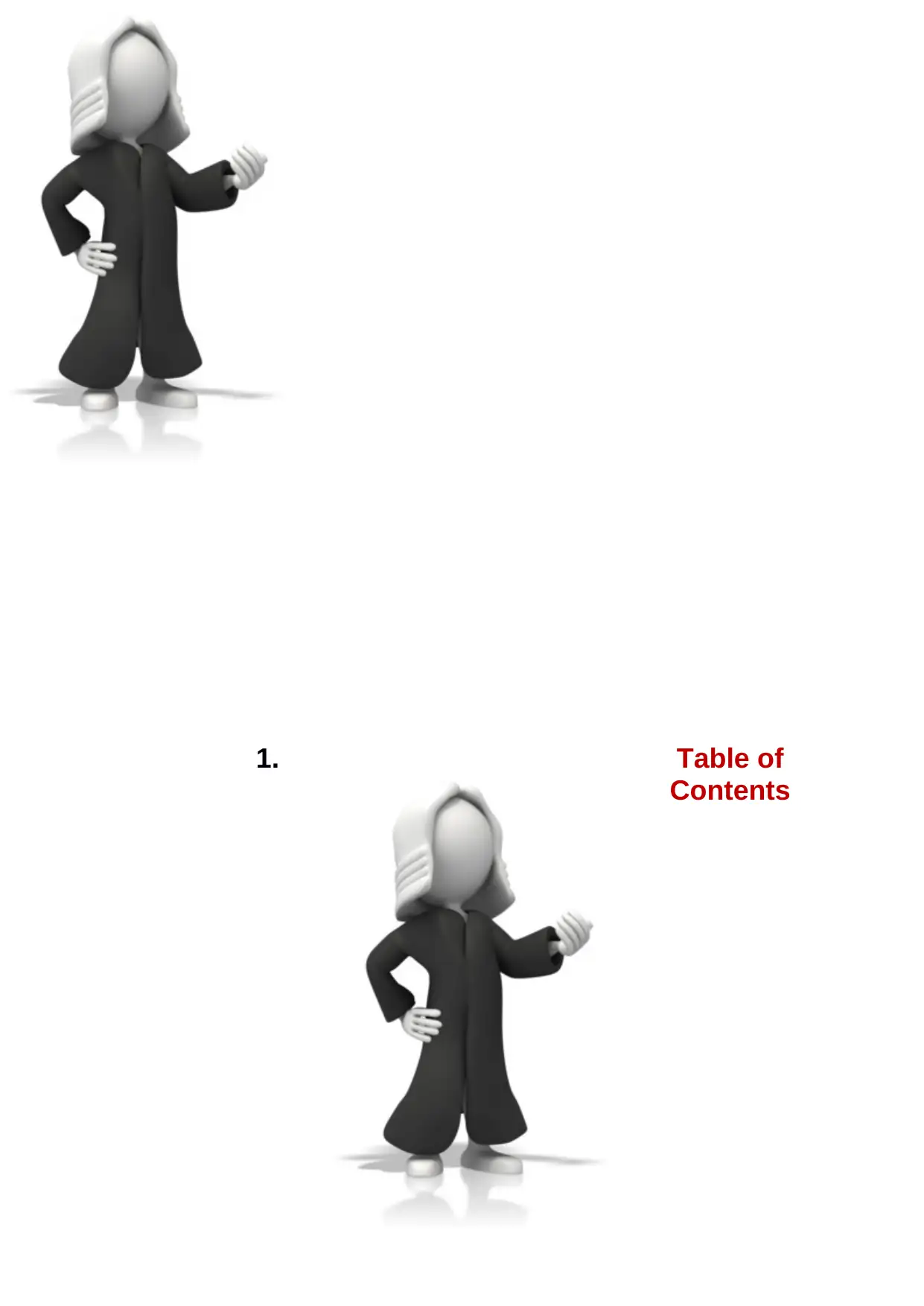
1. Table of
Contents
Contents
Secure Best Marks with AI Grader
Need help grading? Try our AI Grader for instant feedback on your assignments.
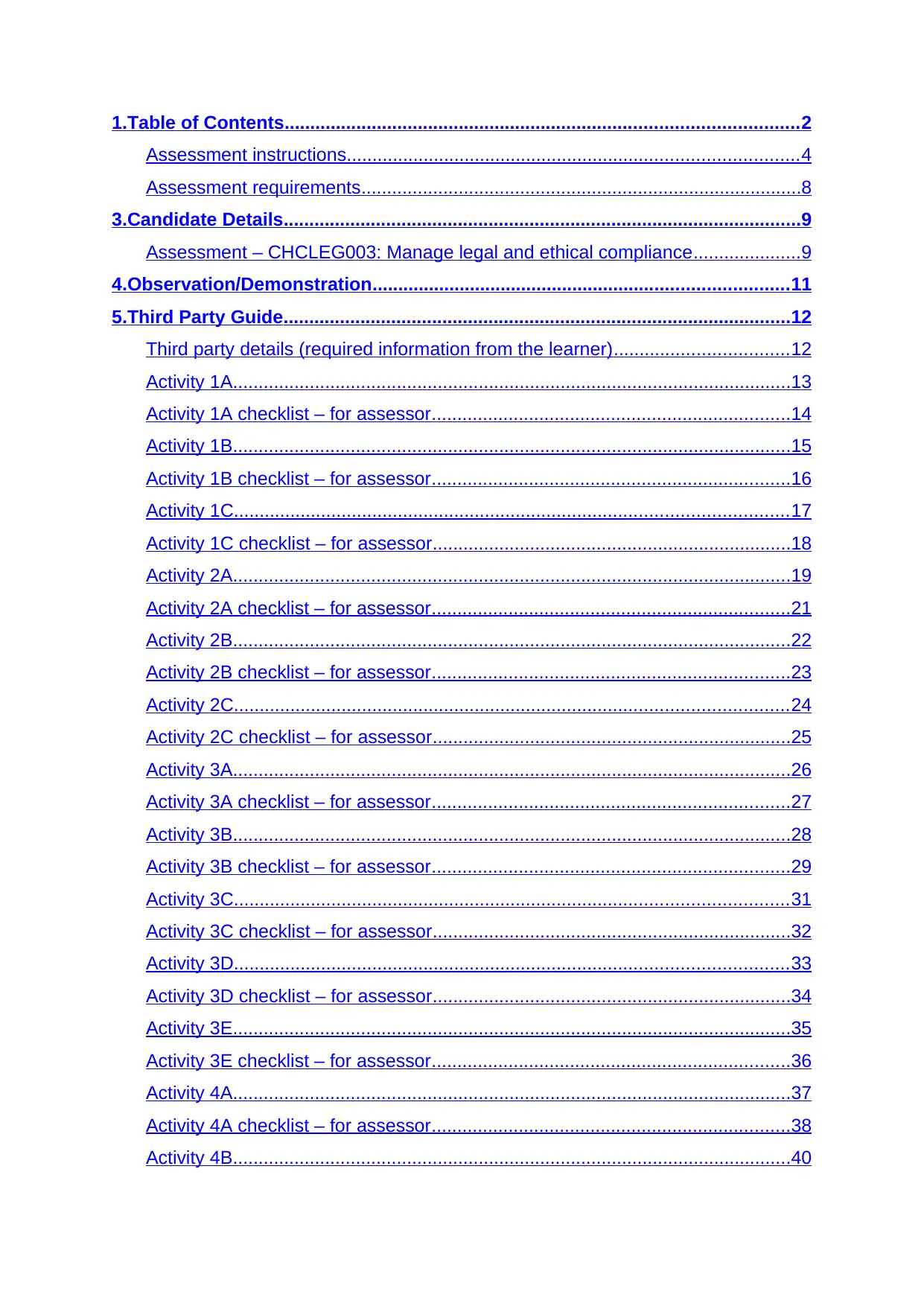
1.Table of Contents....................................................................................................2
Assessment instructions........................................................................................4
Assessment requirements......................................................................................8
3.Candidate Details.....................................................................................................9
Assessment – CHCLEG003: Manage legal and ethical compliance.....................9
4.Observation/Demonstration.................................................................................11
5.Third Party Guide...................................................................................................12
Third party details (required information from the learner)..................................12
Activity 1A.............................................................................................................13
Activity 1A checklist – for assessor......................................................................14
Activity 1B.............................................................................................................15
Activity 1B checklist – for assessor......................................................................16
Activity 1C............................................................................................................17
Activity 1C checklist – for assessor......................................................................18
Activity 2A.............................................................................................................19
Activity 2A checklist – for assessor......................................................................21
Activity 2B.............................................................................................................22
Activity 2B checklist – for assessor......................................................................23
Activity 2C............................................................................................................24
Activity 2C checklist – for assessor......................................................................25
Activity 3A.............................................................................................................26
Activity 3A checklist – for assessor......................................................................27
Activity 3B.............................................................................................................28
Activity 3B checklist – for assessor......................................................................29
Activity 3C............................................................................................................31
Activity 3C checklist – for assessor......................................................................32
Activity 3D............................................................................................................33
Activity 3D checklist – for assessor......................................................................34
Activity 3E.............................................................................................................35
Activity 3E checklist – for assessor......................................................................36
Activity 4A.............................................................................................................37
Activity 4A checklist – for assessor......................................................................38
Activity 4B.............................................................................................................40
Assessment instructions........................................................................................4
Assessment requirements......................................................................................8
3.Candidate Details.....................................................................................................9
Assessment – CHCLEG003: Manage legal and ethical compliance.....................9
4.Observation/Demonstration.................................................................................11
5.Third Party Guide...................................................................................................12
Third party details (required information from the learner)..................................12
Activity 1A.............................................................................................................13
Activity 1A checklist – for assessor......................................................................14
Activity 1B.............................................................................................................15
Activity 1B checklist – for assessor......................................................................16
Activity 1C............................................................................................................17
Activity 1C checklist – for assessor......................................................................18
Activity 2A.............................................................................................................19
Activity 2A checklist – for assessor......................................................................21
Activity 2B.............................................................................................................22
Activity 2B checklist – for assessor......................................................................23
Activity 2C............................................................................................................24
Activity 2C checklist – for assessor......................................................................25
Activity 3A.............................................................................................................26
Activity 3A checklist – for assessor......................................................................27
Activity 3B.............................................................................................................28
Activity 3B checklist – for assessor......................................................................29
Activity 3C............................................................................................................31
Activity 3C checklist – for assessor......................................................................32
Activity 3D............................................................................................................33
Activity 3D checklist – for assessor......................................................................34
Activity 3E.............................................................................................................35
Activity 3E checklist – for assessor......................................................................36
Activity 4A.............................................................................................................37
Activity 4A checklist – for assessor......................................................................38
Activity 4B.............................................................................................................40
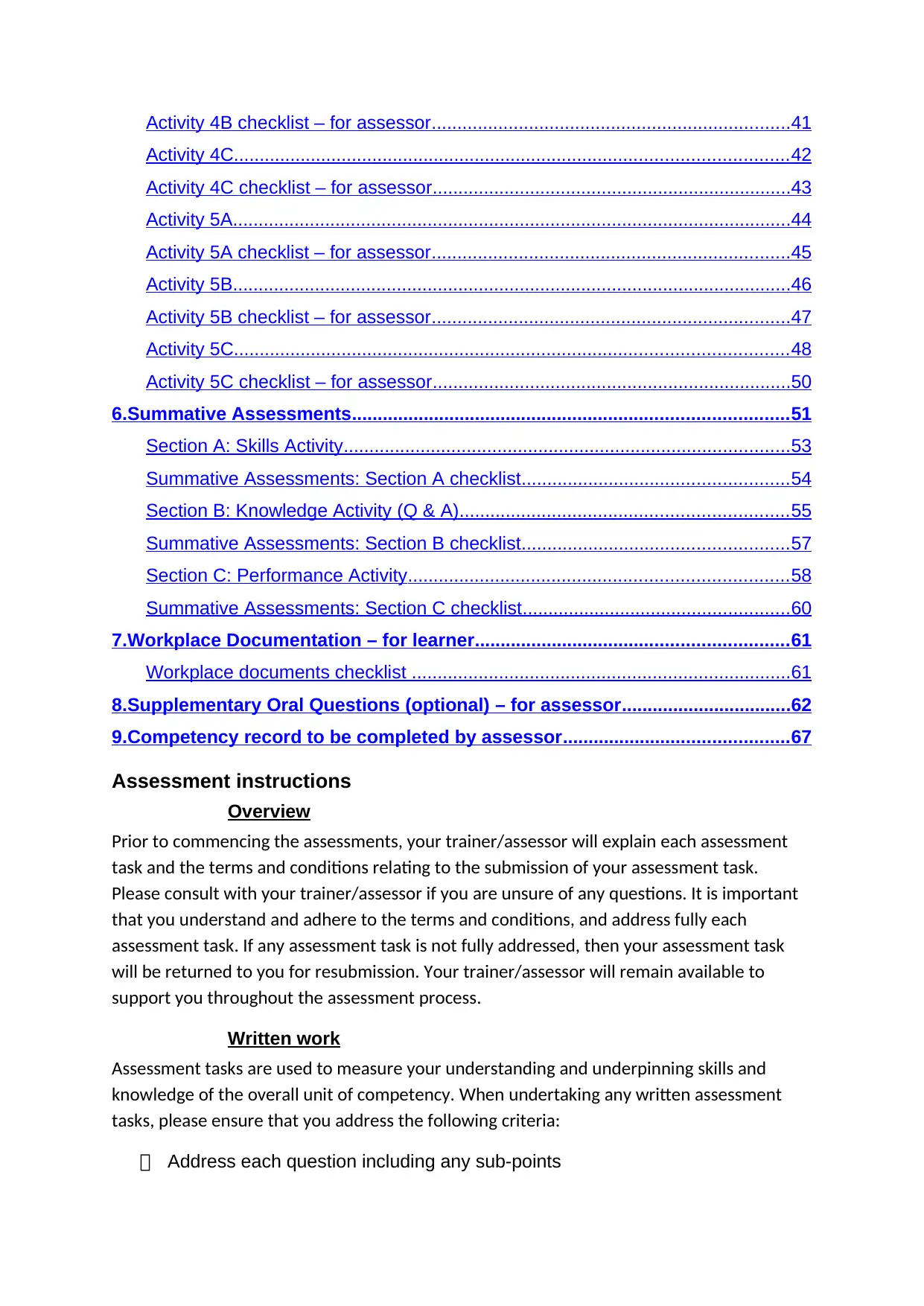
Activity 4B checklist – for assessor......................................................................41
Activity 4C............................................................................................................42
Activity 4C checklist – for assessor......................................................................43
Activity 5A.............................................................................................................44
Activity 5A checklist – for assessor......................................................................45
Activity 5B.............................................................................................................46
Activity 5B checklist – for assessor......................................................................47
Activity 5C............................................................................................................48
Activity 5C checklist – for assessor......................................................................50
6.Summative Assessments.....................................................................................51
Section A: Skills Activity.......................................................................................53
Summative Assessments: Section A checklist....................................................54
Section B: Knowledge Activity (Q & A)................................................................55
Summative Assessments: Section B checklist....................................................57
Section C: Performance Activity..........................................................................58
Summative Assessments: Section C checklist....................................................60
7.Workplace Documentation – for learner.............................................................61
Workplace documents checklist ..........................................................................61
8.Supplementary Oral Questions (optional) – for assessor.................................62
9.Competency record to be completed by assessor............................................67
Assessment instructions
Overview
Prior to commencing the assessments, your trainer/assessor will explain each assessment
task and the terms and conditions relating to the submission of your assessment task.
Please consult with your trainer/assessor if you are unsure of any questions. It is important
that you understand and adhere to the terms and conditions, and address fully each
assessment task. If any assessment task is not fully addressed, then your assessment task
will be returned to you for resubmission. Your trainer/assessor will remain available to
support you throughout the assessment process.
Written work
Assessment tasks are used to measure your understanding and underpinning skills and
knowledge of the overall unit of competency. When undertaking any written assessment
tasks, please ensure that you address the following criteria:
Address each question including any sub-points
Activity 4C............................................................................................................42
Activity 4C checklist – for assessor......................................................................43
Activity 5A.............................................................................................................44
Activity 5A checklist – for assessor......................................................................45
Activity 5B.............................................................................................................46
Activity 5B checklist – for assessor......................................................................47
Activity 5C............................................................................................................48
Activity 5C checklist – for assessor......................................................................50
6.Summative Assessments.....................................................................................51
Section A: Skills Activity.......................................................................................53
Summative Assessments: Section A checklist....................................................54
Section B: Knowledge Activity (Q & A)................................................................55
Summative Assessments: Section B checklist....................................................57
Section C: Performance Activity..........................................................................58
Summative Assessments: Section C checklist....................................................60
7.Workplace Documentation – for learner.............................................................61
Workplace documents checklist ..........................................................................61
8.Supplementary Oral Questions (optional) – for assessor.................................62
9.Competency record to be completed by assessor............................................67
Assessment instructions
Overview
Prior to commencing the assessments, your trainer/assessor will explain each assessment
task and the terms and conditions relating to the submission of your assessment task.
Please consult with your trainer/assessor if you are unsure of any questions. It is important
that you understand and adhere to the terms and conditions, and address fully each
assessment task. If any assessment task is not fully addressed, then your assessment task
will be returned to you for resubmission. Your trainer/assessor will remain available to
support you throughout the assessment process.
Written work
Assessment tasks are used to measure your understanding and underpinning skills and
knowledge of the overall unit of competency. When undertaking any written assessment
tasks, please ensure that you address the following criteria:
Address each question including any sub-points
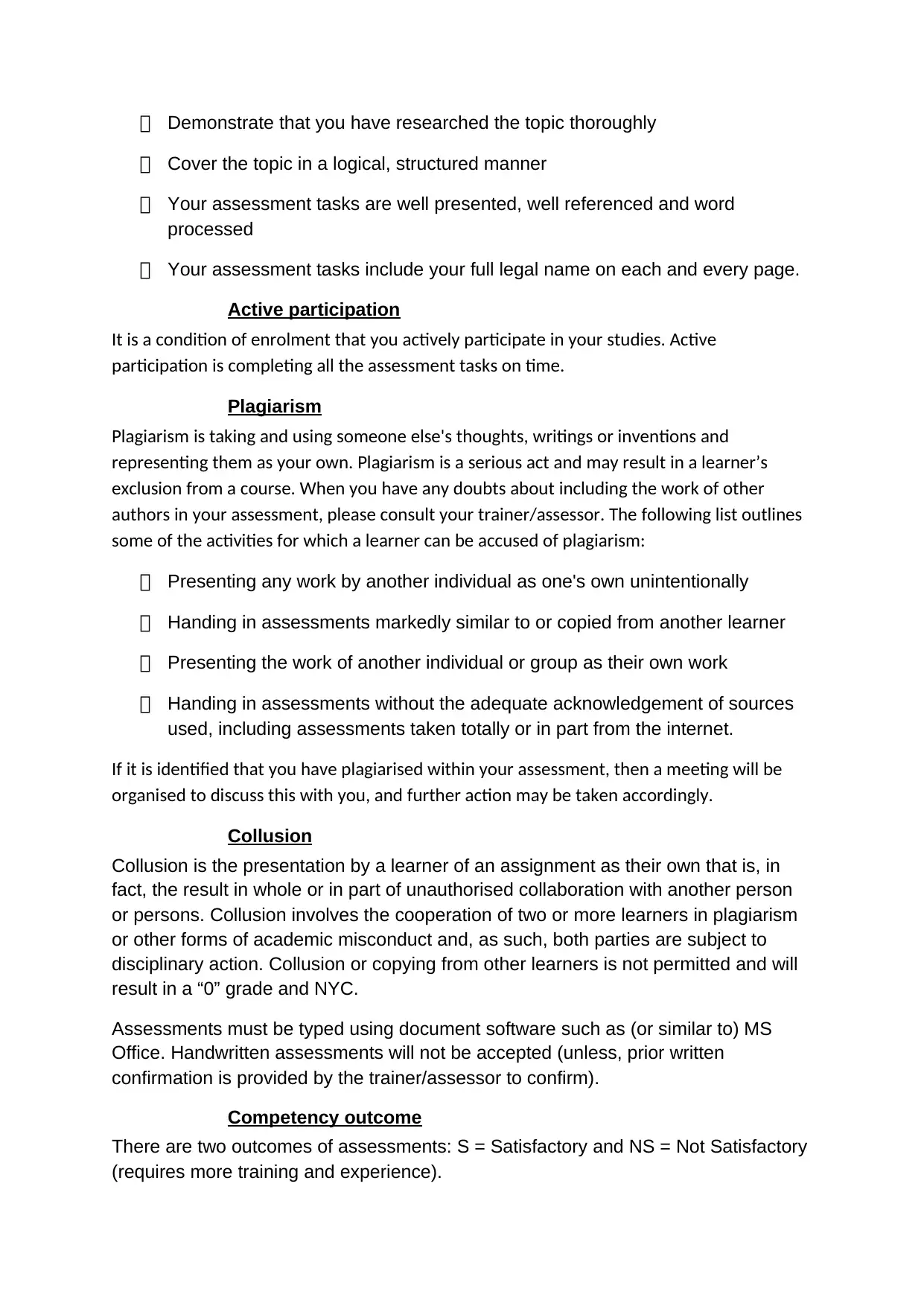
Demonstrate that you have researched the topic thoroughly
Cover the topic in a logical, structured manner
Your assessment tasks are well presented, well referenced and word
processed
Your assessment tasks include your full legal name on each and every page.
Active participation
It is a condition of enrolment that you actively participate in your studies. Active
participation is completing all the assessment tasks on time.
Plagiarism
Plagiarism is taking and using someone else's thoughts, writings or inventions and
representing them as your own. Plagiarism is a serious act and may result in a learner’s
exclusion from a course. When you have any doubts about including the work of other
authors in your assessment, please consult your trainer/assessor. The following list outlines
some of the activities for which a learner can be accused of plagiarism:
Presenting any work by another individual as one's own unintentionally
Handing in assessments markedly similar to or copied from another learner
Presenting the work of another individual or group as their own work
Handing in assessments without the adequate acknowledgement of sources
used, including assessments taken totally or in part from the internet.
If it is identified that you have plagiarised within your assessment, then a meeting will be
organised to discuss this with you, and further action may be taken accordingly.
Collusion
Collusion is the presentation by a learner of an assignment as their own that is, in
fact, the result in whole or in part of unauthorised collaboration with another person
or persons. Collusion involves the cooperation of two or more learners in plagiarism
or other forms of academic misconduct and, as such, both parties are subject to
disciplinary action. Collusion or copying from other learners is not permitted and will
result in a “0” grade and NYC.
Assessments must be typed using document software such as (or similar to) MS
Office. Handwritten assessments will not be accepted (unless, prior written
confirmation is provided by the trainer/assessor to confirm).
Competency outcome
There are two outcomes of assessments: S = Satisfactory and NS = Not Satisfactory
(requires more training and experience).
Cover the topic in a logical, structured manner
Your assessment tasks are well presented, well referenced and word
processed
Your assessment tasks include your full legal name on each and every page.
Active participation
It is a condition of enrolment that you actively participate in your studies. Active
participation is completing all the assessment tasks on time.
Plagiarism
Plagiarism is taking and using someone else's thoughts, writings or inventions and
representing them as your own. Plagiarism is a serious act and may result in a learner’s
exclusion from a course. When you have any doubts about including the work of other
authors in your assessment, please consult your trainer/assessor. The following list outlines
some of the activities for which a learner can be accused of plagiarism:
Presenting any work by another individual as one's own unintentionally
Handing in assessments markedly similar to or copied from another learner
Presenting the work of another individual or group as their own work
Handing in assessments without the adequate acknowledgement of sources
used, including assessments taken totally or in part from the internet.
If it is identified that you have plagiarised within your assessment, then a meeting will be
organised to discuss this with you, and further action may be taken accordingly.
Collusion
Collusion is the presentation by a learner of an assignment as their own that is, in
fact, the result in whole or in part of unauthorised collaboration with another person
or persons. Collusion involves the cooperation of two or more learners in plagiarism
or other forms of academic misconduct and, as such, both parties are subject to
disciplinary action. Collusion or copying from other learners is not permitted and will
result in a “0” grade and NYC.
Assessments must be typed using document software such as (or similar to) MS
Office. Handwritten assessments will not be accepted (unless, prior written
confirmation is provided by the trainer/assessor to confirm).
Competency outcome
There are two outcomes of assessments: S = Satisfactory and NS = Not Satisfactory
(requires more training and experience).
Secure Best Marks with AI Grader
Need help grading? Try our AI Grader for instant feedback on your assignments.
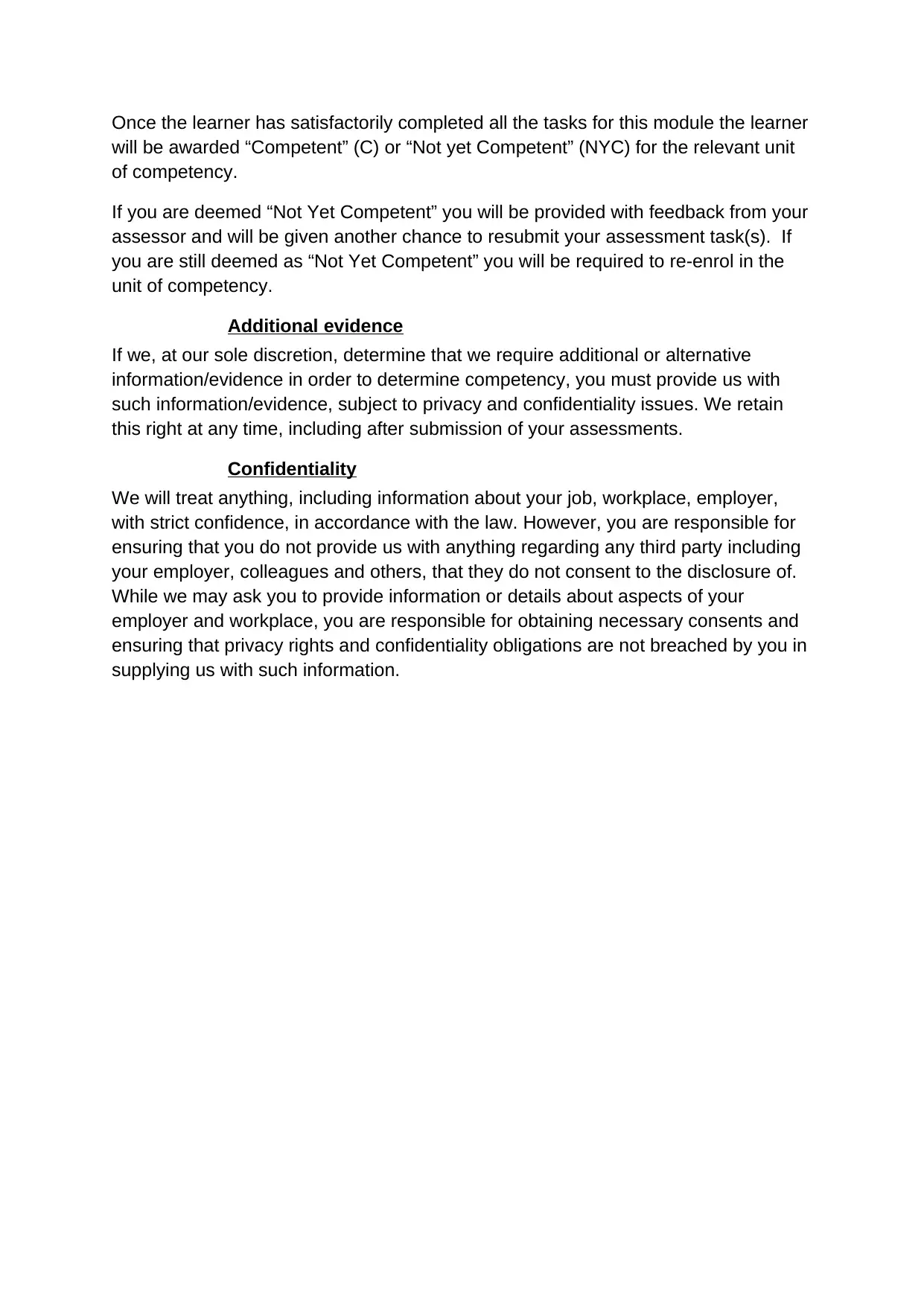
Once the learner has satisfactorily completed all the tasks for this module the learner
will be awarded “Competent” (C) or “Not yet Competent” (NYC) for the relevant unit
of competency.
If you are deemed “Not Yet Competent” you will be provided with feedback from your
assessor and will be given another chance to resubmit your assessment task(s). If
you are still deemed as “Not Yet Competent” you will be required to re-enrol in the
unit of competency.
Additional evidence
If we, at our sole discretion, determine that we require additional or alternative
information/evidence in order to determine competency, you must provide us with
such information/evidence, subject to privacy and confidentiality issues. We retain
this right at any time, including after submission of your assessments.
Confidentiality
We will treat anything, including information about your job, workplace, employer,
with strict confidence, in accordance with the law. However, you are responsible for
ensuring that you do not provide us with anything regarding any third party including
your employer, colleagues and others, that they do not consent to the disclosure of.
While we may ask you to provide information or details about aspects of your
employer and workplace, you are responsible for obtaining necessary consents and
ensuring that privacy rights and confidentiality obligations are not breached by you in
supplying us with such information.
will be awarded “Competent” (C) or “Not yet Competent” (NYC) for the relevant unit
of competency.
If you are deemed “Not Yet Competent” you will be provided with feedback from your
assessor and will be given another chance to resubmit your assessment task(s). If
you are still deemed as “Not Yet Competent” you will be required to re-enrol in the
unit of competency.
Additional evidence
If we, at our sole discretion, determine that we require additional or alternative
information/evidence in order to determine competency, you must provide us with
such information/evidence, subject to privacy and confidentiality issues. We retain
this right at any time, including after submission of your assessments.
Confidentiality
We will treat anything, including information about your job, workplace, employer,
with strict confidence, in accordance with the law. However, you are responsible for
ensuring that you do not provide us with anything regarding any third party including
your employer, colleagues and others, that they do not consent to the disclosure of.
While we may ask you to provide information or details about aspects of your
employer and workplace, you are responsible for obtaining necessary consents and
ensuring that privacy rights and confidentiality obligations are not breached by you in
supplying us with such information.
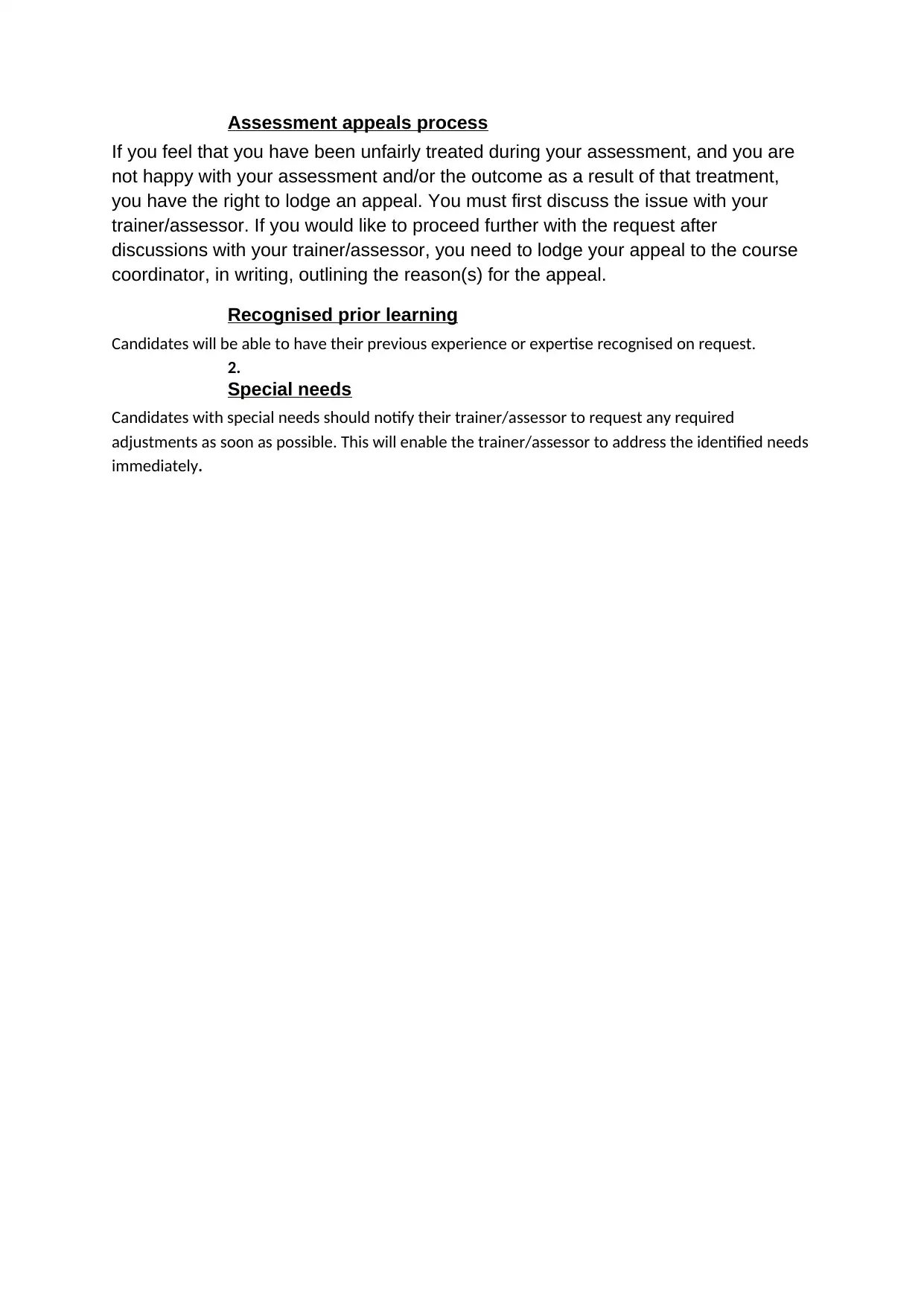
Assessment appeals process
If you feel that you have been unfairly treated during your assessment, and you are
not happy with your assessment and/or the outcome as a result of that treatment,
you have the right to lodge an appeal. You must first discuss the issue with your
trainer/assessor. If you would like to proceed further with the request after
discussions with your trainer/assessor, you need to lodge your appeal to the course
coordinator, in writing, outlining the reason(s) for the appeal.
Recognised prior learning
Candidates will be able to have their previous experience or expertise recognised on request.
2.
Special needs
Candidates with special needs should notify their trainer/assessor to request any required
adjustments as soon as possible. This will enable the trainer/assessor to address the identified needs
immediately .
If you feel that you have been unfairly treated during your assessment, and you are
not happy with your assessment and/or the outcome as a result of that treatment,
you have the right to lodge an appeal. You must first discuss the issue with your
trainer/assessor. If you would like to proceed further with the request after
discussions with your trainer/assessor, you need to lodge your appeal to the course
coordinator, in writing, outlining the reason(s) for the appeal.
Recognised prior learning
Candidates will be able to have their previous experience or expertise recognised on request.
2.
Special needs
Candidates with special needs should notify their trainer/assessor to request any required
adjustments as soon as possible. This will enable the trainer/assessor to address the identified needs
immediately .
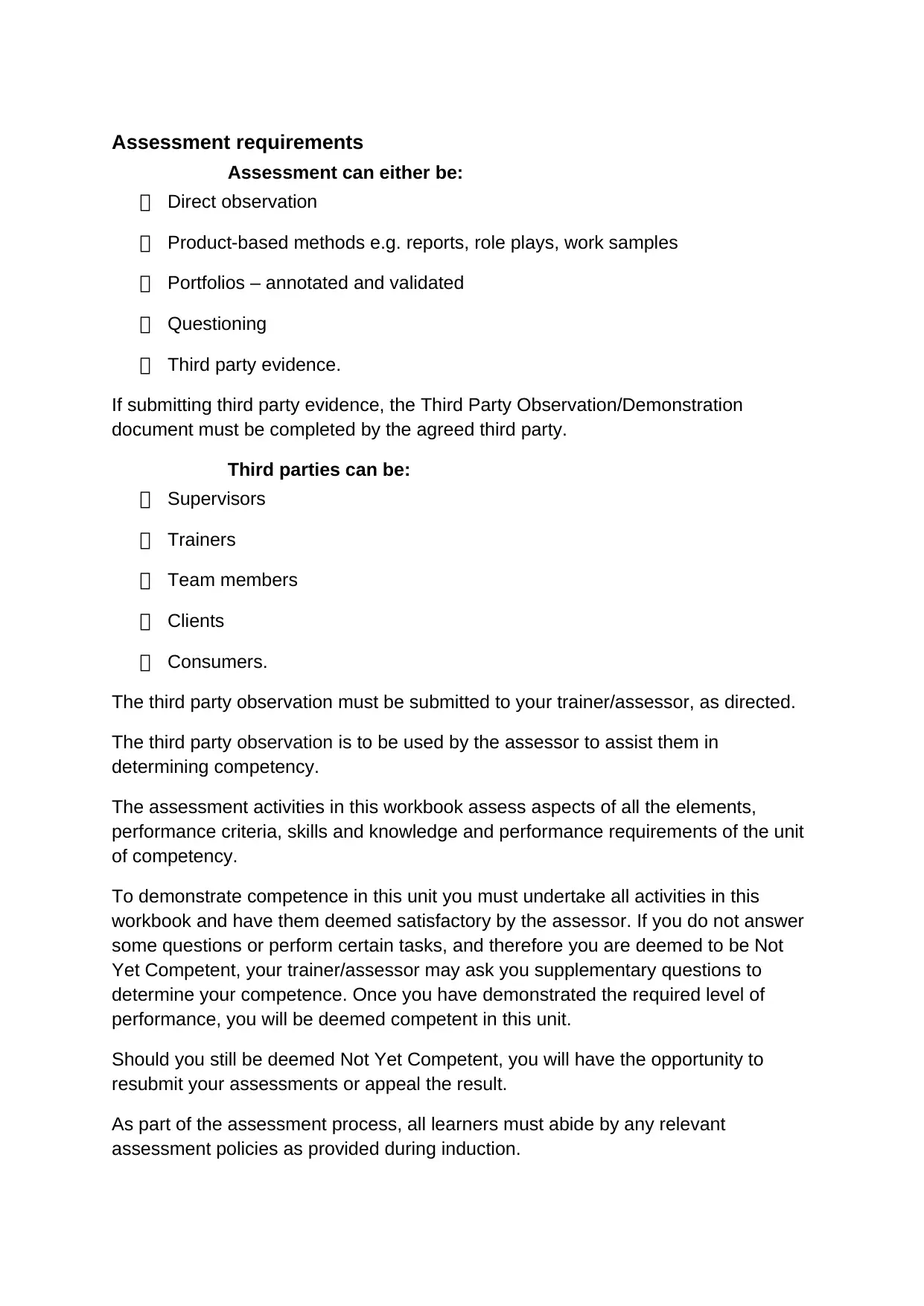
Assessment requirements
Assessment can either be:
Direct observation
Product-based methods e.g. reports, role plays, work samples
Portfolios – annotated and validated
Questioning
Third party evidence.
If submitting third party evidence, the Third Party Observation/Demonstration
document must be completed by the agreed third party.
Third parties can be:
Supervisors
Trainers
Team members
Clients
Consumers.
The third party observation must be submitted to your trainer/assessor, as directed.
The third party observation is to be used by the assessor to assist them in
determining competency.
The assessment activities in this workbook assess aspects of all the elements,
performance criteria, skills and knowledge and performance requirements of the unit
of competency.
To demonstrate competence in this unit you must undertake all activities in this
workbook and have them deemed satisfactory by the assessor. If you do not answer
some questions or perform certain tasks, and therefore you are deemed to be Not
Yet Competent, your trainer/assessor may ask you supplementary questions to
determine your competence. Once you have demonstrated the required level of
performance, you will be deemed competent in this unit.
Should you still be deemed Not Yet Competent, you will have the opportunity to
resubmit your assessments or appeal the result.
As part of the assessment process, all learners must abide by any relevant
assessment policies as provided during induction.
Assessment can either be:
Direct observation
Product-based methods e.g. reports, role plays, work samples
Portfolios – annotated and validated
Questioning
Third party evidence.
If submitting third party evidence, the Third Party Observation/Demonstration
document must be completed by the agreed third party.
Third parties can be:
Supervisors
Trainers
Team members
Clients
Consumers.
The third party observation must be submitted to your trainer/assessor, as directed.
The third party observation is to be used by the assessor to assist them in
determining competency.
The assessment activities in this workbook assess aspects of all the elements,
performance criteria, skills and knowledge and performance requirements of the unit
of competency.
To demonstrate competence in this unit you must undertake all activities in this
workbook and have them deemed satisfactory by the assessor. If you do not answer
some questions or perform certain tasks, and therefore you are deemed to be Not
Yet Competent, your trainer/assessor may ask you supplementary questions to
determine your competence. Once you have demonstrated the required level of
performance, you will be deemed competent in this unit.
Should you still be deemed Not Yet Competent, you will have the opportunity to
resubmit your assessments or appeal the result.
As part of the assessment process, all learners must abide by any relevant
assessment policies as provided during induction.
Paraphrase This Document
Need a fresh take? Get an instant paraphrase of this document with our AI Paraphraser
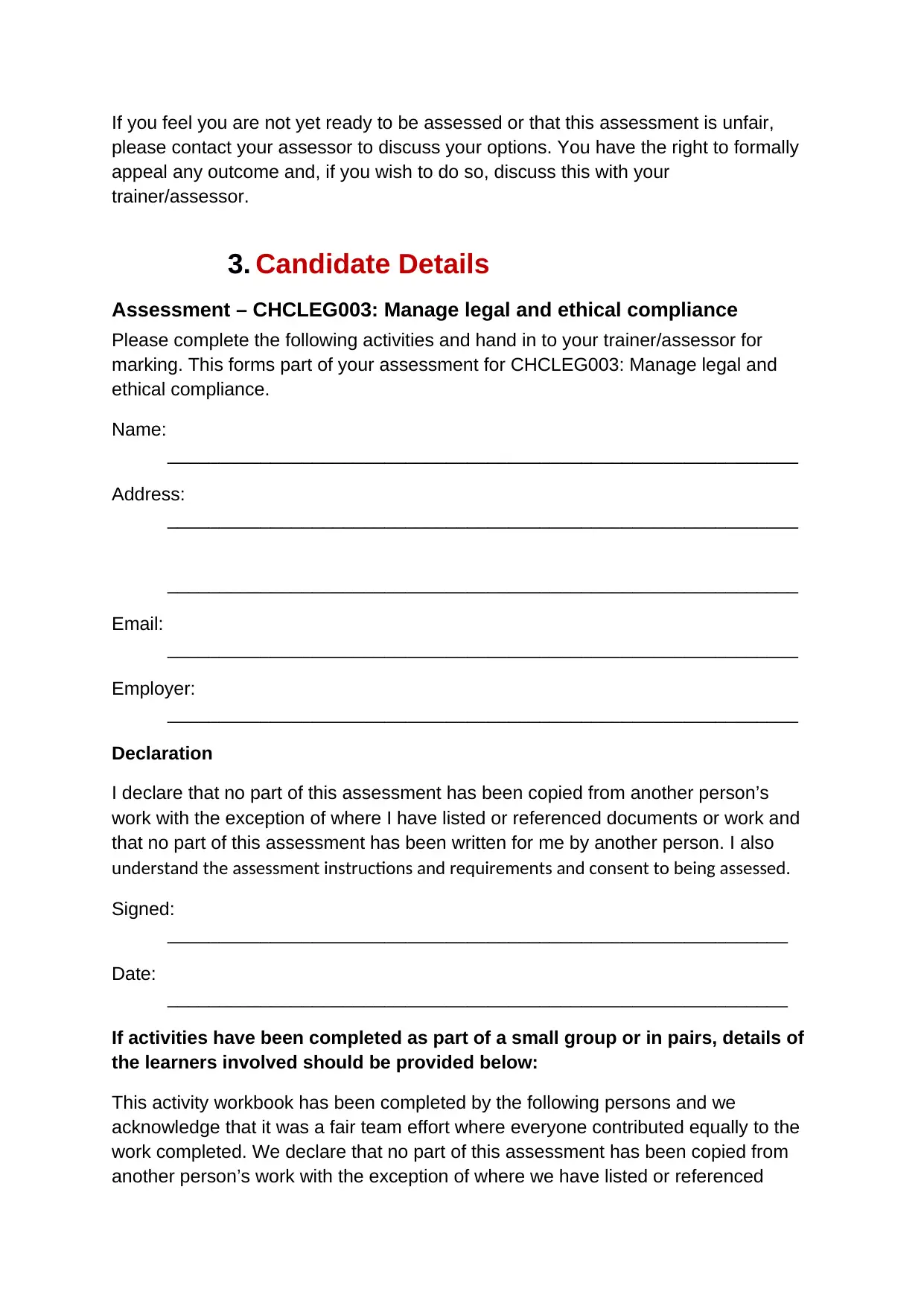
If you feel you are not yet ready to be assessed or that this assessment is unfair,
please contact your assessor to discuss your options. You have the right to formally
appeal any outcome and, if you wish to do so, discuss this with your
trainer/assessor.
3. Candidate Details
Assessment – CHCLEG003: Manage legal and ethical compliance
Please complete the following activities and hand in to your trainer/assessor for
marking. This forms part of your assessment for CHCLEG003: Manage legal and
ethical compliance.
Name:
_____________________________________________________________
Address:
_____________________________________________________________
_____________________________________________________________
Email:
_____________________________________________________________
Employer:
_____________________________________________________________
Declaration
I declare that no part of this assessment has been copied from another person’s
work with the exception of where I have listed or referenced documents or work and
that no part of this assessment has been written for me by another person. I also
understand the assessment instructions and requirements and consent to being assessed.
Signed:
____________________________________________________________
Date:
____________________________________________________________
If activities have been completed as part of a small group or in pairs, details of
the learners involved should be provided below:
This activity workbook has been completed by the following persons and we
acknowledge that it was a fair team effort where everyone contributed equally to the
work completed. We declare that no part of this assessment has been copied from
another person’s work with the exception of where we have listed or referenced
please contact your assessor to discuss your options. You have the right to formally
appeal any outcome and, if you wish to do so, discuss this with your
trainer/assessor.
3. Candidate Details
Assessment – CHCLEG003: Manage legal and ethical compliance
Please complete the following activities and hand in to your trainer/assessor for
marking. This forms part of your assessment for CHCLEG003: Manage legal and
ethical compliance.
Name:
_____________________________________________________________
Address:
_____________________________________________________________
_____________________________________________________________
Email:
_____________________________________________________________
Employer:
_____________________________________________________________
Declaration
I declare that no part of this assessment has been copied from another person’s
work with the exception of where I have listed or referenced documents or work and
that no part of this assessment has been written for me by another person. I also
understand the assessment instructions and requirements and consent to being assessed.
Signed:
____________________________________________________________
Date:
____________________________________________________________
If activities have been completed as part of a small group or in pairs, details of
the learners involved should be provided below:
This activity workbook has been completed by the following persons and we
acknowledge that it was a fair team effort where everyone contributed equally to the
work completed. We declare that no part of this assessment has been copied from
another person’s work with the exception of where we have listed or referenced
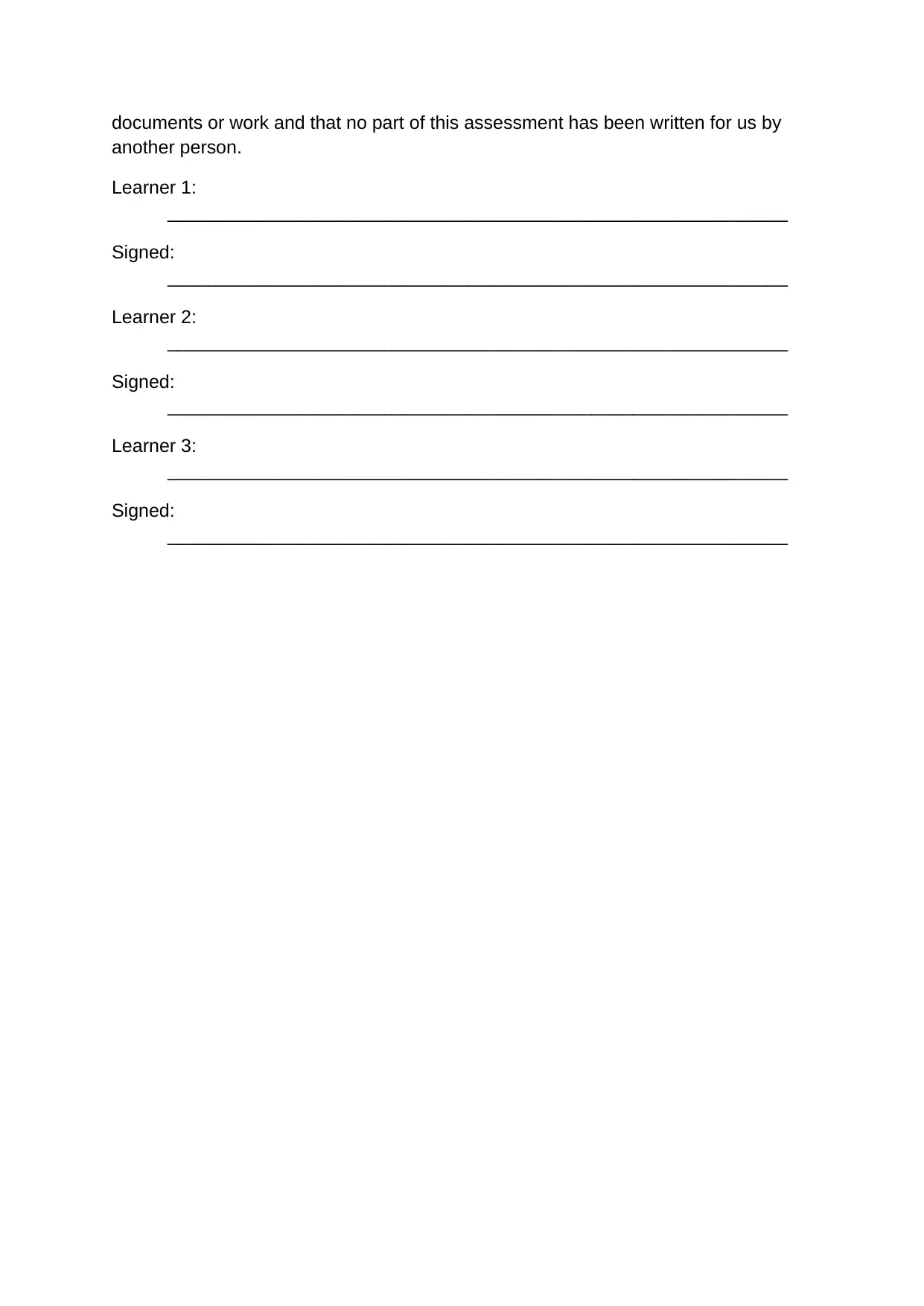
documents or work and that no part of this assessment has been written for us by
another person.
Learner 1:
____________________________________________________________
Signed:
____________________________________________________________
Learner 2:
____________________________________________________________
Signed:
____________________________________________________________
Learner 3:
____________________________________________________________
Signed:
____________________________________________________________
another person.
Learner 1:
____________________________________________________________
Signed:
____________________________________________________________
Learner 2:
____________________________________________________________
Signed:
____________________________________________________________
Learner 3:
____________________________________________________________
Signed:
____________________________________________________________

4. Observation/Demonstration
Throughout this unit, you will be expected to show your competency of the elements
through observations or demonstrations. Your trainer/assessor will have a list of
demonstrations you must complete or tasks to be observed. The observations and
demonstrations will be completed as well as the activities found in this workbook.
An explanation of observations and demonstrations:
Observation is on-the-job
The observation will usually require:
Performing a work based skill or task
Interaction with colleagues and/or customers.
Demonstration is off-the-job
A demonstration will require:
Performing a skill or task that is asked of you
Undertaking a simulation exercise.
Your trainer/assessor will inform you of which one of the above they
would like you to do. The observation/demonstration will cover one of
the unit’s elements.
The observation/demonstration will take place either in the workplace
or the training environment, depending on the task to be undertaken
and whether it is an observation or demonstration. Your
trainer/assessor will ensure you are provided with the correct
equipment and/or materials to complete the task. They will also inform
you of how long you have to complete the task.
You should be able to demonstrate the skills, knowledge and performance criteria required for
competency in this unit, as seen in the Learner Guide.
Throughout this unit, you will be expected to show your competency of the elements
through observations or demonstrations. Your trainer/assessor will have a list of
demonstrations you must complete or tasks to be observed. The observations and
demonstrations will be completed as well as the activities found in this workbook.
An explanation of observations and demonstrations:
Observation is on-the-job
The observation will usually require:
Performing a work based skill or task
Interaction with colleagues and/or customers.
Demonstration is off-the-job
A demonstration will require:
Performing a skill or task that is asked of you
Undertaking a simulation exercise.
Your trainer/assessor will inform you of which one of the above they
would like you to do. The observation/demonstration will cover one of
the unit’s elements.
The observation/demonstration will take place either in the workplace
or the training environment, depending on the task to be undertaken
and whether it is an observation or demonstration. Your
trainer/assessor will ensure you are provided with the correct
equipment and/or materials to complete the task. They will also inform
you of how long you have to complete the task.
You should be able to demonstrate the skills, knowledge and performance criteria required for
competency in this unit, as seen in the Learner Guide.
Secure Best Marks with AI Grader
Need help grading? Try our AI Grader for instant feedback on your assignments.
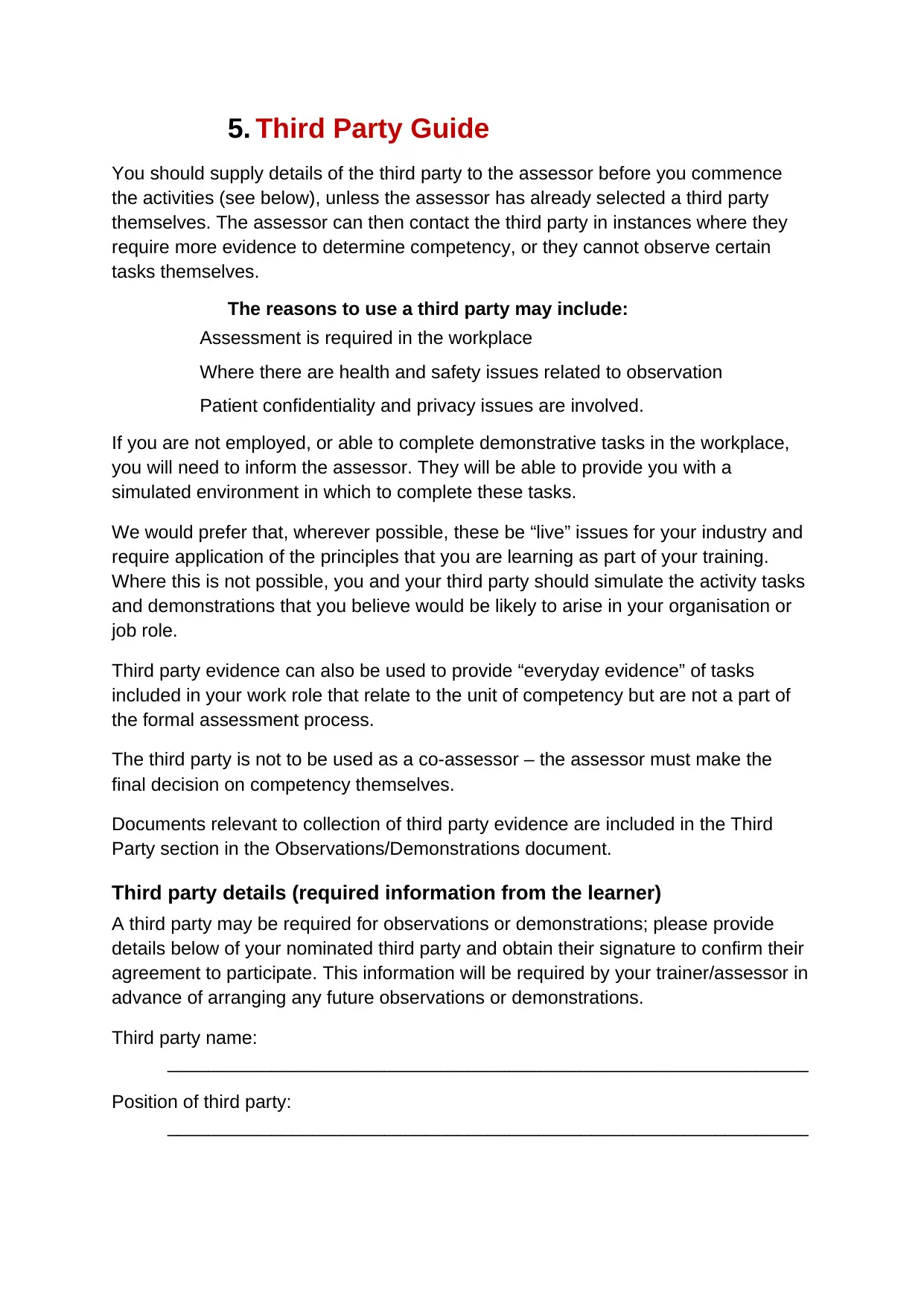
5. Third Party Guide
You should supply details of the third party to the assessor before you commence
the activities (see below), unless the assessor has already selected a third party
themselves. The assessor can then contact the third party in instances where they
require more evidence to determine competency, or they cannot observe certain
tasks themselves.
The reasons to use a third party may include:
Assessment is required in the workplace
Where there are health and safety issues related to observation
Patient confidentiality and privacy issues are involved.
If you are not employed, or able to complete demonstrative tasks in the workplace,
you will need to inform the assessor. They will be able to provide you with a
simulated environment in which to complete these tasks.
We would prefer that, wherever possible, these be “live” issues for your industry and
require application of the principles that you are learning as part of your training.
Where this is not possible, you and your third party should simulate the activity tasks
and demonstrations that you believe would be likely to arise in your organisation or
job role.
Third party evidence can also be used to provide “everyday evidence” of tasks
included in your work role that relate to the unit of competency but are not a part of
the formal assessment process.
The third party is not to be used as a co-assessor – the assessor must make the
final decision on competency themselves.
Documents relevant to collection of third party evidence are included in the Third
Party section in the Observations/Demonstrations document.
Third party details (required information from the learner)
A third party may be required for observations or demonstrations; please provide
details below of your nominated third party and obtain their signature to confirm their
agreement to participate. This information will be required by your trainer/assessor in
advance of arranging any future observations or demonstrations.
Third party name:
______________________________________________________________
Position of third party:
______________________________________________________________
You should supply details of the third party to the assessor before you commence
the activities (see below), unless the assessor has already selected a third party
themselves. The assessor can then contact the third party in instances where they
require more evidence to determine competency, or they cannot observe certain
tasks themselves.
The reasons to use a third party may include:
Assessment is required in the workplace
Where there are health and safety issues related to observation
Patient confidentiality and privacy issues are involved.
If you are not employed, or able to complete demonstrative tasks in the workplace,
you will need to inform the assessor. They will be able to provide you with a
simulated environment in which to complete these tasks.
We would prefer that, wherever possible, these be “live” issues for your industry and
require application of the principles that you are learning as part of your training.
Where this is not possible, you and your third party should simulate the activity tasks
and demonstrations that you believe would be likely to arise in your organisation or
job role.
Third party evidence can also be used to provide “everyday evidence” of tasks
included in your work role that relate to the unit of competency but are not a part of
the formal assessment process.
The third party is not to be used as a co-assessor – the assessor must make the
final decision on competency themselves.
Documents relevant to collection of third party evidence are included in the Third
Party section in the Observations/Demonstrations document.
Third party details (required information from the learner)
A third party may be required for observations or demonstrations; please provide
details below of your nominated third party and obtain their signature to confirm their
agreement to participate. This information will be required by your trainer/assessor in
advance of arranging any future observations or demonstrations.
Third party name:
______________________________________________________________
Position of third party:
______________________________________________________________
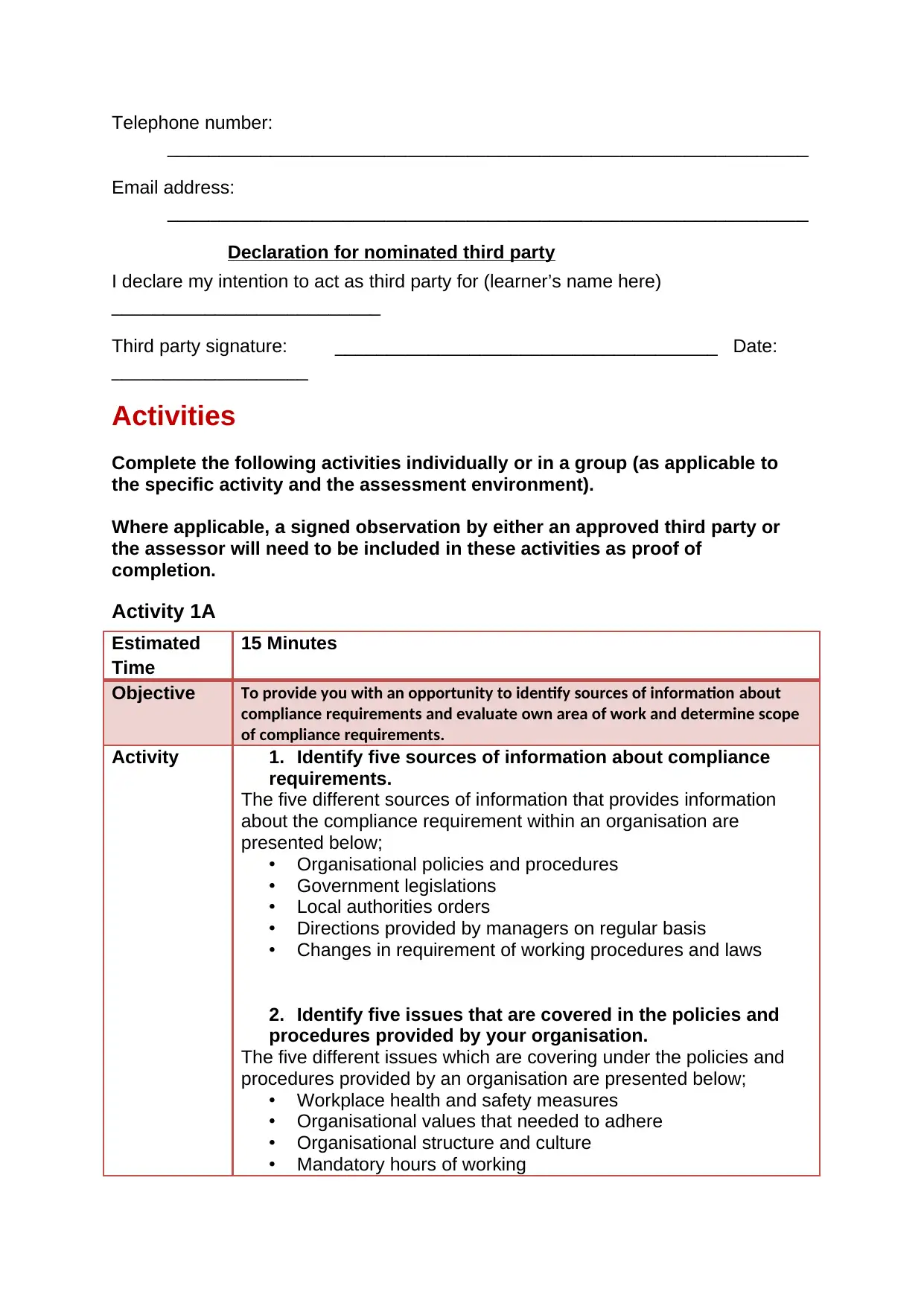
Telephone number:
______________________________________________________________
Email address:
______________________________________________________________
Declaration for nominated third party
I declare my intention to act as third party for (learner’s name here)
__________________________
Third party signature: _____________________________________ Date:
___________________
Activities
Complete the following activities individually or in a group (as applicable to
the specific activity and the assessment environment).
Where applicable, a signed observation by either an approved third party or
the assessor will need to be included in these activities as proof of
completion.
Activity 1A
Estimated
Time
15 Minutes
Objective To provide you with an opportunity to identify sources of information about
compliance requirements and evaluate own area of work and determine scope
of compliance requirements.
Activity 1. Identify five sources of information about compliance
requirements.
The five different sources of information that provides information
about the compliance requirement within an organisation are
presented below;
• Organisational policies and procedures
• Government legislations
• Local authorities orders
• Directions provided by managers on regular basis
• Changes in requirement of working procedures and laws
2. Identify five issues that are covered in the policies and
procedures provided by your organisation.
The five different issues which are covering under the policies and
procedures provided by an organisation are presented below;
• Workplace health and safety measures
• Organisational values that needed to adhere
• Organisational structure and culture
• Mandatory hours of working
______________________________________________________________
Email address:
______________________________________________________________
Declaration for nominated third party
I declare my intention to act as third party for (learner’s name here)
__________________________
Third party signature: _____________________________________ Date:
___________________
Activities
Complete the following activities individually or in a group (as applicable to
the specific activity and the assessment environment).
Where applicable, a signed observation by either an approved third party or
the assessor will need to be included in these activities as proof of
completion.
Activity 1A
Estimated
Time
15 Minutes
Objective To provide you with an opportunity to identify sources of information about
compliance requirements and evaluate own area of work and determine scope
of compliance requirements.
Activity 1. Identify five sources of information about compliance
requirements.
The five different sources of information that provides information
about the compliance requirement within an organisation are
presented below;
• Organisational policies and procedures
• Government legislations
• Local authorities orders
• Directions provided by managers on regular basis
• Changes in requirement of working procedures and laws
2. Identify five issues that are covered in the policies and
procedures provided by your organisation.
The five different issues which are covering under the policies and
procedures provided by an organisation are presented below;
• Workplace health and safety measures
• Organisational values that needed to adhere
• Organisational structure and culture
• Mandatory hours of working
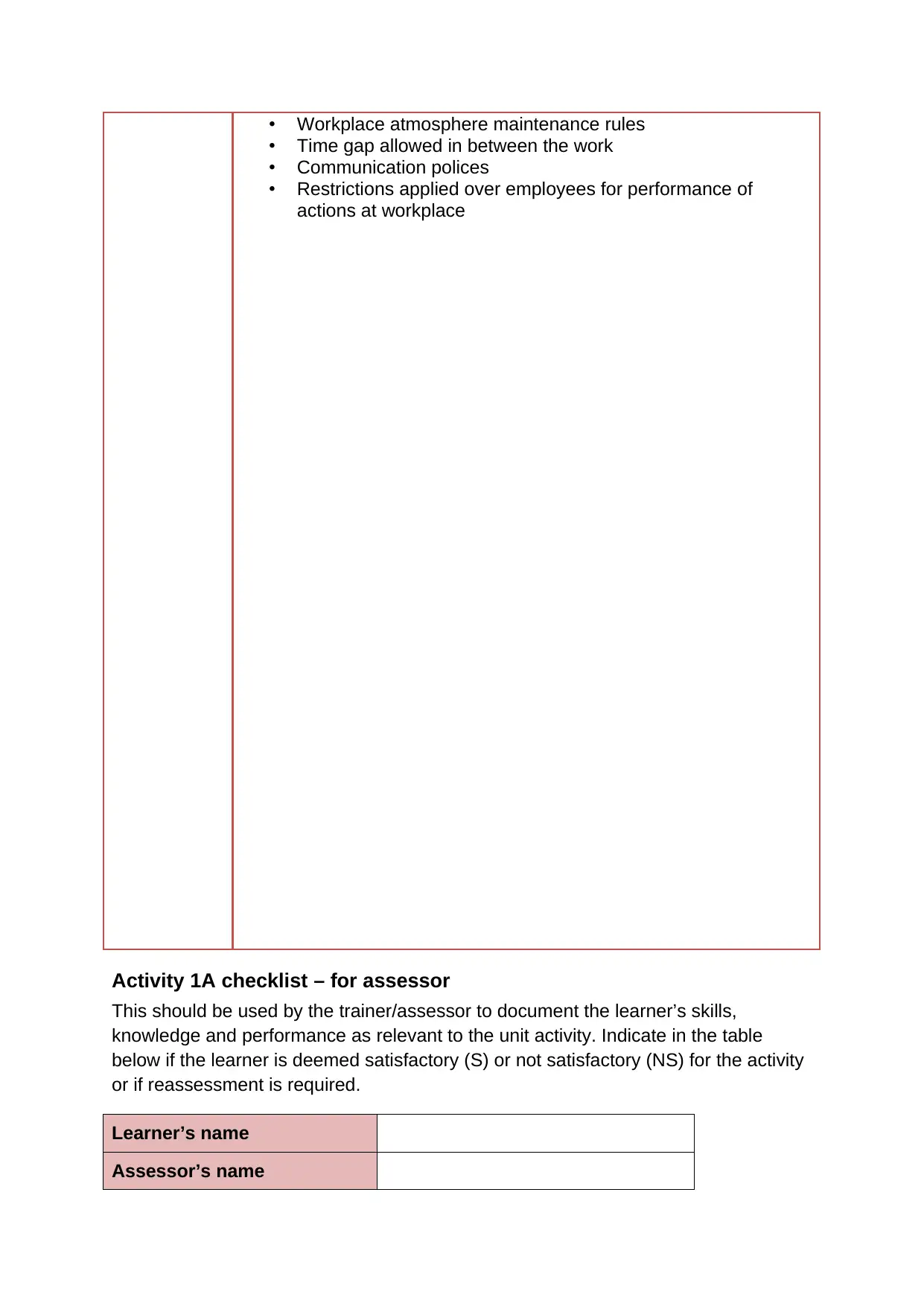
• Workplace atmosphere maintenance rules
• Time gap allowed in between the work
• Communication polices
• Restrictions applied over employees for performance of
actions at workplace
Activity 1A checklist – for assessor
This should be used by the trainer/assessor to document the learner’s skills,
knowledge and performance as relevant to the unit activity. Indicate in the table
below if the learner is deemed satisfactory (S) or not satisfactory (NS) for the activity
or if reassessment is required.
Learner’s name
Assessor’s name
• Time gap allowed in between the work
• Communication polices
• Restrictions applied over employees for performance of
actions at workplace
Activity 1A checklist – for assessor
This should be used by the trainer/assessor to document the learner’s skills,
knowledge and performance as relevant to the unit activity. Indicate in the table
below if the learner is deemed satisfactory (S) or not satisfactory (NS) for the activity
or if reassessment is required.
Learner’s name
Assessor’s name
Paraphrase This Document
Need a fresh take? Get an instant paraphrase of this document with our AI Paraphraser
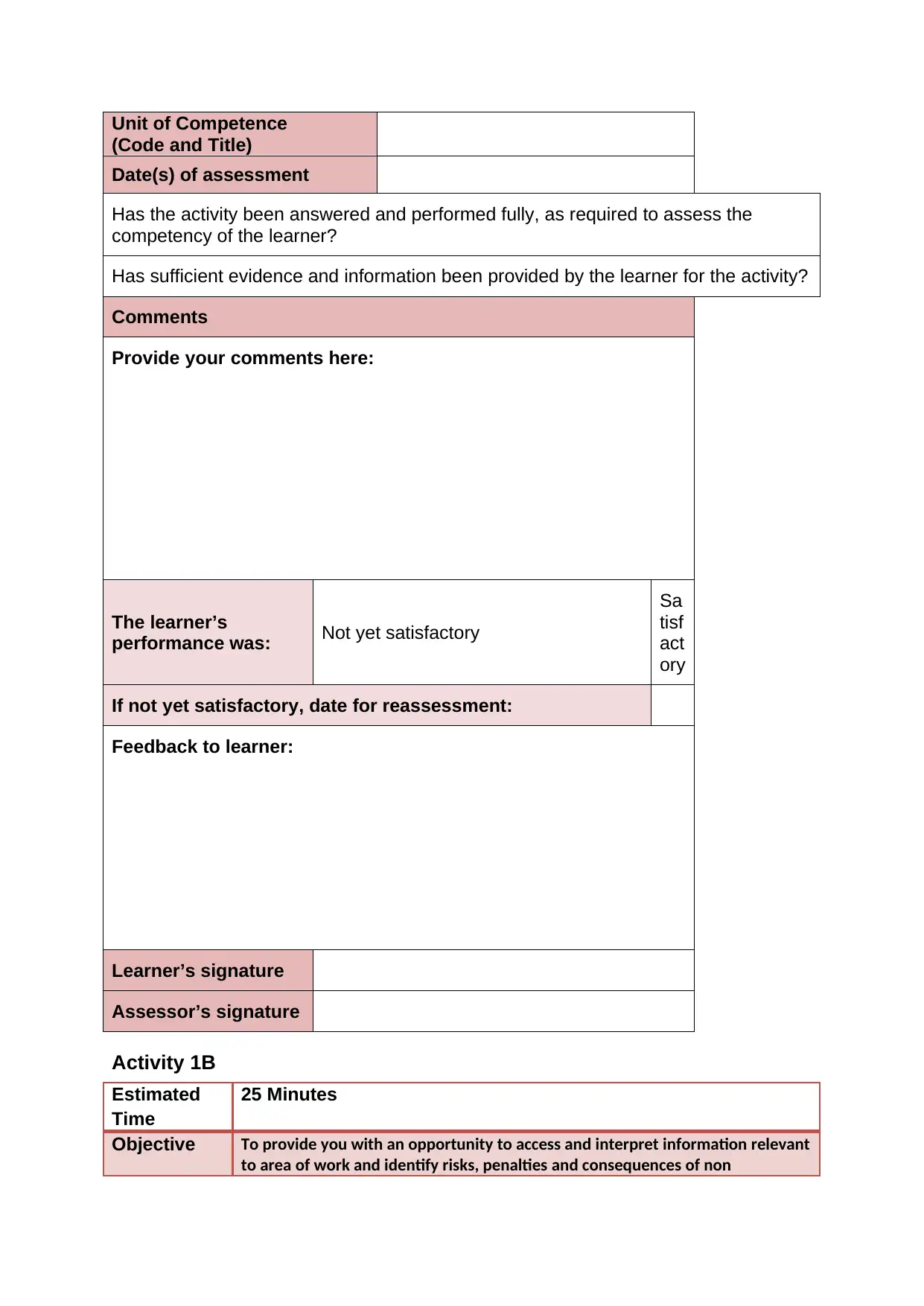
Unit of Competence
(Code and Title)
Date(s) of assessment
Has the activity been answered and performed fully, as required to assess the
competency of the learner?
Has sufficient evidence and information been provided by the learner for the activity?
Comments
Provide your comments here:
The learner’s
performance was: Not yet satisfactory
Sa
tisf
act
ory
If not yet satisfactory, date for reassessment:
Feedback to learner:
Learner’s signature
Assessor’s signature
Activity 1B
Estimated
Time
25 Minutes
Objective To provide you with an opportunity to access and interpret information relevant
to area of work and identify risks, penalties and consequences of non
(Code and Title)
Date(s) of assessment
Has the activity been answered and performed fully, as required to assess the
competency of the learner?
Has sufficient evidence and information been provided by the learner for the activity?
Comments
Provide your comments here:
The learner’s
performance was: Not yet satisfactory
Sa
tisf
act
ory
If not yet satisfactory, date for reassessment:
Feedback to learner:
Learner’s signature
Assessor’s signature
Activity 1B
Estimated
Time
25 Minutes
Objective To provide you with an opportunity to access and interpret information relevant
to area of work and identify risks, penalties and consequences of non
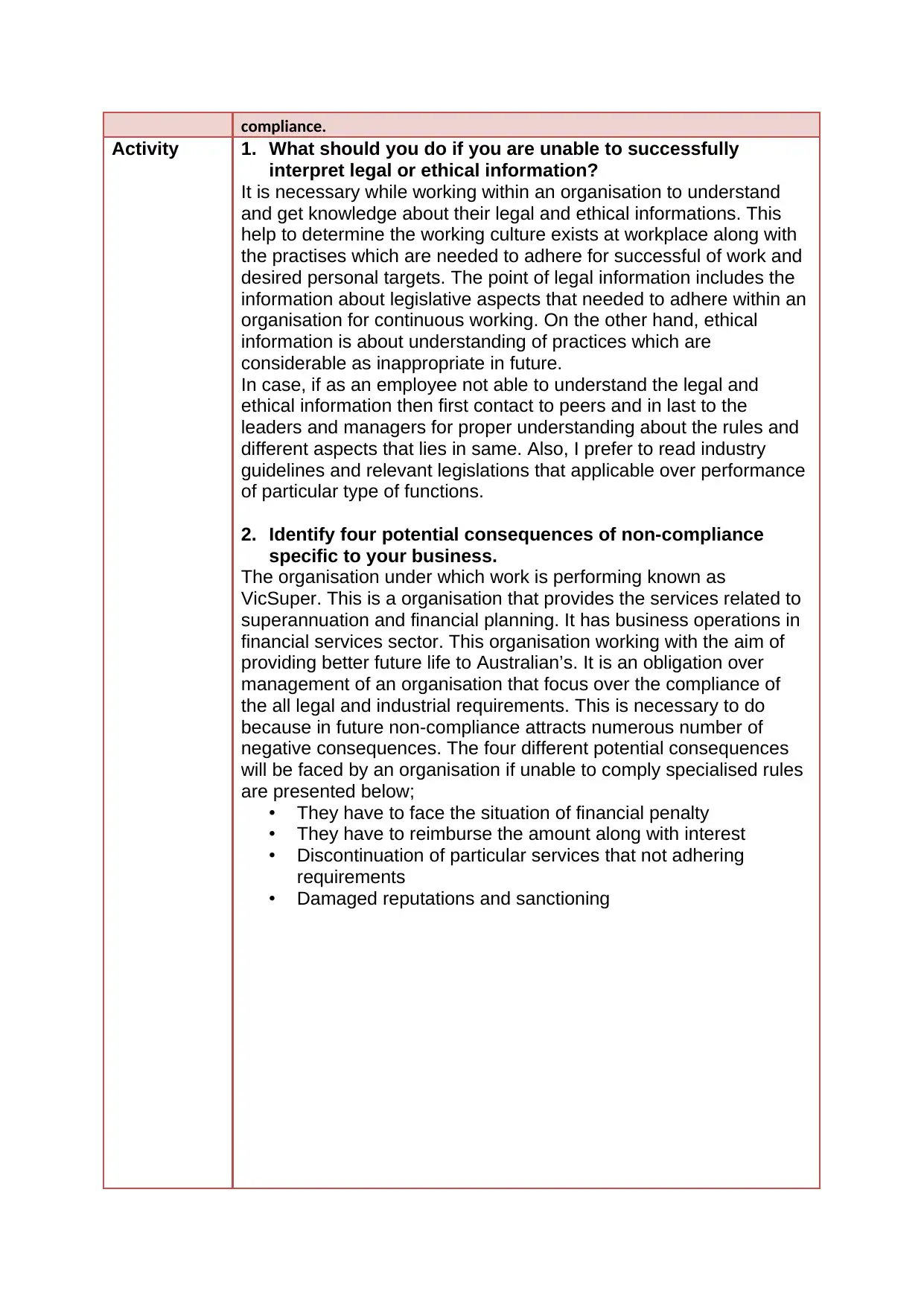
compliance.
Activity 1. What should you do if you are unable to successfully
interpret legal or ethical information?
It is necessary while working within an organisation to understand
and get knowledge about their legal and ethical informations. This
help to determine the working culture exists at workplace along with
the practises which are needed to adhere for successful of work and
desired personal targets. The point of legal information includes the
information about legislative aspects that needed to adhere within an
organisation for continuous working. On the other hand, ethical
information is about understanding of practices which are
considerable as inappropriate in future.
In case, if as an employee not able to understand the legal and
ethical information then first contact to peers and in last to the
leaders and managers for proper understanding about the rules and
different aspects that lies in same. Also, I prefer to read industry
guidelines and relevant legislations that applicable over performance
of particular type of functions.
2. Identify four potential consequences of non-compliance
specific to your business.
The organisation under which work is performing known as
VicSuper. This is a organisation that provides the services related to
superannuation and financial planning. It has business operations in
financial services sector. This organisation working with the aim of
providing better future life to Australian’s. It is an obligation over
management of an organisation that focus over the compliance of
the all legal and industrial requirements. This is necessary to do
because in future non-compliance attracts numerous number of
negative consequences. The four different potential consequences
will be faced by an organisation if unable to comply specialised rules
are presented below;
• They have to face the situation of financial penalty
• They have to reimburse the amount along with interest
• Discontinuation of particular services that not adhering
requirements
• Damaged reputations and sanctioning
Activity 1. What should you do if you are unable to successfully
interpret legal or ethical information?
It is necessary while working within an organisation to understand
and get knowledge about their legal and ethical informations. This
help to determine the working culture exists at workplace along with
the practises which are needed to adhere for successful of work and
desired personal targets. The point of legal information includes the
information about legislative aspects that needed to adhere within an
organisation for continuous working. On the other hand, ethical
information is about understanding of practices which are
considerable as inappropriate in future.
In case, if as an employee not able to understand the legal and
ethical information then first contact to peers and in last to the
leaders and managers for proper understanding about the rules and
different aspects that lies in same. Also, I prefer to read industry
guidelines and relevant legislations that applicable over performance
of particular type of functions.
2. Identify four potential consequences of non-compliance
specific to your business.
The organisation under which work is performing known as
VicSuper. This is a organisation that provides the services related to
superannuation and financial planning. It has business operations in
financial services sector. This organisation working with the aim of
providing better future life to Australian’s. It is an obligation over
management of an organisation that focus over the compliance of
the all legal and industrial requirements. This is necessary to do
because in future non-compliance attracts numerous number of
negative consequences. The four different potential consequences
will be faced by an organisation if unable to comply specialised rules
are presented below;
• They have to face the situation of financial penalty
• They have to reimburse the amount along with interest
• Discontinuation of particular services that not adhering
requirements
• Damaged reputations and sanctioning
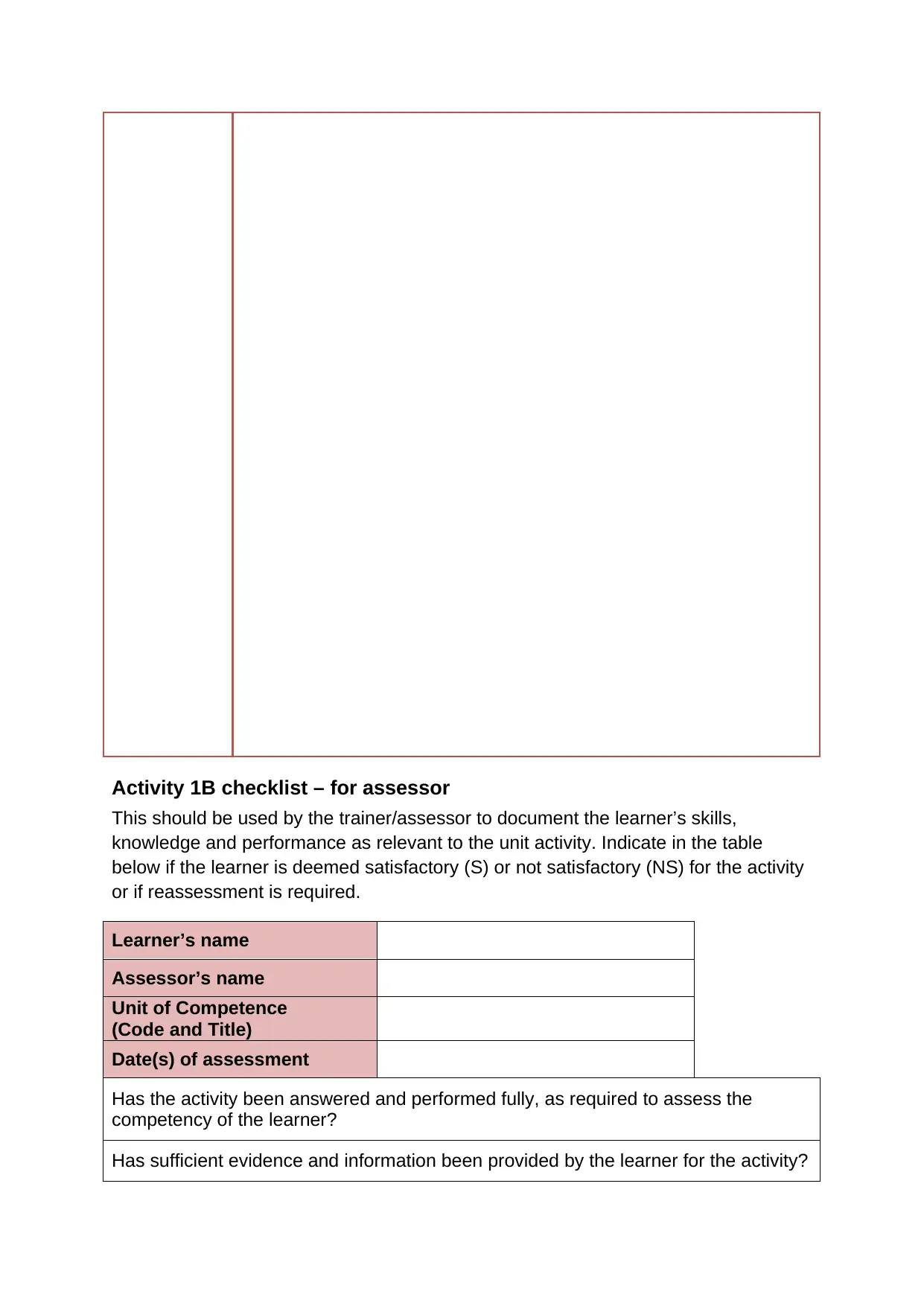
Activity 1B checklist – for assessor
This should be used by the trainer/assessor to document the learner’s skills,
knowledge and performance as relevant to the unit activity. Indicate in the table
below if the learner is deemed satisfactory (S) or not satisfactory (NS) for the activity
or if reassessment is required.
Learner’s name
Assessor’s name
Unit of Competence
(Code and Title)
Date(s) of assessment
Has the activity been answered and performed fully, as required to assess the
competency of the learner?
Has sufficient evidence and information been provided by the learner for the activity?
This should be used by the trainer/assessor to document the learner’s skills,
knowledge and performance as relevant to the unit activity. Indicate in the table
below if the learner is deemed satisfactory (S) or not satisfactory (NS) for the activity
or if reassessment is required.
Learner’s name
Assessor’s name
Unit of Competence
(Code and Title)
Date(s) of assessment
Has the activity been answered and performed fully, as required to assess the
competency of the learner?
Has sufficient evidence and information been provided by the learner for the activity?
Secure Best Marks with AI Grader
Need help grading? Try our AI Grader for instant feedback on your assignments.

Comments
Provide your comments here:
The learner’s
performance was: Not yet satisfactory
Sa
tisf
act
ory
If not yet satisfactory, date for reassessment:
Feedback to learner:
Learner’s signature
Assessor’s signature
Activity 1C
Estimated
Time
20 Minutes
Objective To provide you with an opportunity to assess and act on need for specialist legal
advice.
Activity 1. Identify four reasons for seeking specialist legal advice.
The reasons that attracts the liability for seeking specialist legal
advice are presented below;
• Areas beyond to the work practice
• Having doubt about any working provision
• Insufficient level of knowledge
• Any recent updates and amendments in provisions
2. Who would you approach for specialist legal advice
Provide your comments here:
The learner’s
performance was: Not yet satisfactory
Sa
tisf
act
ory
If not yet satisfactory, date for reassessment:
Feedback to learner:
Learner’s signature
Assessor’s signature
Activity 1C
Estimated
Time
20 Minutes
Objective To provide you with an opportunity to assess and act on need for specialist legal
advice.
Activity 1. Identify four reasons for seeking specialist legal advice.
The reasons that attracts the liability for seeking specialist legal
advice are presented below;
• Areas beyond to the work practice
• Having doubt about any working provision
• Insufficient level of knowledge
• Any recent updates and amendments in provisions
2. Who would you approach for specialist legal advice
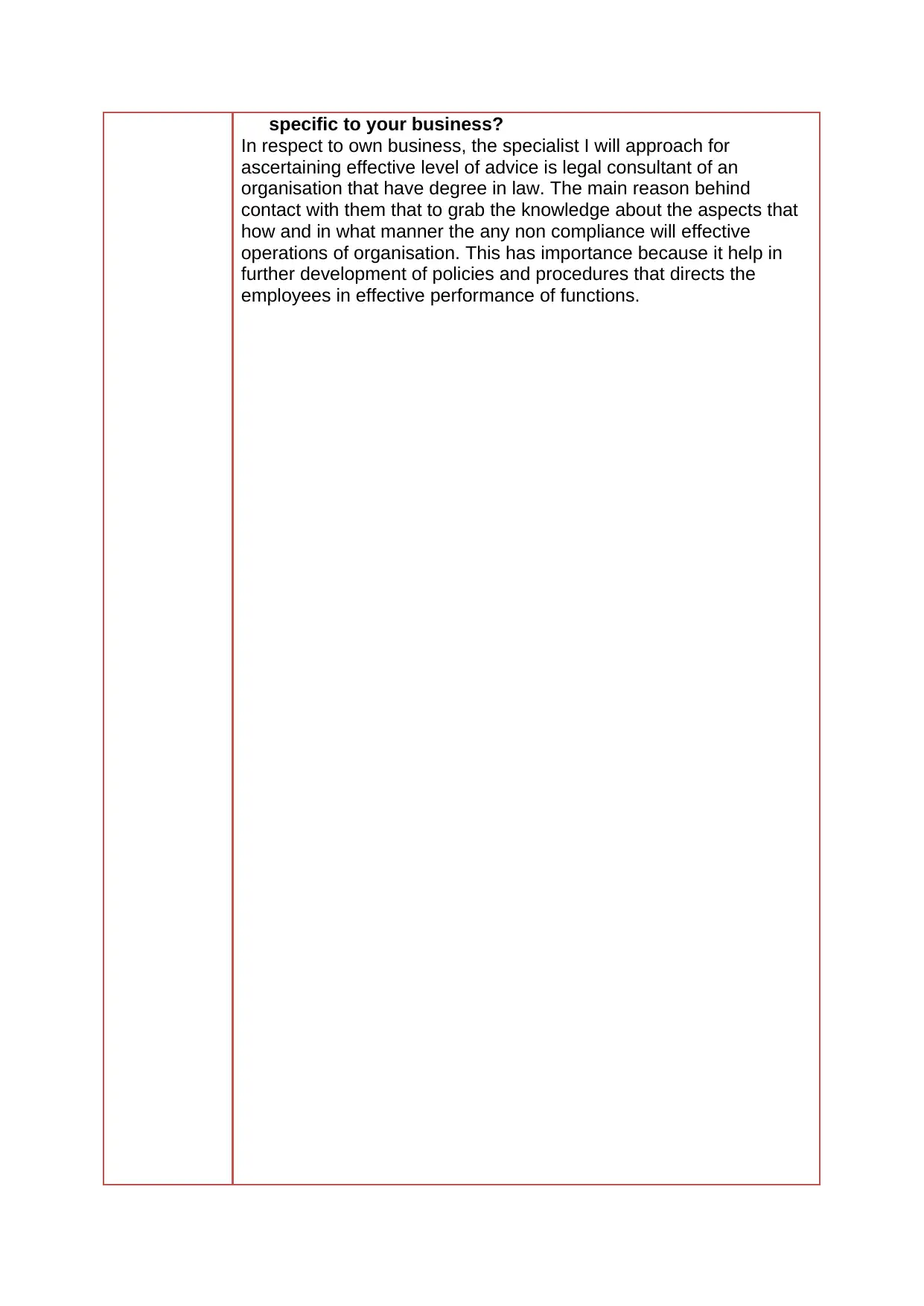
specific to your business?
In respect to own business, the specialist I will approach for
ascertaining effective level of advice is legal consultant of an
organisation that have degree in law. The main reason behind
contact with them that to grab the knowledge about the aspects that
how and in what manner the any non compliance will effective
operations of organisation. This has importance because it help in
further development of policies and procedures that directs the
employees in effective performance of functions.
In respect to own business, the specialist I will approach for
ascertaining effective level of advice is legal consultant of an
organisation that have degree in law. The main reason behind
contact with them that to grab the knowledge about the aspects that
how and in what manner the any non compliance will effective
operations of organisation. This has importance because it help in
further development of policies and procedures that directs the
employees in effective performance of functions.

Activity 1C checklist – for assessor
This should be used by the trainer/assessor to document the learner’s skills,
knowledge and performance as relevant to the unit activity. Indicate in the table
below if the learner is deemed satisfactory (S) or not satisfactory (NS) for the activity
or if reassessment is required.
Learner’s name
Assessor’s name
Unit of Competence
(Code and Title)
Date(s) of assessment
Has the activity been answered and performed fully, as required to assess the
competency of the learner?
Has sufficient evidence and information been provided by the learner for the activity?
Comments
Provide your comments here:
The learner’s
performance was: Not yet satisfactory
Sa
tisf
act
ory
If not yet satisfactory, date for reassessment:
Feedback to learner:
This should be used by the trainer/assessor to document the learner’s skills,
knowledge and performance as relevant to the unit activity. Indicate in the table
below if the learner is deemed satisfactory (S) or not satisfactory (NS) for the activity
or if reassessment is required.
Learner’s name
Assessor’s name
Unit of Competence
(Code and Title)
Date(s) of assessment
Has the activity been answered and performed fully, as required to assess the
competency of the learner?
Has sufficient evidence and information been provided by the learner for the activity?
Comments
Provide your comments here:
The learner’s
performance was: Not yet satisfactory
Sa
tisf
act
ory
If not yet satisfactory, date for reassessment:
Feedback to learner:
Paraphrase This Document
Need a fresh take? Get an instant paraphrase of this document with our AI Paraphraser
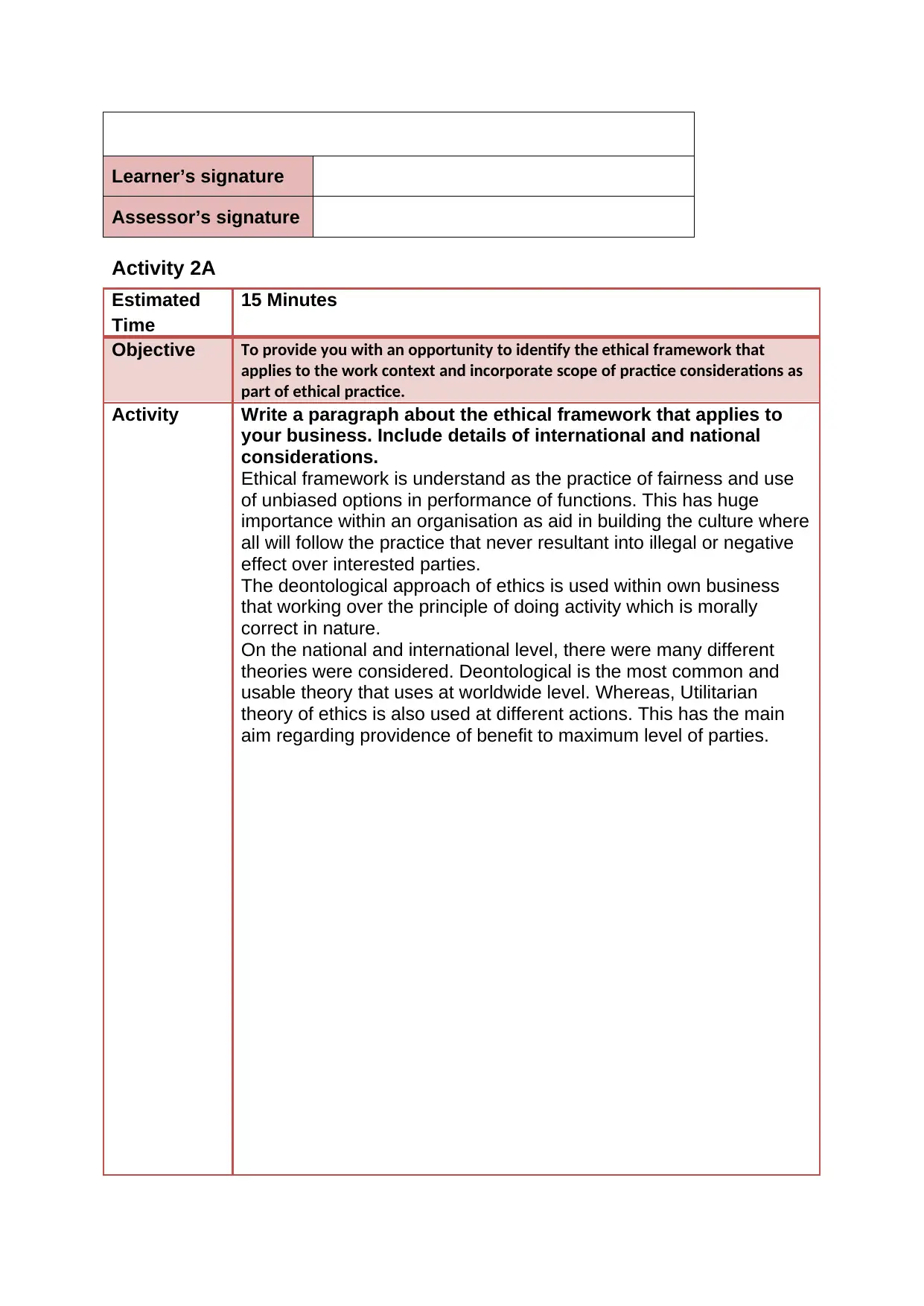
Learner’s signature
Assessor’s signature
Activity 2A
Estimated
Time
15 Minutes
Objective To provide you with an opportunity to identify the ethical framework that
applies to the work context and incorporate scope of practice considerations as
part of ethical practice.
Activity Write a paragraph about the ethical framework that applies to
your business. Include details of international and national
considerations.
Ethical framework is understand as the practice of fairness and use
of unbiased options in performance of functions. This has huge
importance within an organisation as aid in building the culture where
all will follow the practice that never resultant into illegal or negative
effect over interested parties.
The deontological approach of ethics is used within own business
that working over the principle of doing activity which is morally
correct in nature.
On the national and international level, there were many different
theories were considered. Deontological is the most common and
usable theory that uses at worldwide level. Whereas, Utilitarian
theory of ethics is also used at different actions. This has the main
aim regarding providence of benefit to maximum level of parties.
Assessor’s signature
Activity 2A
Estimated
Time
15 Minutes
Objective To provide you with an opportunity to identify the ethical framework that
applies to the work context and incorporate scope of practice considerations as
part of ethical practice.
Activity Write a paragraph about the ethical framework that applies to
your business. Include details of international and national
considerations.
Ethical framework is understand as the practice of fairness and use
of unbiased options in performance of functions. This has huge
importance within an organisation as aid in building the culture where
all will follow the practice that never resultant into illegal or negative
effect over interested parties.
The deontological approach of ethics is used within own business
that working over the principle of doing activity which is morally
correct in nature.
On the national and international level, there were many different
theories were considered. Deontological is the most common and
usable theory that uses at worldwide level. Whereas, Utilitarian
theory of ethics is also used at different actions. This has the main
aim regarding providence of benefit to maximum level of parties.
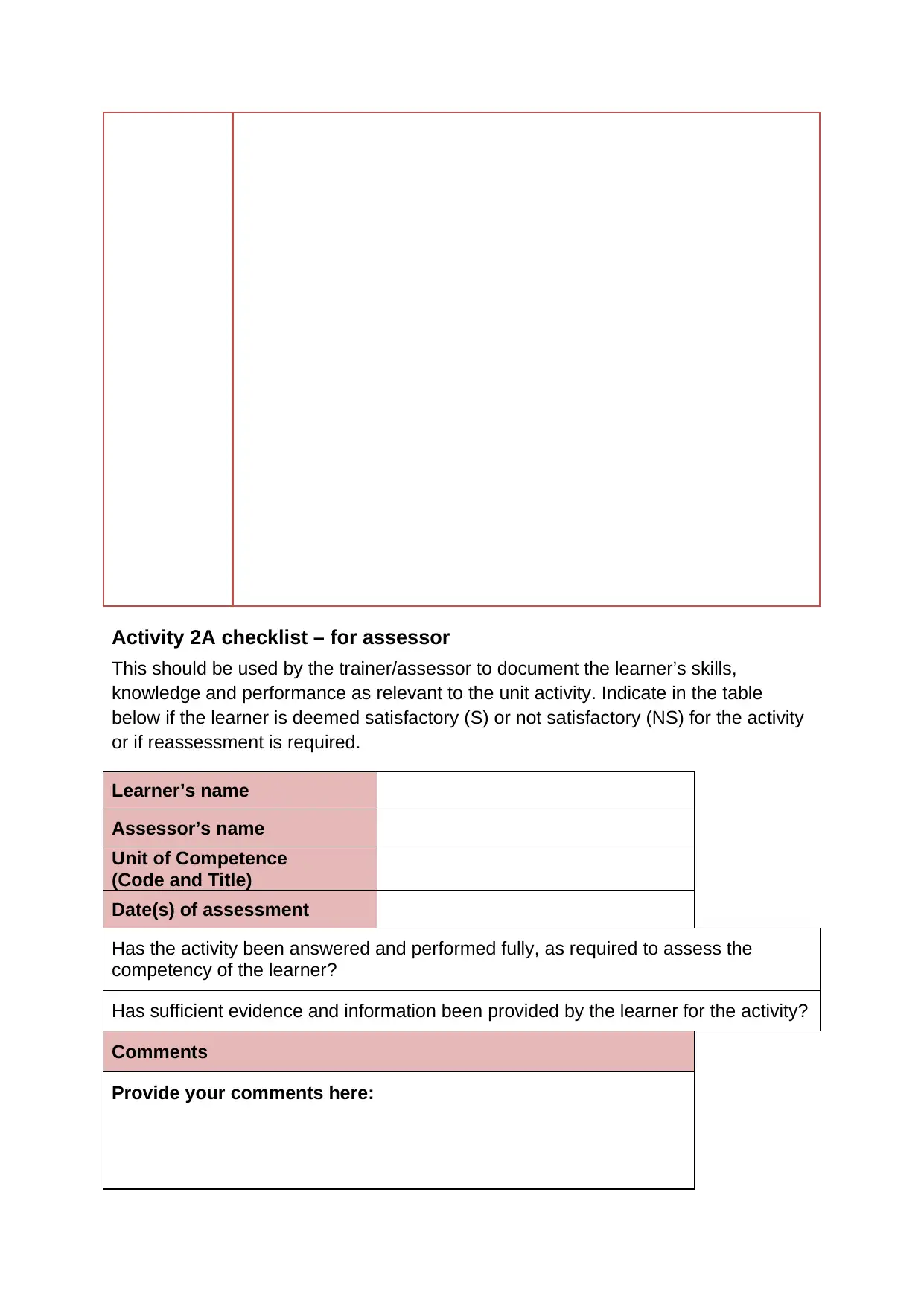
Activity 2A checklist – for assessor
This should be used by the trainer/assessor to document the learner’s skills,
knowledge and performance as relevant to the unit activity. Indicate in the table
below if the learner is deemed satisfactory (S) or not satisfactory (NS) for the activity
or if reassessment is required.
Learner’s name
Assessor’s name
Unit of Competence
(Code and Title)
Date(s) of assessment
Has the activity been answered and performed fully, as required to assess the
competency of the learner?
Has sufficient evidence and information been provided by the learner for the activity?
Comments
Provide your comments here:
This should be used by the trainer/assessor to document the learner’s skills,
knowledge and performance as relevant to the unit activity. Indicate in the table
below if the learner is deemed satisfactory (S) or not satisfactory (NS) for the activity
or if reassessment is required.
Learner’s name
Assessor’s name
Unit of Competence
(Code and Title)
Date(s) of assessment
Has the activity been answered and performed fully, as required to assess the
competency of the learner?
Has sufficient evidence and information been provided by the learner for the activity?
Comments
Provide your comments here:
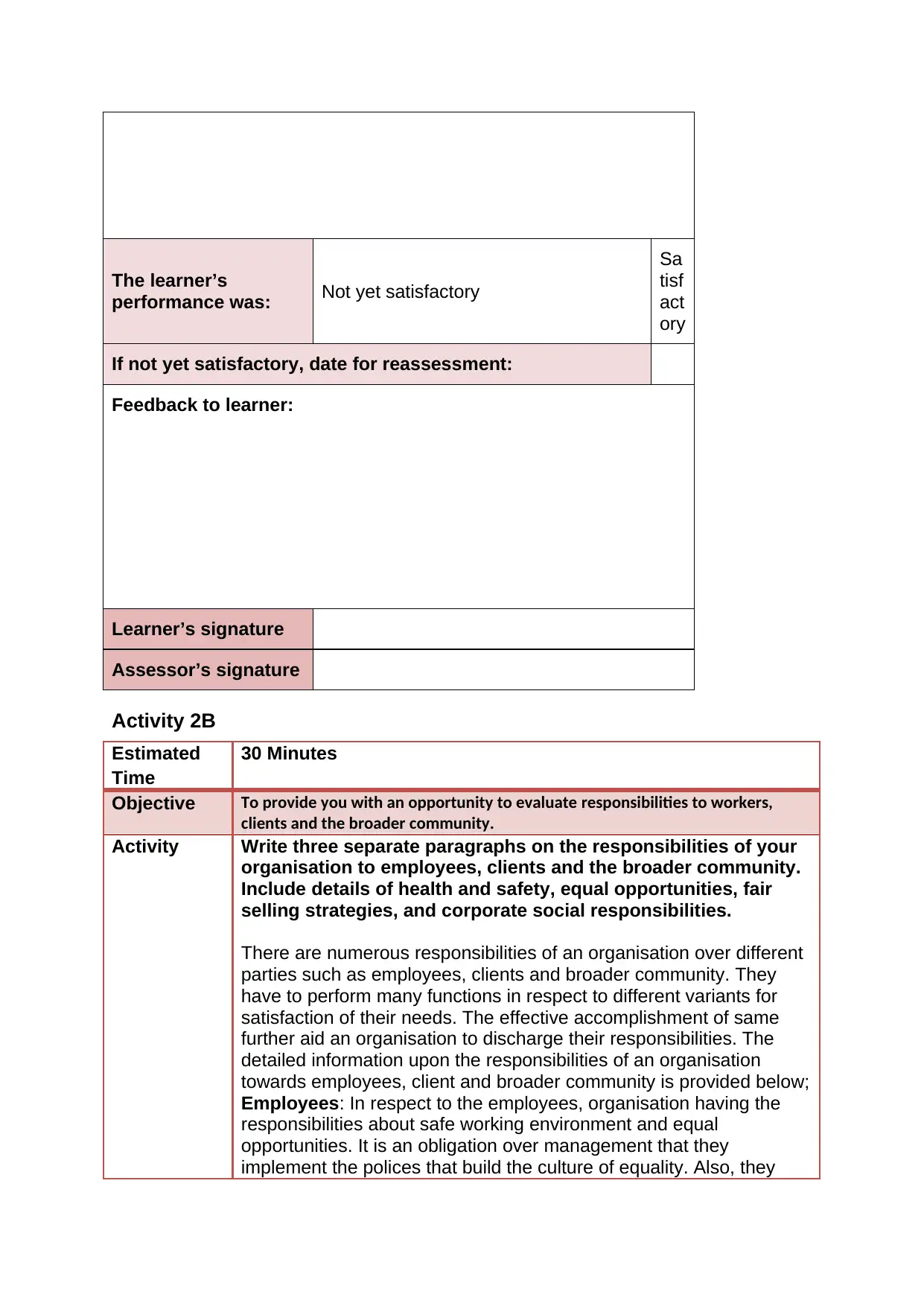
The learner’s
performance was: Not yet satisfactory
Sa
tisf
act
ory
If not yet satisfactory, date for reassessment:
Feedback to learner:
Learner’s signature
Assessor’s signature
Activity 2B
Estimated
Time
30 Minutes
Objective To provide you with an opportunity to evaluate responsibilities to workers,
clients and the broader community.
Activity Write three separate paragraphs on the responsibilities of your
organisation to employees, clients and the broader community.
Include details of health and safety, equal opportunities, fair
selling strategies, and corporate social responsibilities.
There are numerous responsibilities of an organisation over different
parties such as employees, clients and broader community. They
have to perform many functions in respect to different variants for
satisfaction of their needs. The effective accomplishment of same
further aid an organisation to discharge their responsibilities. The
detailed information upon the responsibilities of an organisation
towards employees, client and broader community is provided below;
Employees: In respect to the employees, organisation having the
responsibilities about safe working environment and equal
opportunities. It is an obligation over management that they
implement the polices that build the culture of equality. Also, they
performance was: Not yet satisfactory
Sa
tisf
act
ory
If not yet satisfactory, date for reassessment:
Feedback to learner:
Learner’s signature
Assessor’s signature
Activity 2B
Estimated
Time
30 Minutes
Objective To provide you with an opportunity to evaluate responsibilities to workers,
clients and the broader community.
Activity Write three separate paragraphs on the responsibilities of your
organisation to employees, clients and the broader community.
Include details of health and safety, equal opportunities, fair
selling strategies, and corporate social responsibilities.
There are numerous responsibilities of an organisation over different
parties such as employees, clients and broader community. They
have to perform many functions in respect to different variants for
satisfaction of their needs. The effective accomplishment of same
further aid an organisation to discharge their responsibilities. The
detailed information upon the responsibilities of an organisation
towards employees, client and broader community is provided below;
Employees: In respect to the employees, organisation having the
responsibilities about safe working environment and equal
opportunities. It is an obligation over management that they
implement the polices that build the culture of equality. Also, they
Secure Best Marks with AI Grader
Need help grading? Try our AI Grader for instant feedback on your assignments.

under the obligation about implementation of all measures that will
be effective in direction of safeguarding the health of employees like
sign boards and proper sanitisation facilities in relation to current
environment.
Client: On behalf of client, Organisation has the responsibility that
never provide unfair advantage to anyone from which the party will
get excessive benefits in future. In this regard, organisation is under
an obligation that focus over adoption of fair selling strategies
through adherence of common norms and policies.
Broader community: It is the responsibility on an organisation that if
they earning profit from society then return some in way of CSR. This
is the term that known as corporate social responsibility. Here, they
have an obligation to first minimise the negative impact of their
operations and secondly generate programmes that help society in
direct or indirect way.
be effective in direction of safeguarding the health of employees like
sign boards and proper sanitisation facilities in relation to current
environment.
Client: On behalf of client, Organisation has the responsibility that
never provide unfair advantage to anyone from which the party will
get excessive benefits in future. In this regard, organisation is under
an obligation that focus over adoption of fair selling strategies
through adherence of common norms and policies.
Broader community: It is the responsibility on an organisation that if
they earning profit from society then return some in way of CSR. This
is the term that known as corporate social responsibility. Here, they
have an obligation to first minimise the negative impact of their
operations and secondly generate programmes that help society in
direct or indirect way.
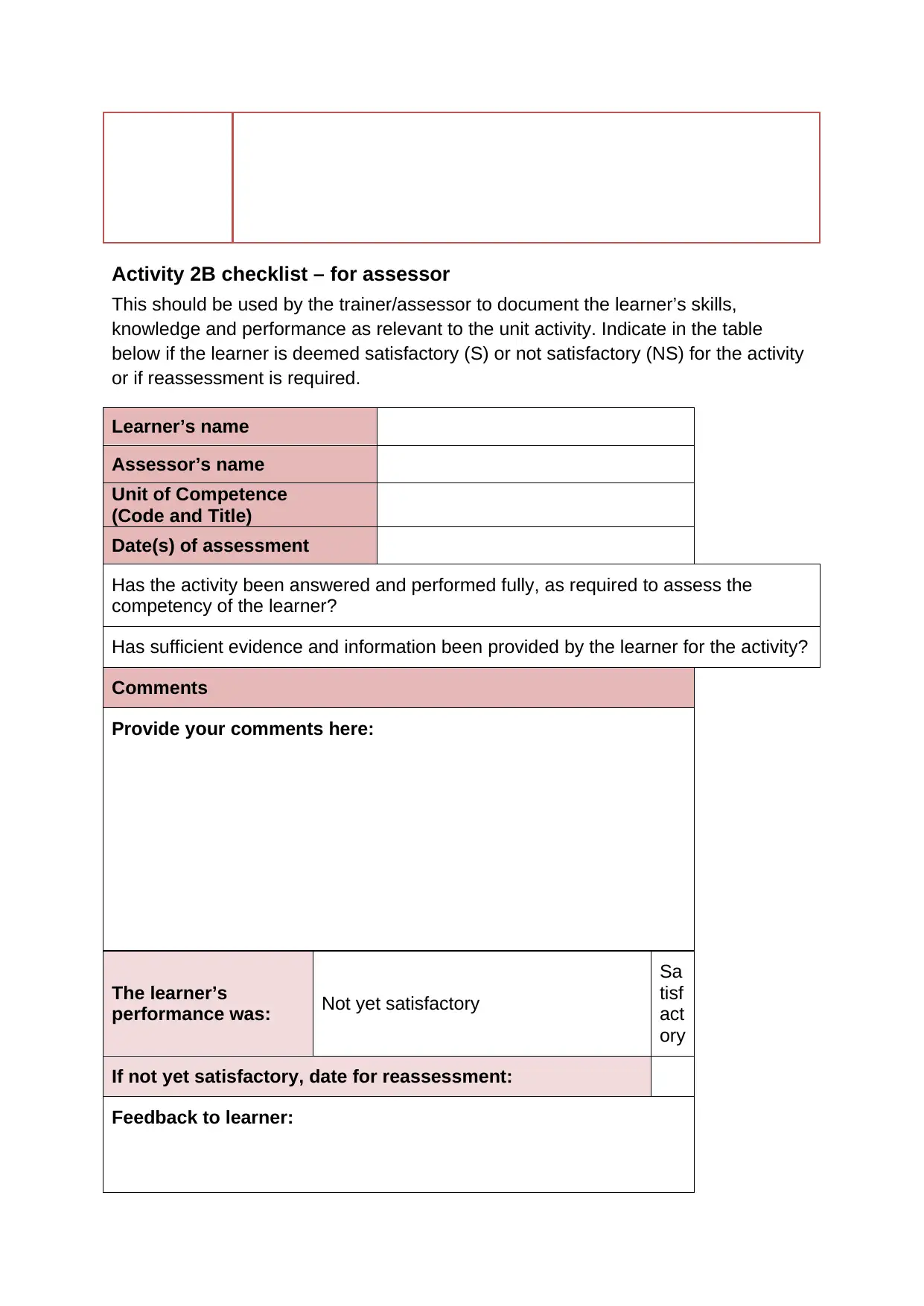
Activity 2B checklist – for assessor
This should be used by the trainer/assessor to document the learner’s skills,
knowledge and performance as relevant to the unit activity. Indicate in the table
below if the learner is deemed satisfactory (S) or not satisfactory (NS) for the activity
or if reassessment is required.
Learner’s name
Assessor’s name
Unit of Competence
(Code and Title)
Date(s) of assessment
Has the activity been answered and performed fully, as required to assess the
competency of the learner?
Has sufficient evidence and information been provided by the learner for the activity?
Comments
Provide your comments here:
The learner’s
performance was: Not yet satisfactory
Sa
tisf
act
ory
If not yet satisfactory, date for reassessment:
Feedback to learner:
This should be used by the trainer/assessor to document the learner’s skills,
knowledge and performance as relevant to the unit activity. Indicate in the table
below if the learner is deemed satisfactory (S) or not satisfactory (NS) for the activity
or if reassessment is required.
Learner’s name
Assessor’s name
Unit of Competence
(Code and Title)
Date(s) of assessment
Has the activity been answered and performed fully, as required to assess the
competency of the learner?
Has sufficient evidence and information been provided by the learner for the activity?
Comments
Provide your comments here:
The learner’s
performance was: Not yet satisfactory
Sa
tisf
act
ory
If not yet satisfactory, date for reassessment:
Feedback to learner:
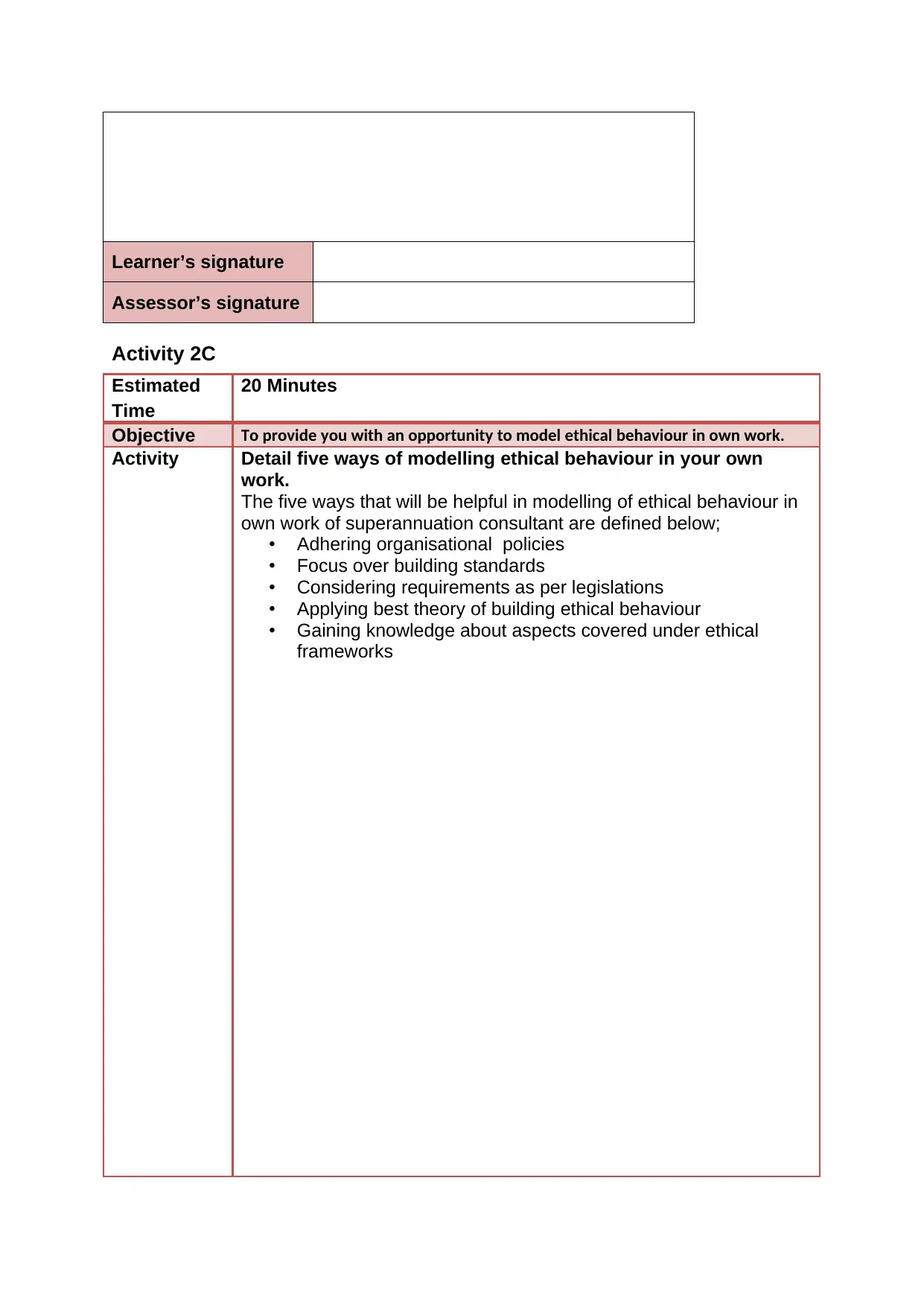
Learner’s signature
Assessor’s signature
Activity 2C
Estimated
Time
20 Minutes
Objective To provide you with an opportunity to model ethical behaviour in own work.
Activity Detail five ways of modelling ethical behaviour in your own
work.
The five ways that will be helpful in modelling of ethical behaviour in
own work of superannuation consultant are defined below;
• Adhering organisational policies
• Focus over building standards
• Considering requirements as per legislations
• Applying best theory of building ethical behaviour
• Gaining knowledge about aspects covered under ethical
frameworks
Assessor’s signature
Activity 2C
Estimated
Time
20 Minutes
Objective To provide you with an opportunity to model ethical behaviour in own work.
Activity Detail five ways of modelling ethical behaviour in your own
work.
The five ways that will be helpful in modelling of ethical behaviour in
own work of superannuation consultant are defined below;
• Adhering organisational policies
• Focus over building standards
• Considering requirements as per legislations
• Applying best theory of building ethical behaviour
• Gaining knowledge about aspects covered under ethical
frameworks
Paraphrase This Document
Need a fresh take? Get an instant paraphrase of this document with our AI Paraphraser
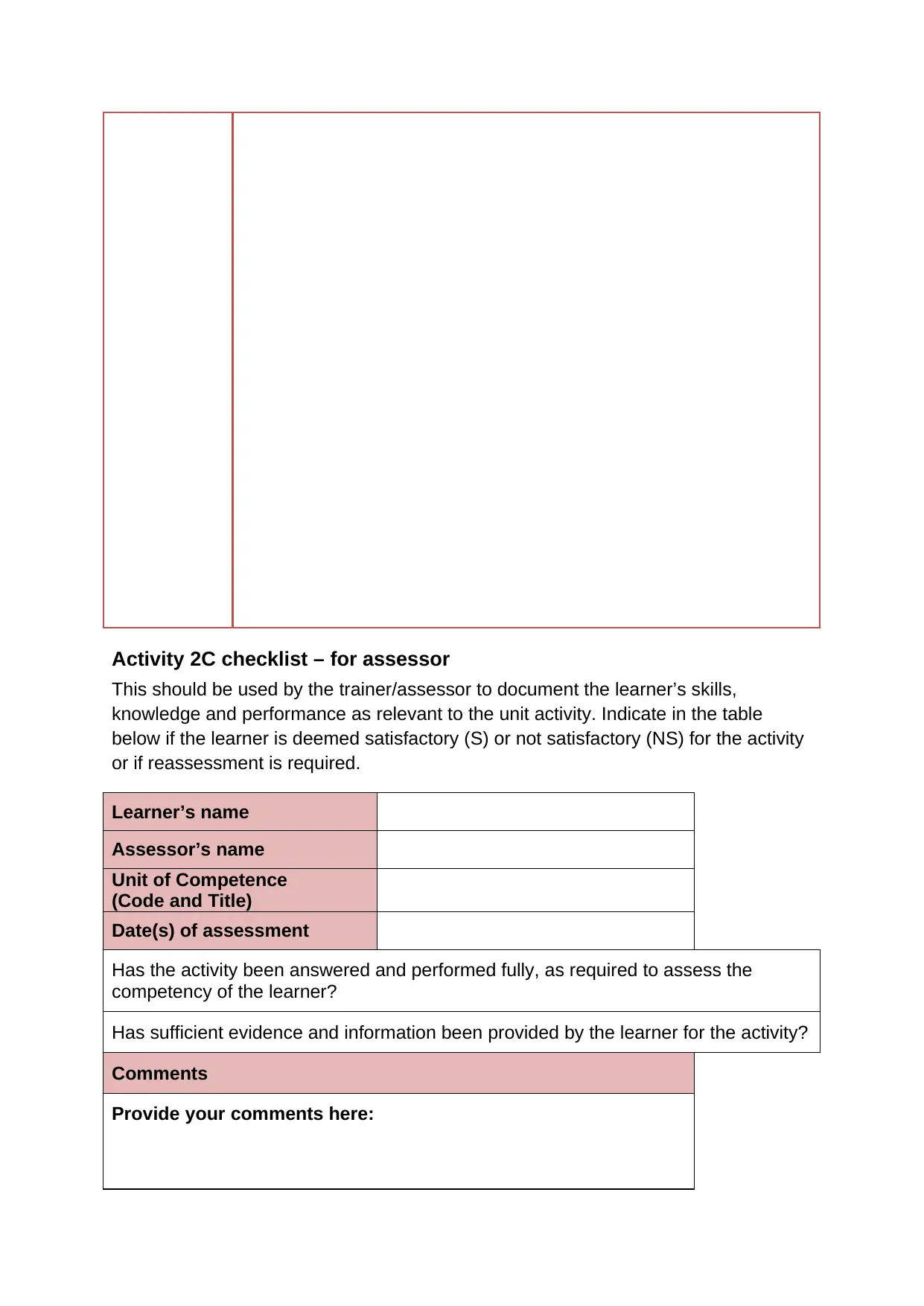
Activity 2C checklist – for assessor
This should be used by the trainer/assessor to document the learner’s skills,
knowledge and performance as relevant to the unit activity. Indicate in the table
below if the learner is deemed satisfactory (S) or not satisfactory (NS) for the activity
or if reassessment is required.
Learner’s name
Assessor’s name
Unit of Competence
(Code and Title)
Date(s) of assessment
Has the activity been answered and performed fully, as required to assess the
competency of the learner?
Has sufficient evidence and information been provided by the learner for the activity?
Comments
Provide your comments here:
This should be used by the trainer/assessor to document the learner’s skills,
knowledge and performance as relevant to the unit activity. Indicate in the table
below if the learner is deemed satisfactory (S) or not satisfactory (NS) for the activity
or if reassessment is required.
Learner’s name
Assessor’s name
Unit of Competence
(Code and Title)
Date(s) of assessment
Has the activity been answered and performed fully, as required to assess the
competency of the learner?
Has sufficient evidence and information been provided by the learner for the activity?
Comments
Provide your comments here:
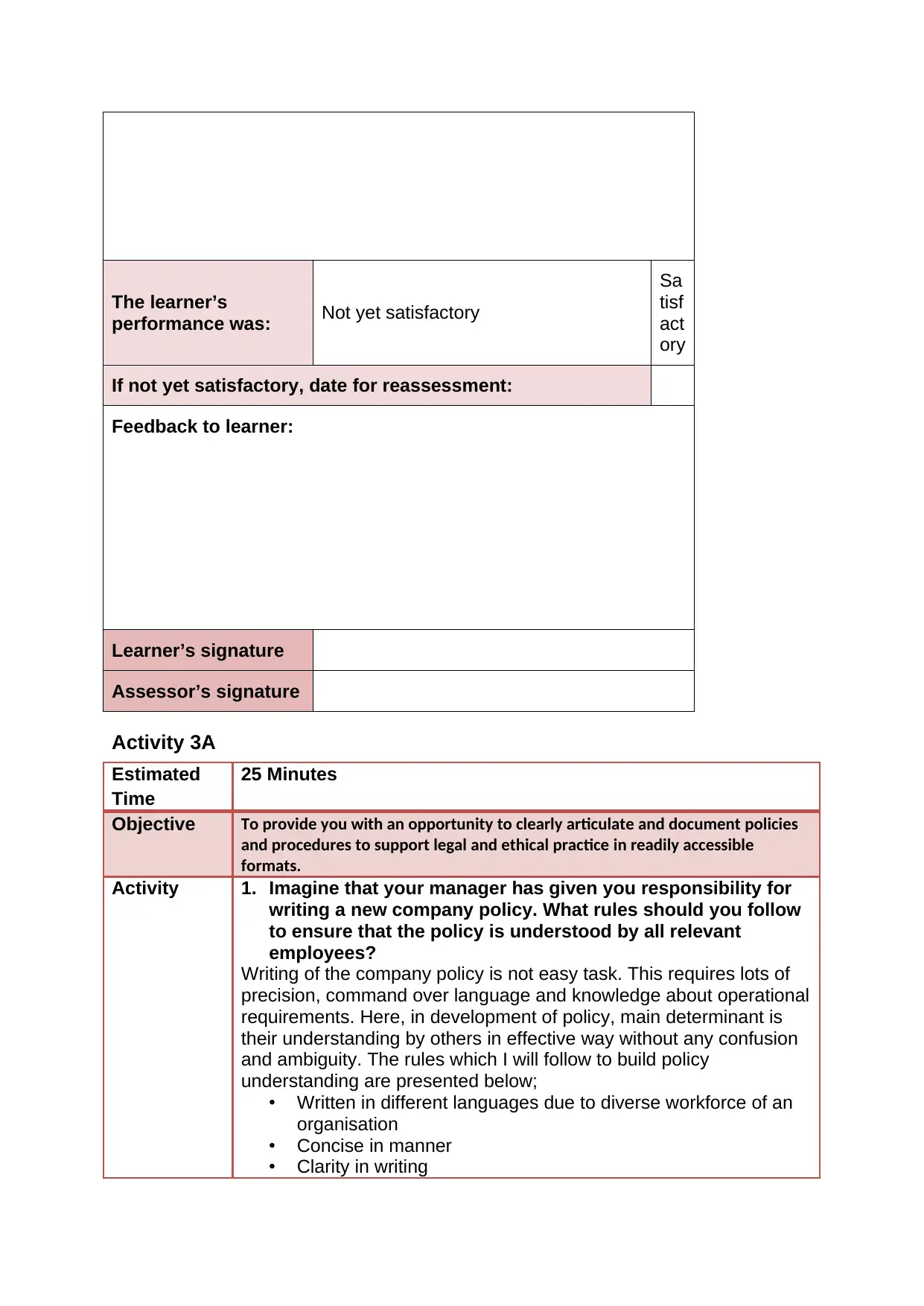
The learner’s
performance was: Not yet satisfactory
Sa
tisf
act
ory
If not yet satisfactory, date for reassessment:
Feedback to learner:
Learner’s signature
Assessor’s signature
Activity 3A
Estimated
Time
25 Minutes
Objective To provide you with an opportunity to clearly articulate and document policies
and procedures to support legal and ethical practice in readily accessible
formats.
Activity 1. Imagine that your manager has given you responsibility for
writing a new company policy. What rules should you follow
to ensure that the policy is understood by all relevant
employees?
Writing of the company policy is not easy task. This requires lots of
precision, command over language and knowledge about operational
requirements. Here, in development of policy, main determinant is
their understanding by others in effective way without any confusion
and ambiguity. The rules which I will follow to build policy
understanding are presented below;
• Written in different languages due to diverse workforce of an
organisation
• Concise in manner
• Clarity in writing
performance was: Not yet satisfactory
Sa
tisf
act
ory
If not yet satisfactory, date for reassessment:
Feedback to learner:
Learner’s signature
Assessor’s signature
Activity 3A
Estimated
Time
25 Minutes
Objective To provide you with an opportunity to clearly articulate and document policies
and procedures to support legal and ethical practice in readily accessible
formats.
Activity 1. Imagine that your manager has given you responsibility for
writing a new company policy. What rules should you follow
to ensure that the policy is understood by all relevant
employees?
Writing of the company policy is not easy task. This requires lots of
precision, command over language and knowledge about operational
requirements. Here, in development of policy, main determinant is
their understanding by others in effective way without any confusion
and ambiguity. The rules which I will follow to build policy
understanding are presented below;
• Written in different languages due to diverse workforce of an
organisation
• Concise in manner
• Clarity in writing
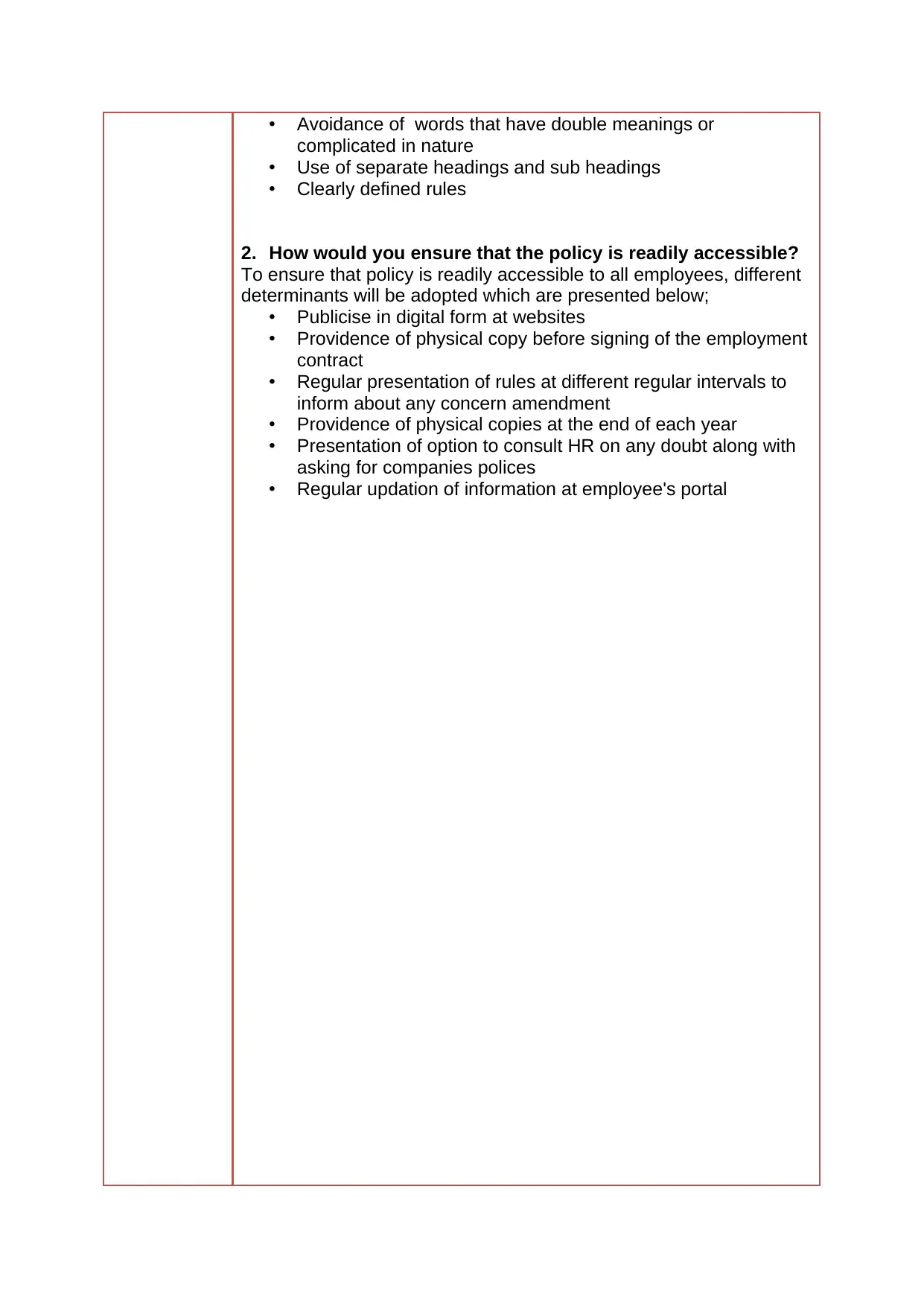
• Avoidance of words that have double meanings or
complicated in nature
• Use of separate headings and sub headings
• Clearly defined rules
2. How would you ensure that the policy is readily accessible?
To ensure that policy is readily accessible to all employees, different
determinants will be adopted which are presented below;
• Publicise in digital form at websites
• Providence of physical copy before signing of the employment
contract
• Regular presentation of rules at different regular intervals to
inform about any concern amendment
• Providence of physical copies at the end of each year
• Presentation of option to consult HR on any doubt along with
asking for companies polices
• Regular updation of information at employee's portal
complicated in nature
• Use of separate headings and sub headings
• Clearly defined rules
2. How would you ensure that the policy is readily accessible?
To ensure that policy is readily accessible to all employees, different
determinants will be adopted which are presented below;
• Publicise in digital form at websites
• Providence of physical copy before signing of the employment
contract
• Regular presentation of rules at different regular intervals to
inform about any concern amendment
• Providence of physical copies at the end of each year
• Presentation of option to consult HR on any doubt along with
asking for companies polices
• Regular updation of information at employee's portal
Secure Best Marks with AI Grader
Need help grading? Try our AI Grader for instant feedback on your assignments.
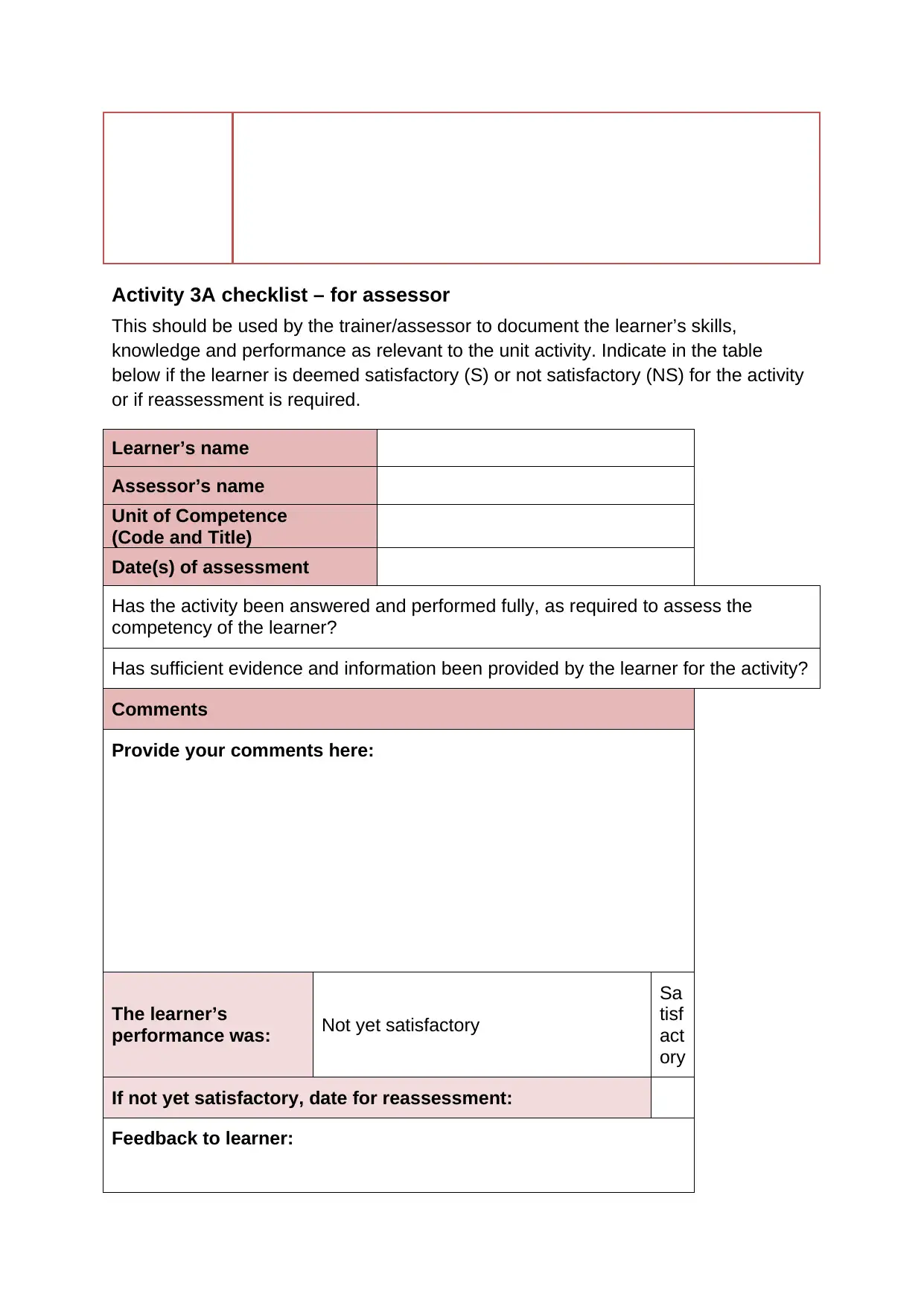
Activity 3A checklist – for assessor
This should be used by the trainer/assessor to document the learner’s skills,
knowledge and performance as relevant to the unit activity. Indicate in the table
below if the learner is deemed satisfactory (S) or not satisfactory (NS) for the activity
or if reassessment is required.
Learner’s name
Assessor’s name
Unit of Competence
(Code and Title)
Date(s) of assessment
Has the activity been answered and performed fully, as required to assess the
competency of the learner?
Has sufficient evidence and information been provided by the learner for the activity?
Comments
Provide your comments here:
The learner’s
performance was: Not yet satisfactory
Sa
tisf
act
ory
If not yet satisfactory, date for reassessment:
Feedback to learner:
This should be used by the trainer/assessor to document the learner’s skills,
knowledge and performance as relevant to the unit activity. Indicate in the table
below if the learner is deemed satisfactory (S) or not satisfactory (NS) for the activity
or if reassessment is required.
Learner’s name
Assessor’s name
Unit of Competence
(Code and Title)
Date(s) of assessment
Has the activity been answered and performed fully, as required to assess the
competency of the learner?
Has sufficient evidence and information been provided by the learner for the activity?
Comments
Provide your comments here:
The learner’s
performance was: Not yet satisfactory
Sa
tisf
act
ory
If not yet satisfactory, date for reassessment:
Feedback to learner:
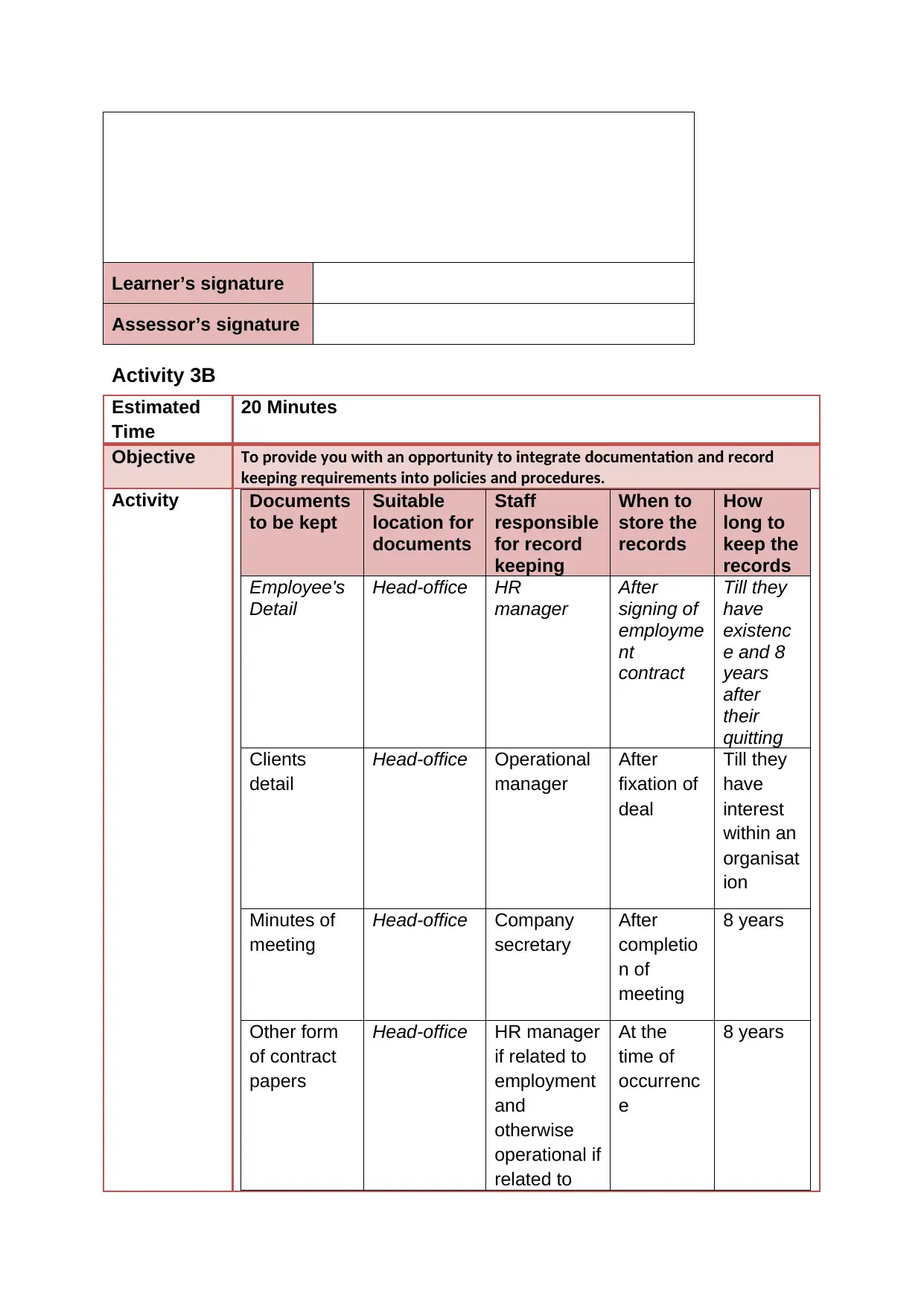
Learner’s signature
Assessor’s signature
Activity 3B
Estimated
Time
20 Minutes
Objective To provide you with an opportunity to integrate documentation and record
keeping requirements into policies and procedures.
Activity Documents
to be kept
Suitable
location for
documents
Staff
responsible
for record
keeping
When to
store the
records
How
long to
keep the
records
Employee's
Detail
Head-office HR
manager
After
signing of
employme
nt
contract
Till they
have
existenc
e and 8
years
after
their
quitting
Clients
detail
Head-office Operational
manager
After
fixation of
deal
Till they
have
interest
within an
organisat
ion
Minutes of
meeting
Head-office Company
secretary
After
completio
n of
meeting
8 years
Other form
of contract
papers
Head-office HR manager
if related to
employment
and
otherwise
operational if
related to
At the
time of
occurrenc
e
8 years
Assessor’s signature
Activity 3B
Estimated
Time
20 Minutes
Objective To provide you with an opportunity to integrate documentation and record
keeping requirements into policies and procedures.
Activity Documents
to be kept
Suitable
location for
documents
Staff
responsible
for record
keeping
When to
store the
records
How
long to
keep the
records
Employee's
Detail
Head-office HR
manager
After
signing of
employme
nt
contract
Till they
have
existenc
e and 8
years
after
their
quitting
Clients
detail
Head-office Operational
manager
After
fixation of
deal
Till they
have
interest
within an
organisat
ion
Minutes of
meeting
Head-office Company
secretary
After
completio
n of
meeting
8 years
Other form
of contract
papers
Head-office HR manager
if related to
employment
and
otherwise
operational if
related to
At the
time of
occurrenc
e
8 years
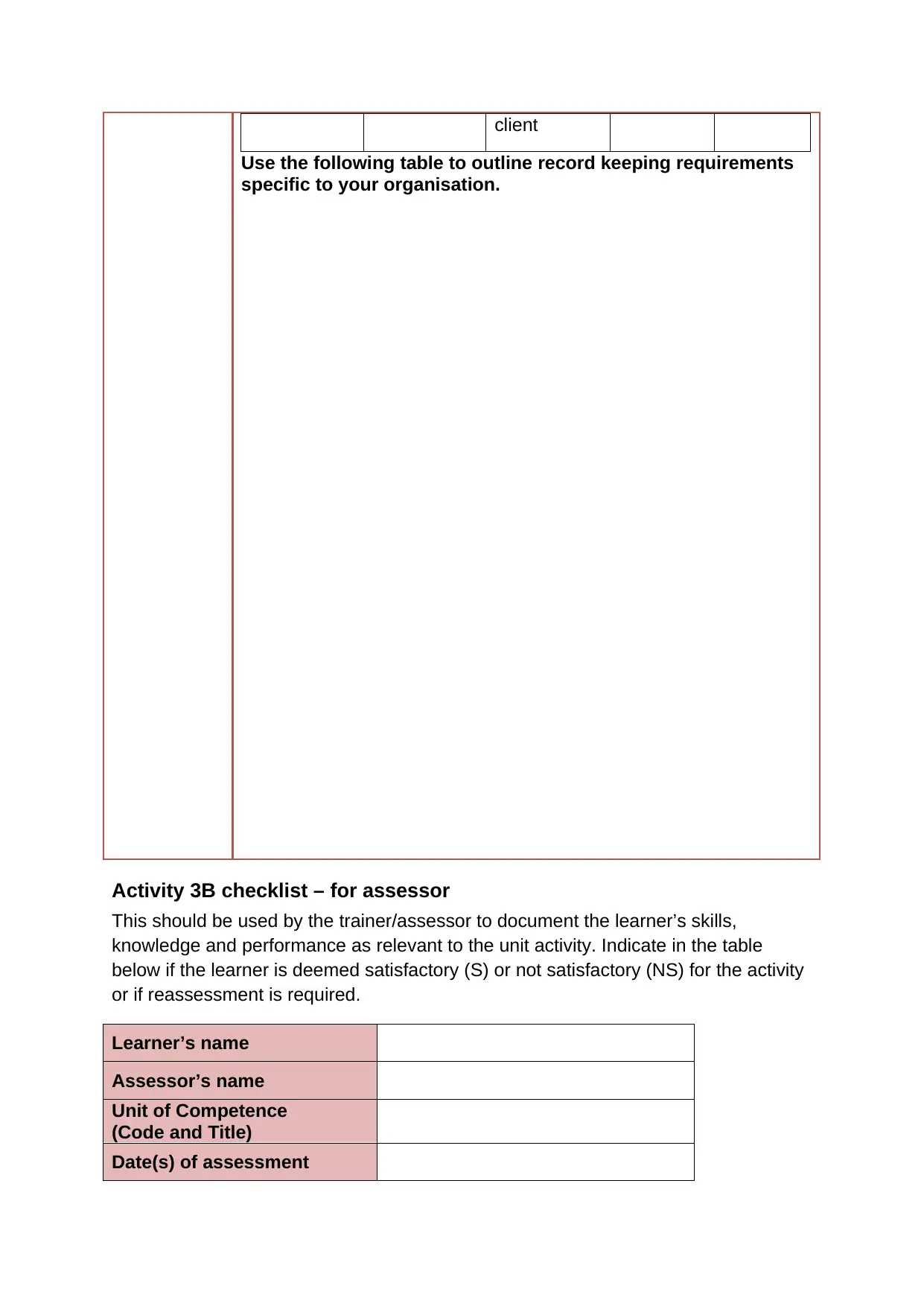
client
Use the following table to outline record keeping requirements
specific to your organisation.
Activity 3B checklist – for assessor
This should be used by the trainer/assessor to document the learner’s skills,
knowledge and performance as relevant to the unit activity. Indicate in the table
below if the learner is deemed satisfactory (S) or not satisfactory (NS) for the activity
or if reassessment is required.
Learner’s name
Assessor’s name
Unit of Competence
(Code and Title)
Date(s) of assessment
Use the following table to outline record keeping requirements
specific to your organisation.
Activity 3B checklist – for assessor
This should be used by the trainer/assessor to document the learner’s skills,
knowledge and performance as relevant to the unit activity. Indicate in the table
below if the learner is deemed satisfactory (S) or not satisfactory (NS) for the activity
or if reassessment is required.
Learner’s name
Assessor’s name
Unit of Competence
(Code and Title)
Date(s) of assessment
Paraphrase This Document
Need a fresh take? Get an instant paraphrase of this document with our AI Paraphraser

Has the activity been answered and performed fully, as required to assess the
competency of the learner?
Has sufficient evidence and information been provided by the learner for the activity?
Comments
Provide your comments here:
The learner’s
performance was: Not yet satisfactory
Sa
tisf
act
ory
If not yet satisfactory, date for reassessment:
Feedback to learner:
Learner’s signature
Assessor’s signature
Activity 3C
Estimated
Time
20 Minutes
Objective To provide you with an opportunity to ensure systems protect client
information.
Activity What systems does your organisation have in place for the
protection of customer information?
Consumer information protection is important from the organisational
perspective. If an organisation failed to do so then have to face the
competency of the learner?
Has sufficient evidence and information been provided by the learner for the activity?
Comments
Provide your comments here:
The learner’s
performance was: Not yet satisfactory
Sa
tisf
act
ory
If not yet satisfactory, date for reassessment:
Feedback to learner:
Learner’s signature
Assessor’s signature
Activity 3C
Estimated
Time
20 Minutes
Objective To provide you with an opportunity to ensure systems protect client
information.
Activity What systems does your organisation have in place for the
protection of customer information?
Consumer information protection is important from the organisational
perspective. If an organisation failed to do so then have to face the
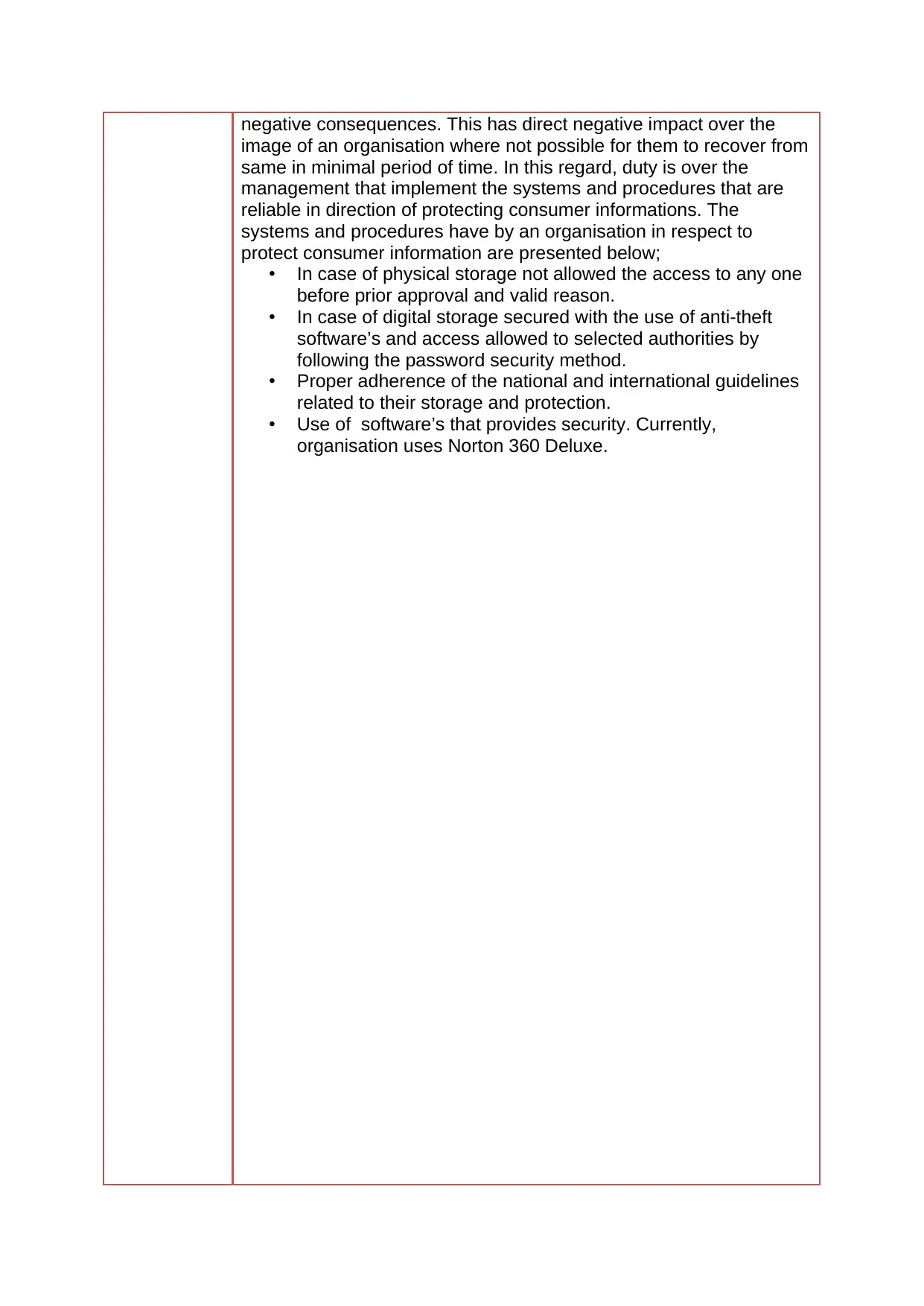
negative consequences. This has direct negative impact over the
image of an organisation where not possible for them to recover from
same in minimal period of time. In this regard, duty is over the
management that implement the systems and procedures that are
reliable in direction of protecting consumer informations. The
systems and procedures have by an organisation in respect to
protect consumer information are presented below;
• In case of physical storage not allowed the access to any one
before prior approval and valid reason.
• In case of digital storage secured with the use of anti-theft
software’s and access allowed to selected authorities by
following the password security method.
• Proper adherence of the national and international guidelines
related to their storage and protection.
• Use of software’s that provides security. Currently,
organisation uses Norton 360 Deluxe.
image of an organisation where not possible for them to recover from
same in minimal period of time. In this regard, duty is over the
management that implement the systems and procedures that are
reliable in direction of protecting consumer informations. The
systems and procedures have by an organisation in respect to
protect consumer information are presented below;
• In case of physical storage not allowed the access to any one
before prior approval and valid reason.
• In case of digital storage secured with the use of anti-theft
software’s and access allowed to selected authorities by
following the password security method.
• Proper adherence of the national and international guidelines
related to their storage and protection.
• Use of software’s that provides security. Currently,
organisation uses Norton 360 Deluxe.
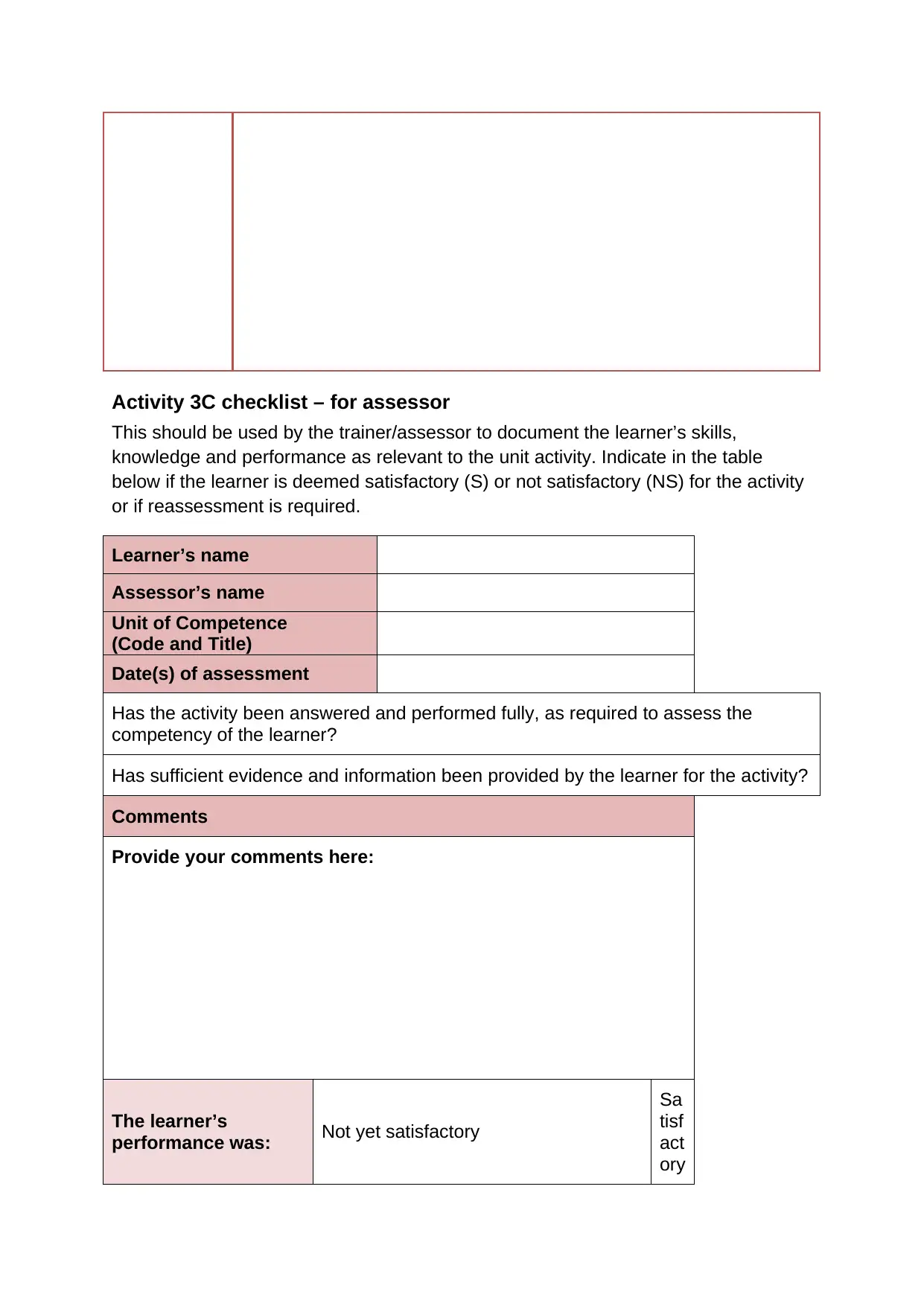
Activity 3C checklist – for assessor
This should be used by the trainer/assessor to document the learner’s skills,
knowledge and performance as relevant to the unit activity. Indicate in the table
below if the learner is deemed satisfactory (S) or not satisfactory (NS) for the activity
or if reassessment is required.
Learner’s name
Assessor’s name
Unit of Competence
(Code and Title)
Date(s) of assessment
Has the activity been answered and performed fully, as required to assess the
competency of the learner?
Has sufficient evidence and information been provided by the learner for the activity?
Comments
Provide your comments here:
The learner’s
performance was: Not yet satisfactory
Sa
tisf
act
ory
This should be used by the trainer/assessor to document the learner’s skills,
knowledge and performance as relevant to the unit activity. Indicate in the table
below if the learner is deemed satisfactory (S) or not satisfactory (NS) for the activity
or if reassessment is required.
Learner’s name
Assessor’s name
Unit of Competence
(Code and Title)
Date(s) of assessment
Has the activity been answered and performed fully, as required to assess the
competency of the learner?
Has sufficient evidence and information been provided by the learner for the activity?
Comments
Provide your comments here:
The learner’s
performance was: Not yet satisfactory
Sa
tisf
act
ory
Secure Best Marks with AI Grader
Need help grading? Try our AI Grader for instant feedback on your assignments.
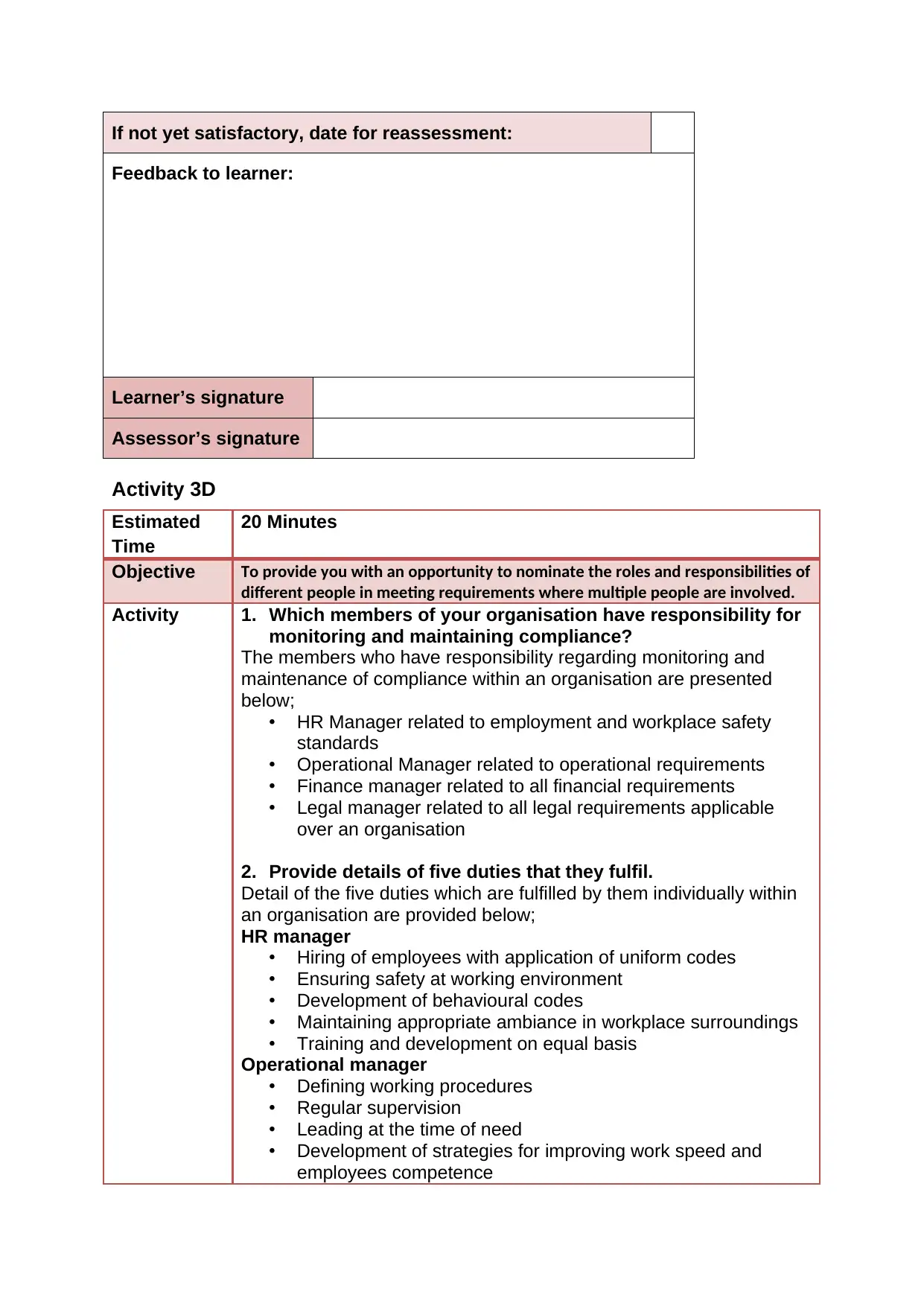
If not yet satisfactory, date for reassessment:
Feedback to learner:
Learner’s signature
Assessor’s signature
Activity 3D
Estimated
Time
20 Minutes
Objective To provide you with an opportunity to nominate the roles and responsibilities of
different people in meeting requirements where multiple people are involved.
Activity 1. Which members of your organisation have responsibility for
monitoring and maintaining compliance?
The members who have responsibility regarding monitoring and
maintenance of compliance within an organisation are presented
below;
• HR Manager related to employment and workplace safety
standards
• Operational Manager related to operational requirements
• Finance manager related to all financial requirements
• Legal manager related to all legal requirements applicable
over an organisation
2. Provide details of five duties that they fulfil.
Detail of the five duties which are fulfilled by them individually within
an organisation are provided below;
HR manager
• Hiring of employees with application of uniform codes
• Ensuring safety at working environment
• Development of behavioural codes
• Maintaining appropriate ambiance in workplace surroundings
• Training and development on equal basis
Operational manager
• Defining working procedures
• Regular supervision
• Leading at the time of need
• Development of strategies for improving work speed and
employees competence
Feedback to learner:
Learner’s signature
Assessor’s signature
Activity 3D
Estimated
Time
20 Minutes
Objective To provide you with an opportunity to nominate the roles and responsibilities of
different people in meeting requirements where multiple people are involved.
Activity 1. Which members of your organisation have responsibility for
monitoring and maintaining compliance?
The members who have responsibility regarding monitoring and
maintenance of compliance within an organisation are presented
below;
• HR Manager related to employment and workplace safety
standards
• Operational Manager related to operational requirements
• Finance manager related to all financial requirements
• Legal manager related to all legal requirements applicable
over an organisation
2. Provide details of five duties that they fulfil.
Detail of the five duties which are fulfilled by them individually within
an organisation are provided below;
HR manager
• Hiring of employees with application of uniform codes
• Ensuring safety at working environment
• Development of behavioural codes
• Maintaining appropriate ambiance in workplace surroundings
• Training and development on equal basis
Operational manager
• Defining working procedures
• Regular supervision
• Leading at the time of need
• Development of strategies for improving work speed and
employees competence
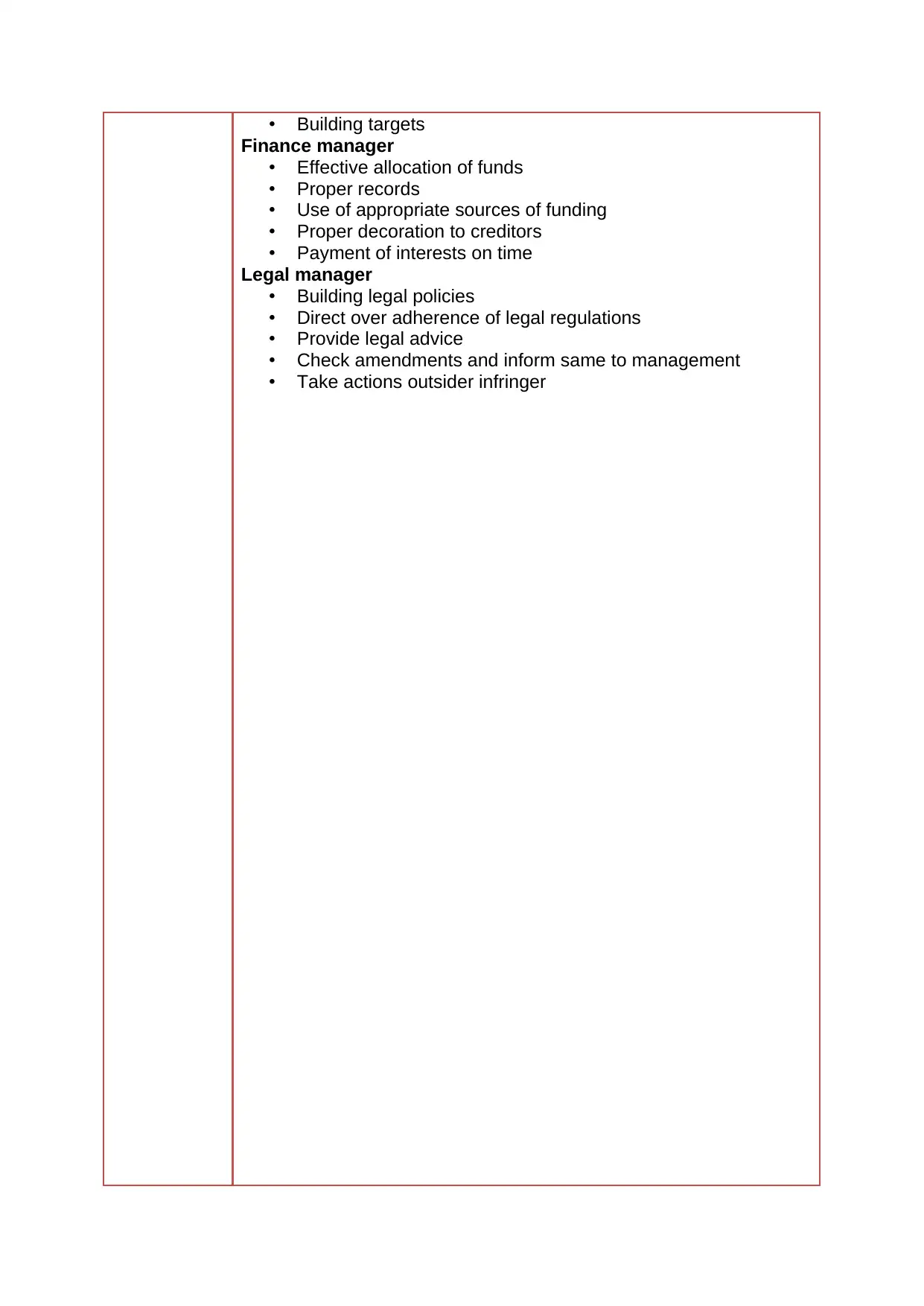
• Building targets
Finance manager
• Effective allocation of funds
• Proper records
• Use of appropriate sources of funding
• Proper decoration to creditors
• Payment of interests on time
Legal manager
• Building legal policies
• Direct over adherence of legal regulations
• Provide legal advice
• Check amendments and inform same to management
• Take actions outsider infringer
Finance manager
• Effective allocation of funds
• Proper records
• Use of appropriate sources of funding
• Proper decoration to creditors
• Payment of interests on time
Legal manager
• Building legal policies
• Direct over adherence of legal regulations
• Provide legal advice
• Check amendments and inform same to management
• Take actions outsider infringer

Activity 3D checklist – for assessor
This should be used by the trainer/assessor to document the learner’s skills,
knowledge and performance as relevant to the unit activity. Indicate in the table
below if the learner is deemed satisfactory (S) or not satisfactory (NS) for the activity
or if reassessment is required.
Learner’s name
Assessor’s name
Unit of Competence
(Code and Title)
Date(s) of assessment
Has the activity been answered and performed fully, as required to assess the
competency of the learner?
Has sufficient evidence and information been provided by the learner for the activity?
Comments
Provide your comments here:
The learner’s
performance was: Not yet satisfactory
Sa
tisf
act
ory
If not yet satisfactory, date for reassessment:
Feedback to learner:
This should be used by the trainer/assessor to document the learner’s skills,
knowledge and performance as relevant to the unit activity. Indicate in the table
below if the learner is deemed satisfactory (S) or not satisfactory (NS) for the activity
or if reassessment is required.
Learner’s name
Assessor’s name
Unit of Competence
(Code and Title)
Date(s) of assessment
Has the activity been answered and performed fully, as required to assess the
competency of the learner?
Has sufficient evidence and information been provided by the learner for the activity?
Comments
Provide your comments here:
The learner’s
performance was: Not yet satisfactory
Sa
tisf
act
ory
If not yet satisfactory, date for reassessment:
Feedback to learner:
Paraphrase This Document
Need a fresh take? Get an instant paraphrase of this document with our AI Paraphraser
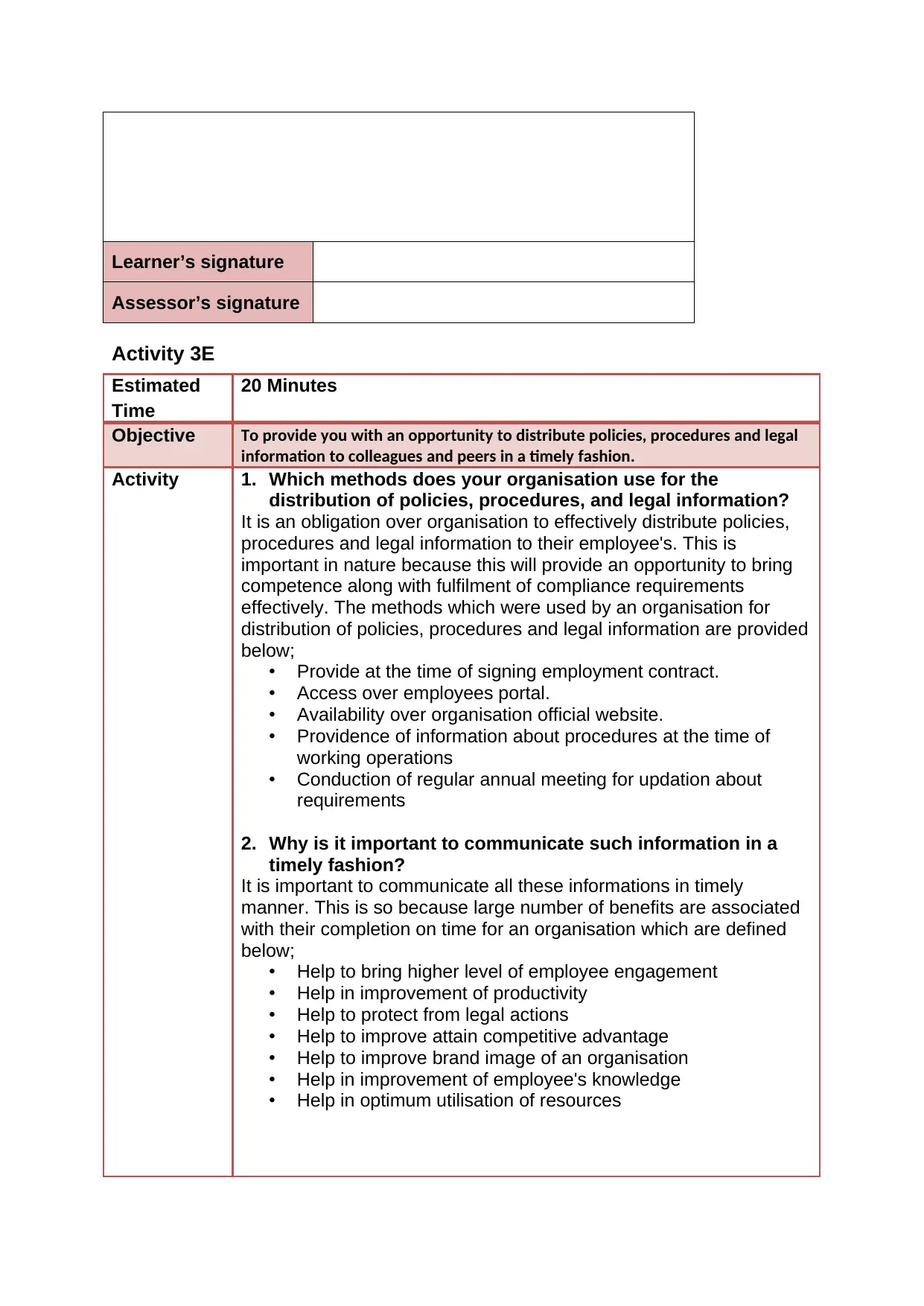
Learner’s signature
Assessor’s signature
Activity 3E
Estimated
Time
20 Minutes
Objective To provide you with an opportunity to distribute policies, procedures and legal
information to colleagues and peers in a timely fashion.
Activity 1. Which methods does your organisation use for the
distribution of policies, procedures, and legal information?
It is an obligation over organisation to effectively distribute policies,
procedures and legal information to their employee's. This is
important in nature because this will provide an opportunity to bring
competence along with fulfilment of compliance requirements
effectively. The methods which were used by an organisation for
distribution of policies, procedures and legal information are provided
below;
• Provide at the time of signing employment contract.
• Access over employees portal.
• Availability over organisation official website.
• Providence of information about procedures at the time of
working operations
• Conduction of regular annual meeting for updation about
requirements
2. Why is it important to communicate such information in a
timely fashion?
It is important to communicate all these informations in timely
manner. This is so because large number of benefits are associated
with their completion on time for an organisation which are defined
below;
• Help to bring higher level of employee engagement
• Help in improvement of productivity
• Help to protect from legal actions
• Help to improve attain competitive advantage
• Help to improve brand image of an organisation
• Help in improvement of employee's knowledge
• Help in optimum utilisation of resources
Assessor’s signature
Activity 3E
Estimated
Time
20 Minutes
Objective To provide you with an opportunity to distribute policies, procedures and legal
information to colleagues and peers in a timely fashion.
Activity 1. Which methods does your organisation use for the
distribution of policies, procedures, and legal information?
It is an obligation over organisation to effectively distribute policies,
procedures and legal information to their employee's. This is
important in nature because this will provide an opportunity to bring
competence along with fulfilment of compliance requirements
effectively. The methods which were used by an organisation for
distribution of policies, procedures and legal information are provided
below;
• Provide at the time of signing employment contract.
• Access over employees portal.
• Availability over organisation official website.
• Providence of information about procedures at the time of
working operations
• Conduction of regular annual meeting for updation about
requirements
2. Why is it important to communicate such information in a
timely fashion?
It is important to communicate all these informations in timely
manner. This is so because large number of benefits are associated
with their completion on time for an organisation which are defined
below;
• Help to bring higher level of employee engagement
• Help in improvement of productivity
• Help to protect from legal actions
• Help to improve attain competitive advantage
• Help to improve brand image of an organisation
• Help in improvement of employee's knowledge
• Help in optimum utilisation of resources
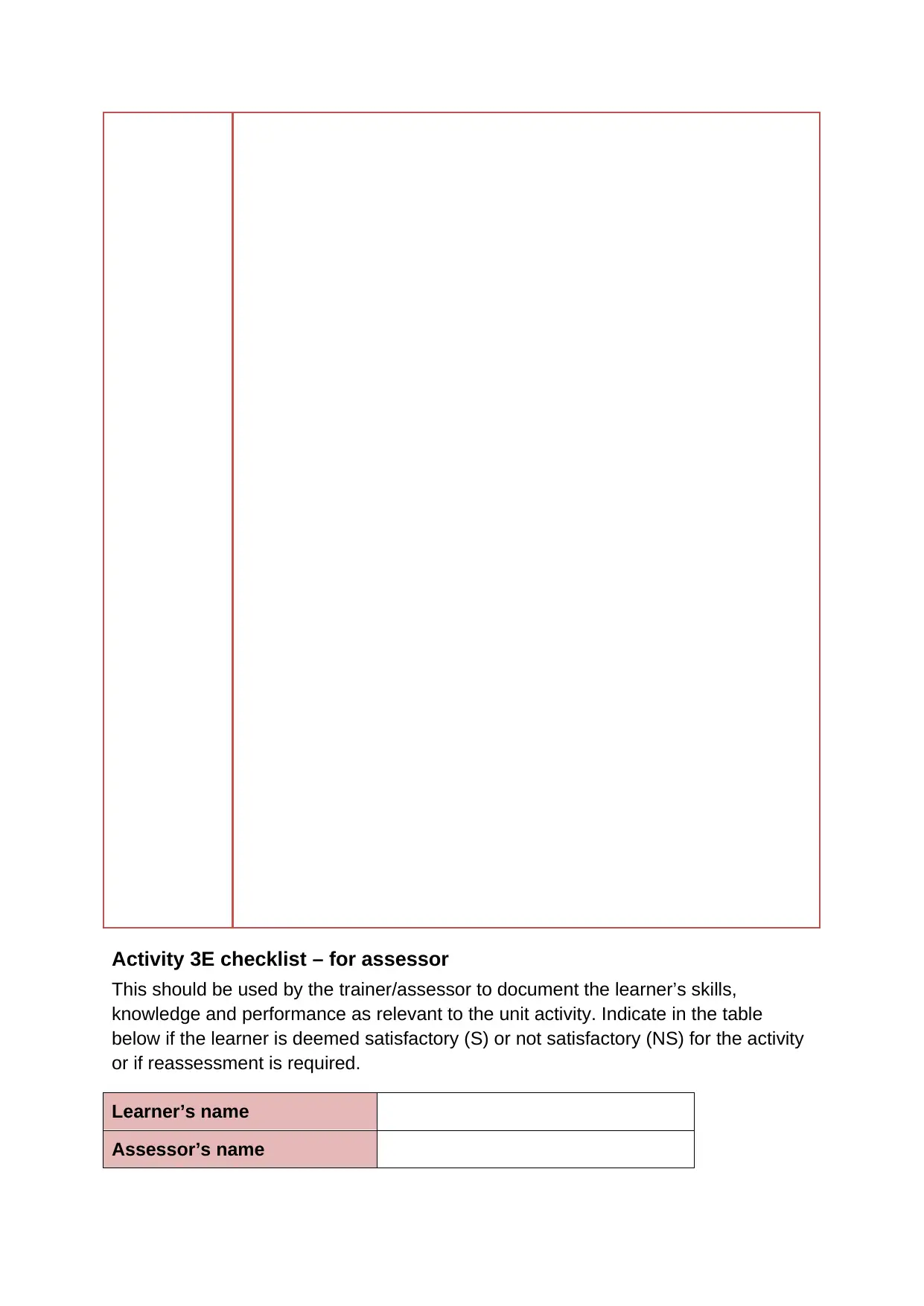
Activity 3E checklist – for assessor
This should be used by the trainer/assessor to document the learner’s skills,
knowledge and performance as relevant to the unit activity. Indicate in the table
below if the learner is deemed satisfactory (S) or not satisfactory (NS) for the activity
or if reassessment is required.
Learner’s name
Assessor’s name
This should be used by the trainer/assessor to document the learner’s skills,
knowledge and performance as relevant to the unit activity. Indicate in the table
below if the learner is deemed satisfactory (S) or not satisfactory (NS) for the activity
or if reassessment is required.
Learner’s name
Assessor’s name
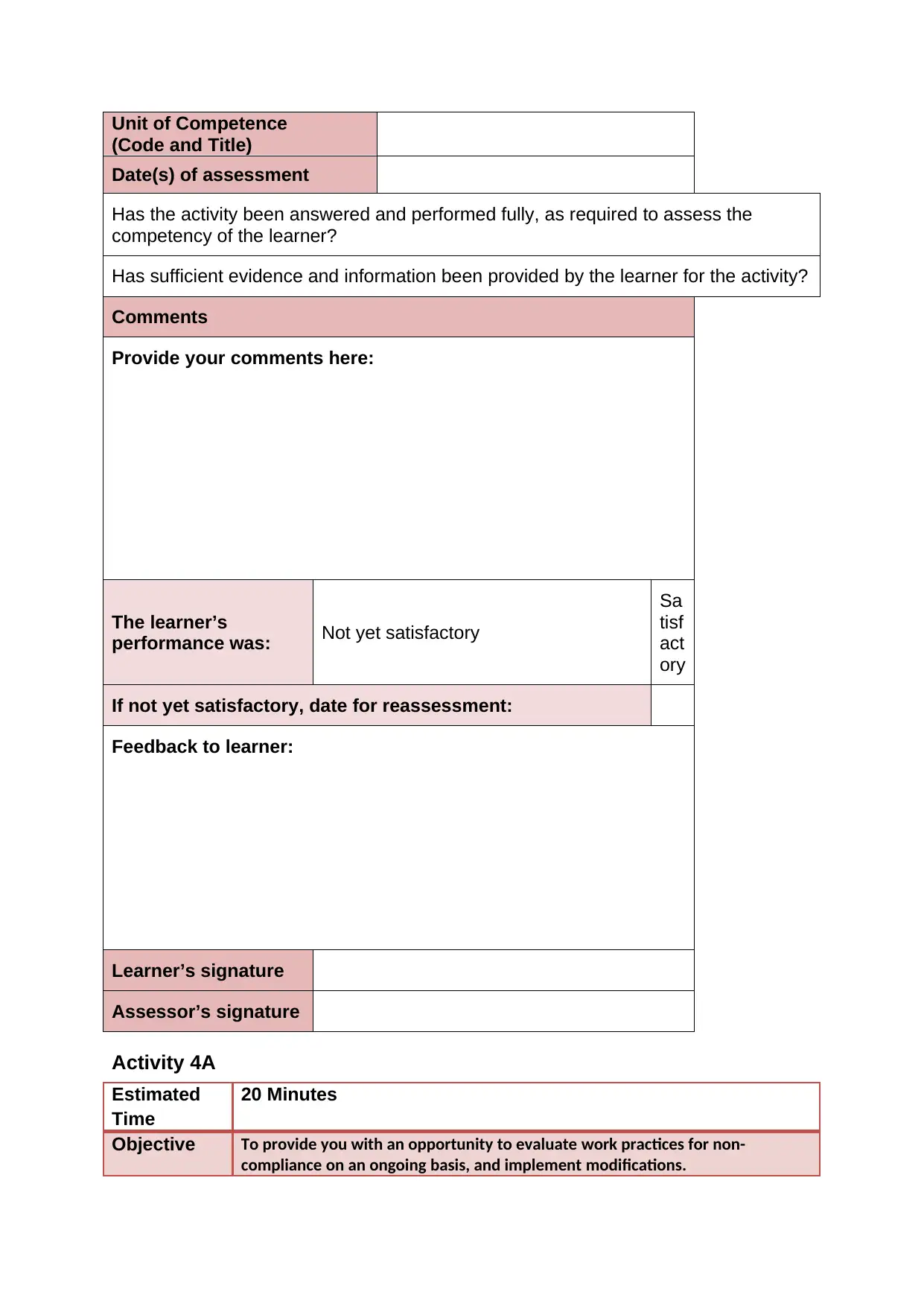
Unit of Competence
(Code and Title)
Date(s) of assessment
Has the activity been answered and performed fully, as required to assess the
competency of the learner?
Has sufficient evidence and information been provided by the learner for the activity?
Comments
Provide your comments here:
The learner’s
performance was: Not yet satisfactory
Sa
tisf
act
ory
If not yet satisfactory, date for reassessment:
Feedback to learner:
Learner’s signature
Assessor’s signature
Activity 4A
Estimated
Time
20 Minutes
Objective To provide you with an opportunity to evaluate work practices for non-
compliance on an ongoing basis, and implement modifications.
(Code and Title)
Date(s) of assessment
Has the activity been answered and performed fully, as required to assess the
competency of the learner?
Has sufficient evidence and information been provided by the learner for the activity?
Comments
Provide your comments here:
The learner’s
performance was: Not yet satisfactory
Sa
tisf
act
ory
If not yet satisfactory, date for reassessment:
Feedback to learner:
Learner’s signature
Assessor’s signature
Activity 4A
Estimated
Time
20 Minutes
Objective To provide you with an opportunity to evaluate work practices for non-
compliance on an ongoing basis, and implement modifications.
Secure Best Marks with AI Grader
Need help grading? Try our AI Grader for instant feedback on your assignments.
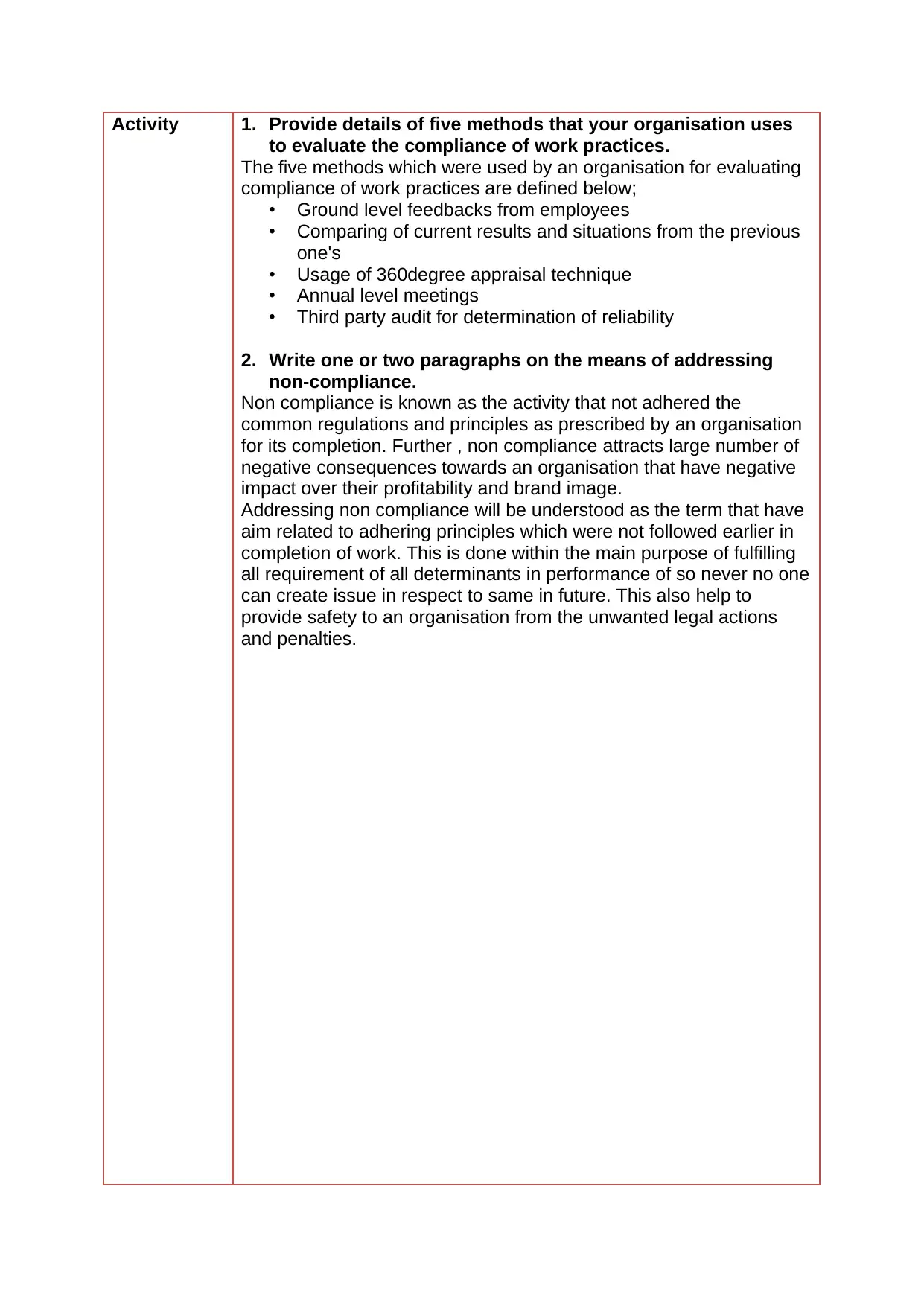
Activity 1. Provide details of five methods that your organisation uses
to evaluate the compliance of work practices.
The five methods which were used by an organisation for evaluating
compliance of work practices are defined below;
• Ground level feedbacks from employees
• Comparing of current results and situations from the previous
one's
• Usage of 360degree appraisal technique
• Annual level meetings
• Third party audit for determination of reliability
2. Write one or two paragraphs on the means of addressing
non-compliance.
Non compliance is known as the activity that not adhered the
common regulations and principles as prescribed by an organisation
for its completion. Further , non compliance attracts large number of
negative consequences towards an organisation that have negative
impact over their profitability and brand image.
Addressing non compliance will be understood as the term that have
aim related to adhering principles which were not followed earlier in
completion of work. This is done within the main purpose of fulfilling
all requirement of all determinants in performance of so never no one
can create issue in respect to same in future. This also help to
provide safety to an organisation from the unwanted legal actions
and penalties.
to evaluate the compliance of work practices.
The five methods which were used by an organisation for evaluating
compliance of work practices are defined below;
• Ground level feedbacks from employees
• Comparing of current results and situations from the previous
one's
• Usage of 360degree appraisal technique
• Annual level meetings
• Third party audit for determination of reliability
2. Write one or two paragraphs on the means of addressing
non-compliance.
Non compliance is known as the activity that not adhered the
common regulations and principles as prescribed by an organisation
for its completion. Further , non compliance attracts large number of
negative consequences towards an organisation that have negative
impact over their profitability and brand image.
Addressing non compliance will be understood as the term that have
aim related to adhering principles which were not followed earlier in
completion of work. This is done within the main purpose of fulfilling
all requirement of all determinants in performance of so never no one
can create issue in respect to same in future. This also help to
provide safety to an organisation from the unwanted legal actions
and penalties.
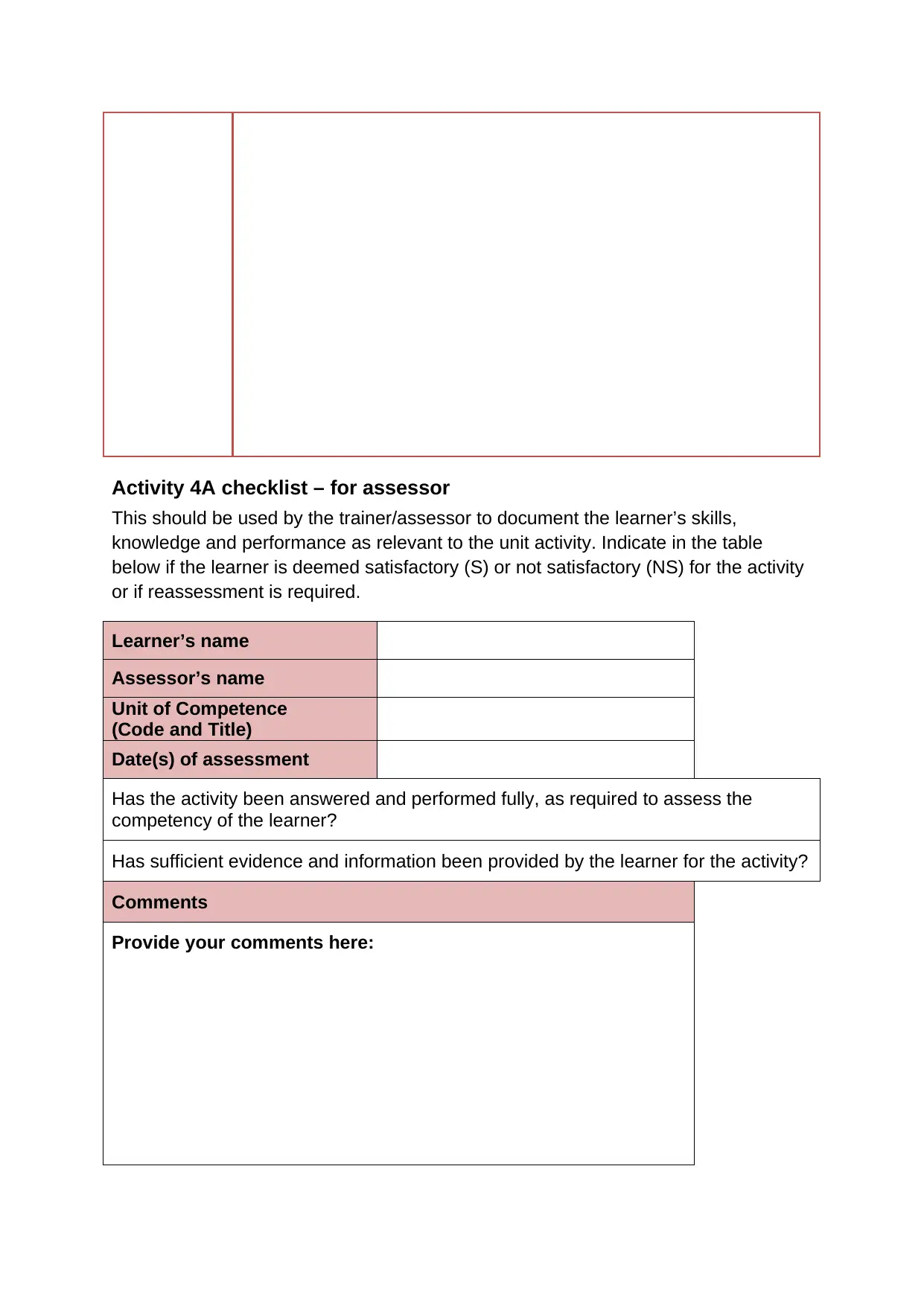
Activity 4A checklist – for assessor
This should be used by the trainer/assessor to document the learner’s skills,
knowledge and performance as relevant to the unit activity. Indicate in the table
below if the learner is deemed satisfactory (S) or not satisfactory (NS) for the activity
or if reassessment is required.
Learner’s name
Assessor’s name
Unit of Competence
(Code and Title)
Date(s) of assessment
Has the activity been answered and performed fully, as required to assess the
competency of the learner?
Has sufficient evidence and information been provided by the learner for the activity?
Comments
Provide your comments here:
This should be used by the trainer/assessor to document the learner’s skills,
knowledge and performance as relevant to the unit activity. Indicate in the table
below if the learner is deemed satisfactory (S) or not satisfactory (NS) for the activity
or if reassessment is required.
Learner’s name
Assessor’s name
Unit of Competence
(Code and Title)
Date(s) of assessment
Has the activity been answered and performed fully, as required to assess the
competency of the learner?
Has sufficient evidence and information been provided by the learner for the activity?
Comments
Provide your comments here:
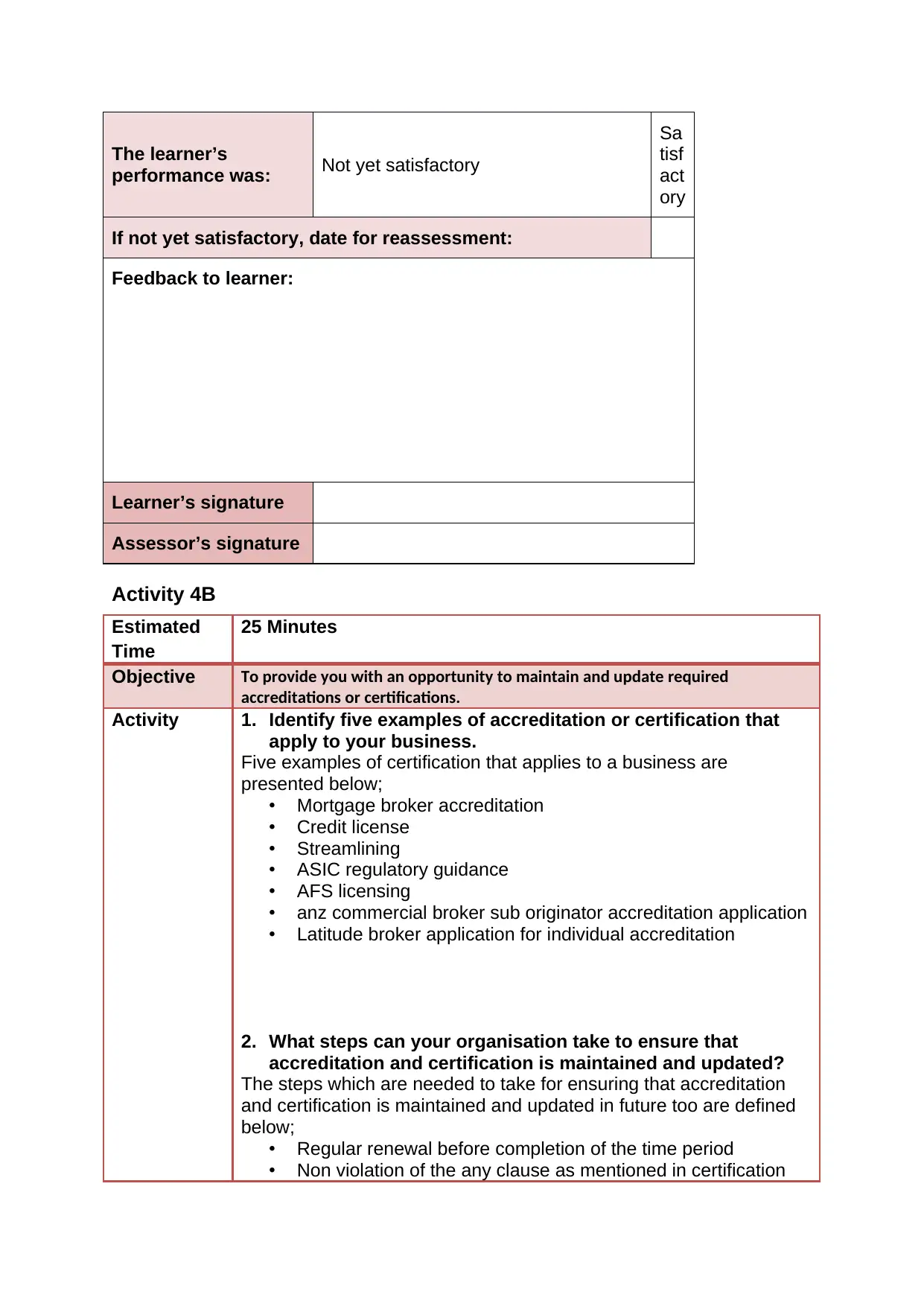
The learner’s
performance was: Not yet satisfactory
Sa
tisf
act
ory
If not yet satisfactory, date for reassessment:
Feedback to learner:
Learner’s signature
Assessor’s signature
Activity 4B
Estimated
Time
25 Minutes
Objective To provide you with an opportunity to maintain and update required
accreditations or certifications.
Activity 1. Identify five examples of accreditation or certification that
apply to your business.
Five examples of certification that applies to a business are
presented below;
• Mortgage broker accreditation
• Credit license
• Streamlining
• ASIC regulatory guidance
• AFS licensing
• anz commercial broker sub originator accreditation application
• Latitude broker application for individual accreditation
2. What steps can your organisation take to ensure that
accreditation and certification is maintained and updated?
The steps which are needed to take for ensuring that accreditation
and certification is maintained and updated in future too are defined
below;
• Regular renewal before completion of the time period
• Non violation of the any clause as mentioned in certification
performance was: Not yet satisfactory
Sa
tisf
act
ory
If not yet satisfactory, date for reassessment:
Feedback to learner:
Learner’s signature
Assessor’s signature
Activity 4B
Estimated
Time
25 Minutes
Objective To provide you with an opportunity to maintain and update required
accreditations or certifications.
Activity 1. Identify five examples of accreditation or certification that
apply to your business.
Five examples of certification that applies to a business are
presented below;
• Mortgage broker accreditation
• Credit license
• Streamlining
• ASIC regulatory guidance
• AFS licensing
• anz commercial broker sub originator accreditation application
• Latitude broker application for individual accreditation
2. What steps can your organisation take to ensure that
accreditation and certification is maintained and updated?
The steps which are needed to take for ensuring that accreditation
and certification is maintained and updated in future too are defined
below;
• Regular renewal before completion of the time period
• Non violation of the any clause as mentioned in certification
Paraphrase This Document
Need a fresh take? Get an instant paraphrase of this document with our AI Paraphraser
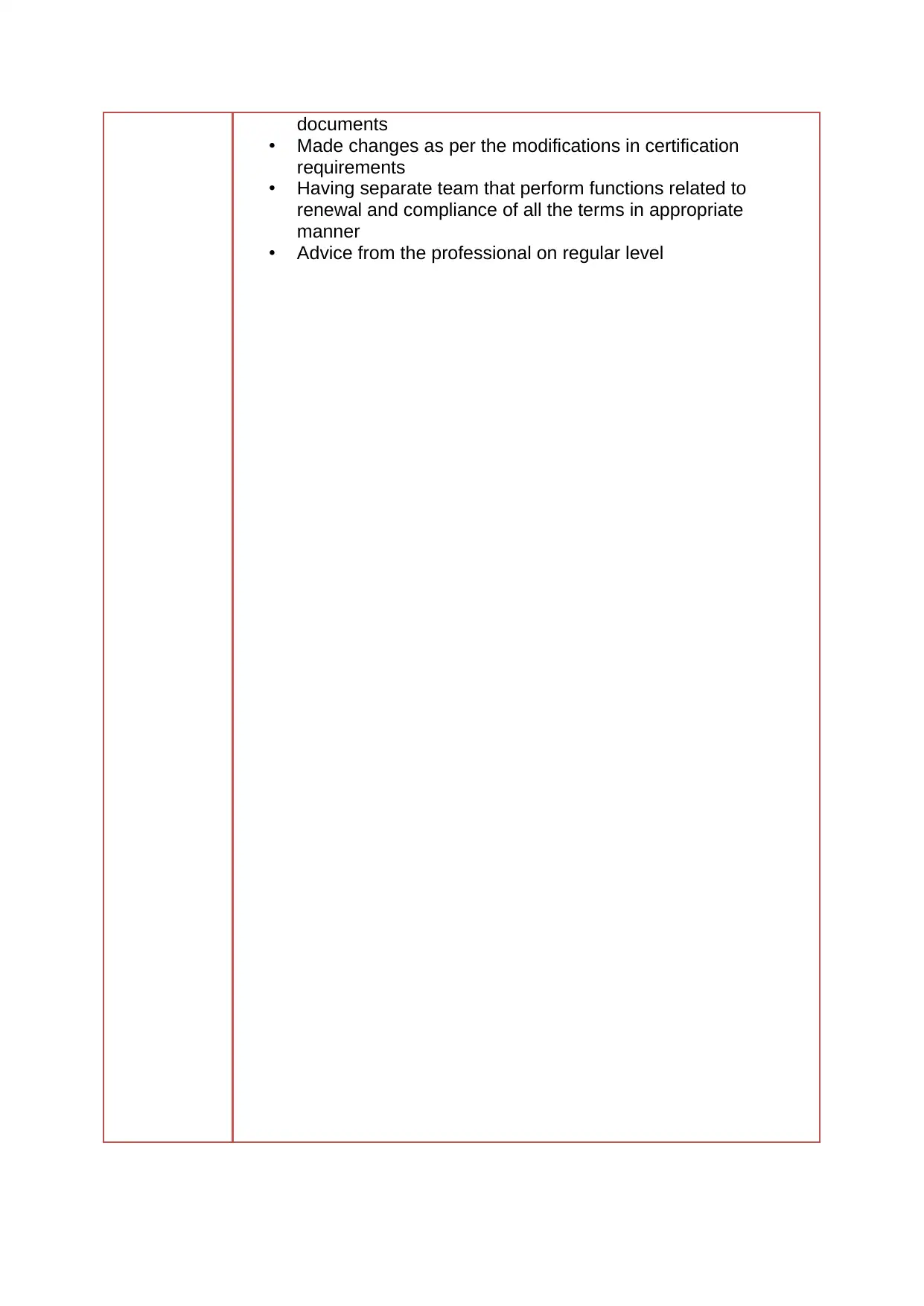
documents
• Made changes as per the modifications in certification
requirements
• Having separate team that perform functions related to
renewal and compliance of all the terms in appropriate
manner
• Advice from the professional on regular level
• Made changes as per the modifications in certification
requirements
• Having separate team that perform functions related to
renewal and compliance of all the terms in appropriate
manner
• Advice from the professional on regular level
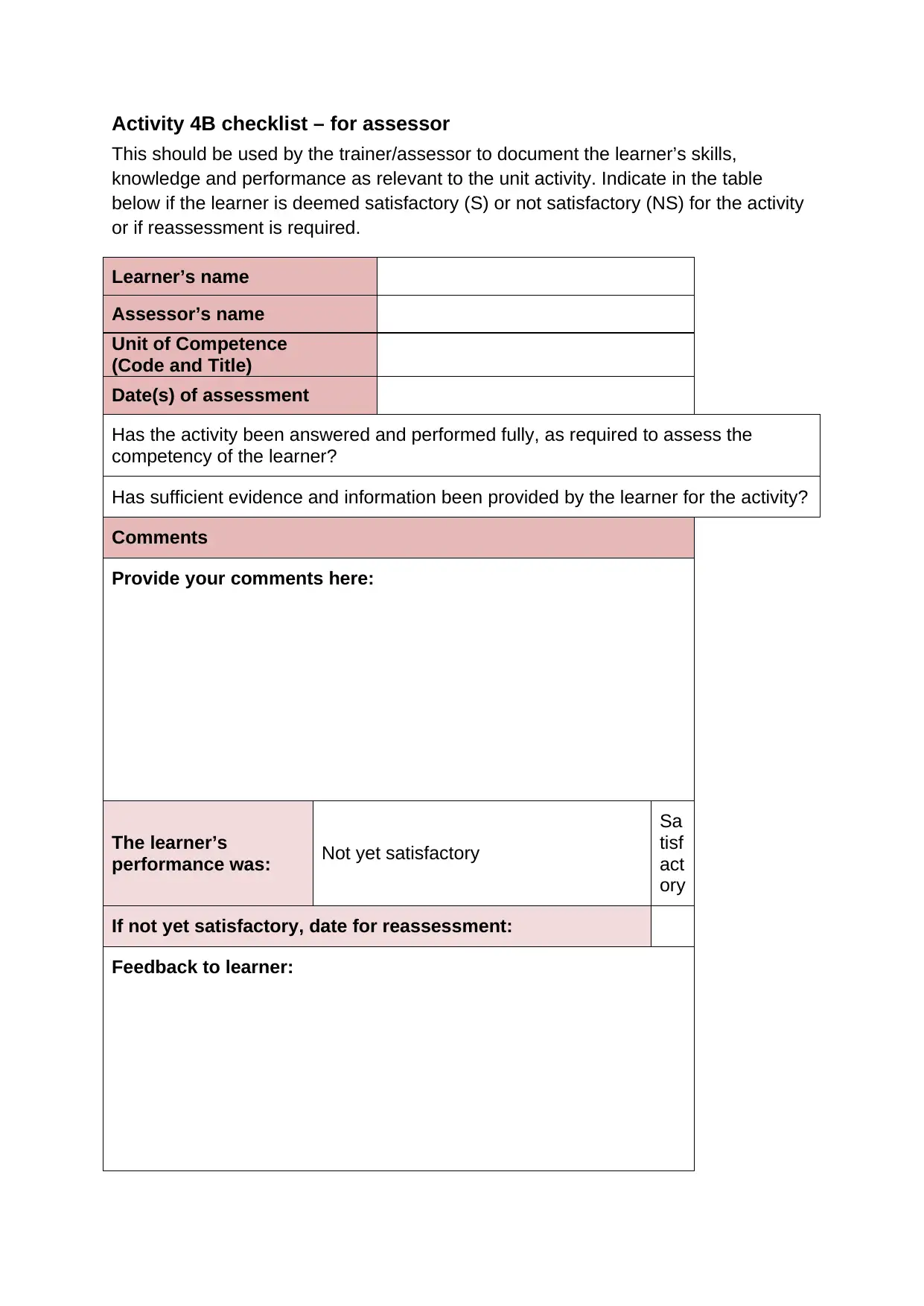
Activity 4B checklist – for assessor
This should be used by the trainer/assessor to document the learner’s skills,
knowledge and performance as relevant to the unit activity. Indicate in the table
below if the learner is deemed satisfactory (S) or not satisfactory (NS) for the activity
or if reassessment is required.
Learner’s name
Assessor’s name
Unit of Competence
(Code and Title)
Date(s) of assessment
Has the activity been answered and performed fully, as required to assess the
competency of the learner?
Has sufficient evidence and information been provided by the learner for the activity?
Comments
Provide your comments here:
The learner’s
performance was: Not yet satisfactory
Sa
tisf
act
ory
If not yet satisfactory, date for reassessment:
Feedback to learner:
This should be used by the trainer/assessor to document the learner’s skills,
knowledge and performance as relevant to the unit activity. Indicate in the table
below if the learner is deemed satisfactory (S) or not satisfactory (NS) for the activity
or if reassessment is required.
Learner’s name
Assessor’s name
Unit of Competence
(Code and Title)
Date(s) of assessment
Has the activity been answered and performed fully, as required to assess the
competency of the learner?
Has sufficient evidence and information been provided by the learner for the activity?
Comments
Provide your comments here:
The learner’s
performance was: Not yet satisfactory
Sa
tisf
act
ory
If not yet satisfactory, date for reassessment:
Feedback to learner:
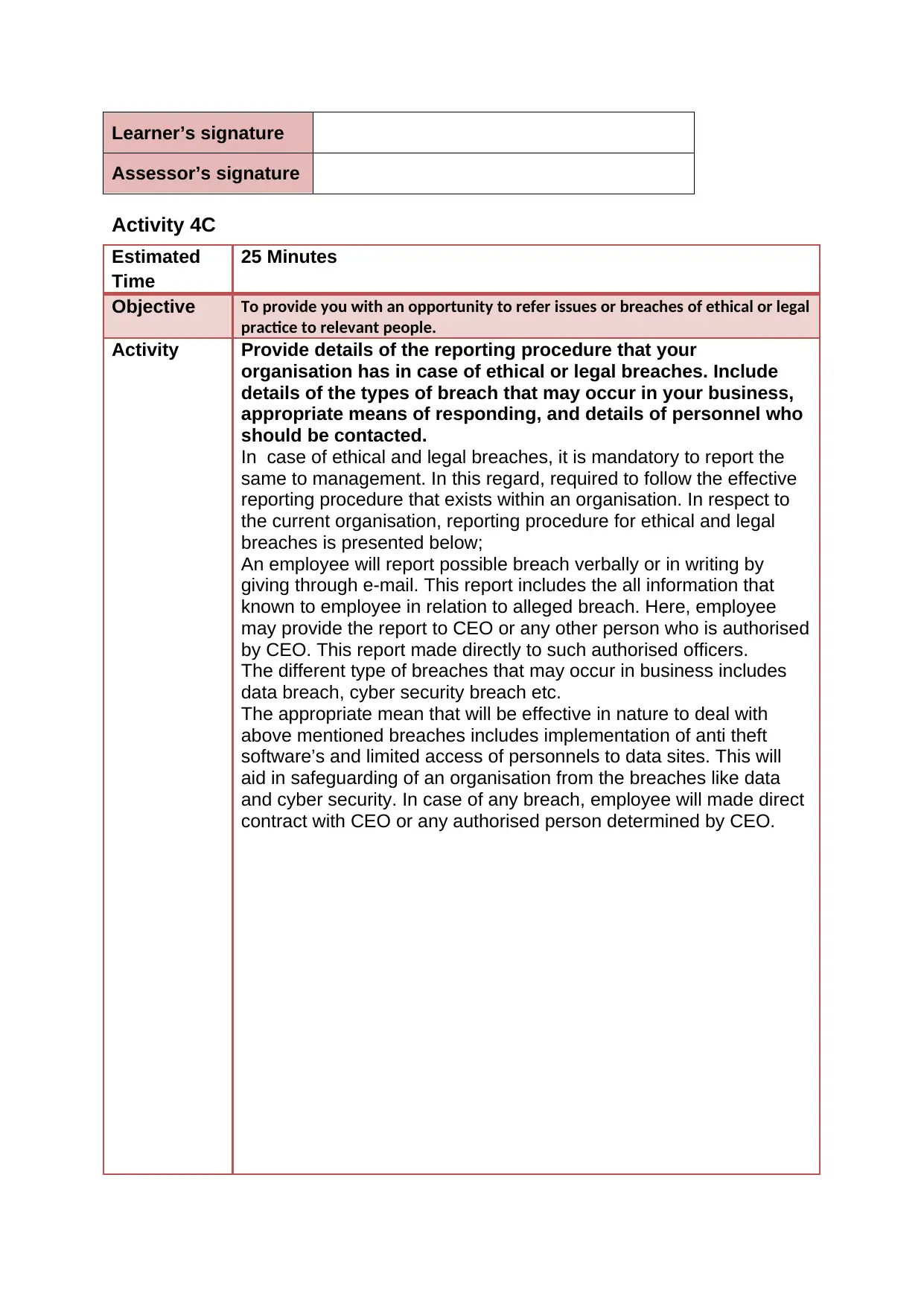
Learner’s signature
Assessor’s signature
Activity 4C
Estimated
Time
25 Minutes
Objective To provide you with an opportunity to refer issues or breaches of ethical or legal
practice to relevant people.
Activity Provide details of the reporting procedure that your
organisation has in case of ethical or legal breaches. Include
details of the types of breach that may occur in your business,
appropriate means of responding, and details of personnel who
should be contacted.
In case of ethical and legal breaches, it is mandatory to report the
same to management. In this regard, required to follow the effective
reporting procedure that exists within an organisation. In respect to
the current organisation, reporting procedure for ethical and legal
breaches is presented below;
An employee will report possible breach verbally or in writing by
giving through e-mail. This report includes the all information that
known to employee in relation to alleged breach. Here, employee
may provide the report to CEO or any other person who is authorised
by CEO. This report made directly to such authorised officers.
The different type of breaches that may occur in business includes
data breach, cyber security breach etc.
The appropriate mean that will be effective in nature to deal with
above mentioned breaches includes implementation of anti theft
software’s and limited access of personnels to data sites. This will
aid in safeguarding of an organisation from the breaches like data
and cyber security. In case of any breach, employee will made direct
contract with CEO or any authorised person determined by CEO.
Assessor’s signature
Activity 4C
Estimated
Time
25 Minutes
Objective To provide you with an opportunity to refer issues or breaches of ethical or legal
practice to relevant people.
Activity Provide details of the reporting procedure that your
organisation has in case of ethical or legal breaches. Include
details of the types of breach that may occur in your business,
appropriate means of responding, and details of personnel who
should be contacted.
In case of ethical and legal breaches, it is mandatory to report the
same to management. In this regard, required to follow the effective
reporting procedure that exists within an organisation. In respect to
the current organisation, reporting procedure for ethical and legal
breaches is presented below;
An employee will report possible breach verbally or in writing by
giving through e-mail. This report includes the all information that
known to employee in relation to alleged breach. Here, employee
may provide the report to CEO or any other person who is authorised
by CEO. This report made directly to such authorised officers.
The different type of breaches that may occur in business includes
data breach, cyber security breach etc.
The appropriate mean that will be effective in nature to deal with
above mentioned breaches includes implementation of anti theft
software’s and limited access of personnels to data sites. This will
aid in safeguarding of an organisation from the breaches like data
and cyber security. In case of any breach, employee will made direct
contract with CEO or any authorised person determined by CEO.
Secure Best Marks with AI Grader
Need help grading? Try our AI Grader for instant feedback on your assignments.

Activity 4C checklist – for assessor
This should be used by the trainer/assessor to document the learner’s skills,
knowledge and performance as relevant to the unit activity. Indicate in the table
below if the learner is deemed satisfactory (S) or not satisfactory (NS) for the activity
or if reassessment is required.
Learner’s name
Assessor’s name
Unit of Competence
(Code and Title)
Date(s) of assessment
Has the activity been answered and performed fully, as required to assess the
competency of the learner?
Has sufficient evidence and information been provided by the learner for the activity?
Comments
This should be used by the trainer/assessor to document the learner’s skills,
knowledge and performance as relevant to the unit activity. Indicate in the table
below if the learner is deemed satisfactory (S) or not satisfactory (NS) for the activity
or if reassessment is required.
Learner’s name
Assessor’s name
Unit of Competence
(Code and Title)
Date(s) of assessment
Has the activity been answered and performed fully, as required to assess the
competency of the learner?
Has sufficient evidence and information been provided by the learner for the activity?
Comments

Provide your comments here:
The learner’s
performance was: Not yet satisfactory
Sa
tisf
act
ory
If not yet satisfactory, date for reassessment:
Feedback to learner:
Learner’s signature
Assessor’s signature
Activity 5A
Estimated
Time
20 Minutes
Objective To provide you with an opportunity to identify and use opportunities to
maintain knowledge of current and emerging legal requirements and ethical
issues.
Activity Detail four methods that could be used for the identification of
legal and ethical issues relevant to your business.
The four methods that could be used for identifying legal and ethical
issues within an organisation are defined below;
• Regular audit of organisational activities
• Appraisal of the performance of all employees
• Comparing the results with standards
• Taking help of legal advisors
• Taking feedbacks from the employees at ground level
• Conducting regular annual meetings
The learner’s
performance was: Not yet satisfactory
Sa
tisf
act
ory
If not yet satisfactory, date for reassessment:
Feedback to learner:
Learner’s signature
Assessor’s signature
Activity 5A
Estimated
Time
20 Minutes
Objective To provide you with an opportunity to identify and use opportunities to
maintain knowledge of current and emerging legal requirements and ethical
issues.
Activity Detail four methods that could be used for the identification of
legal and ethical issues relevant to your business.
The four methods that could be used for identifying legal and ethical
issues within an organisation are defined below;
• Regular audit of organisational activities
• Appraisal of the performance of all employees
• Comparing the results with standards
• Taking help of legal advisors
• Taking feedbacks from the employees at ground level
• Conducting regular annual meetings

Activity 5A checklist – for assessor
This should be used by the trainer/assessor to document the learner’s skills,
knowledge and performance as relevant to the unit activity. Indicate in the table
This should be used by the trainer/assessor to document the learner’s skills,
knowledge and performance as relevant to the unit activity. Indicate in the table
Paraphrase This Document
Need a fresh take? Get an instant paraphrase of this document with our AI Paraphraser
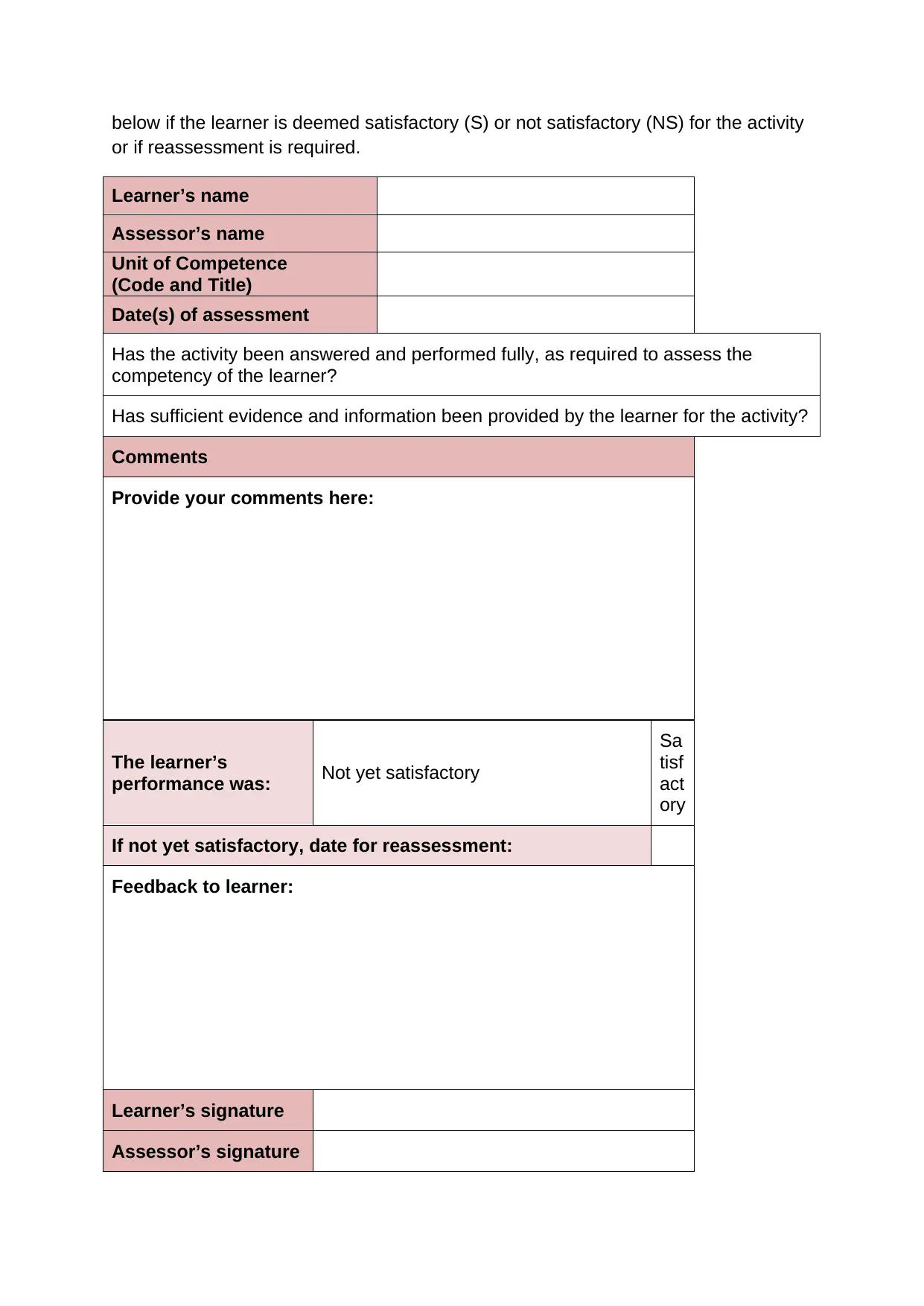
below if the learner is deemed satisfactory (S) or not satisfactory (NS) for the activity
or if reassessment is required.
Learner’s name
Assessor’s name
Unit of Competence
(Code and Title)
Date(s) of assessment
Has the activity been answered and performed fully, as required to assess the
competency of the learner?
Has sufficient evidence and information been provided by the learner for the activity?
Comments
Provide your comments here:
The learner’s
performance was: Not yet satisfactory
Sa
tisf
act
ory
If not yet satisfactory, date for reassessment:
Feedback to learner:
Learner’s signature
Assessor’s signature
or if reassessment is required.
Learner’s name
Assessor’s name
Unit of Competence
(Code and Title)
Date(s) of assessment
Has the activity been answered and performed fully, as required to assess the
competency of the learner?
Has sufficient evidence and information been provided by the learner for the activity?
Comments
Provide your comments here:
The learner’s
performance was: Not yet satisfactory
Sa
tisf
act
ory
If not yet satisfactory, date for reassessment:
Feedback to learner:
Learner’s signature
Assessor’s signature
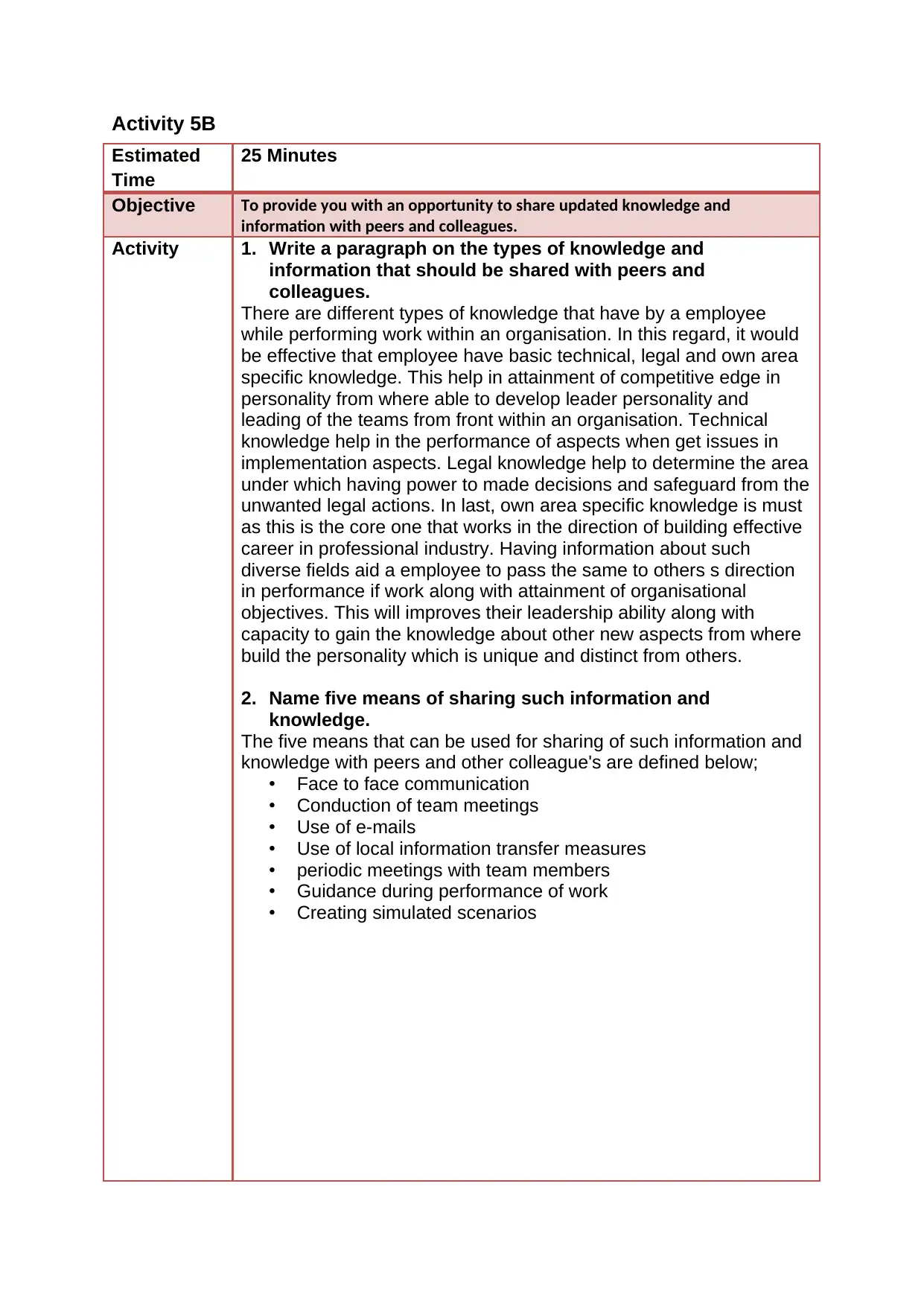
Activity 5B
Estimated
Time
25 Minutes
Objective To provide you with an opportunity to share updated knowledge and
information with peers and colleagues.
Activity 1. Write a paragraph on the types of knowledge and
information that should be shared with peers and
colleagues.
There are different types of knowledge that have by a employee
while performing work within an organisation. In this regard, it would
be effective that employee have basic technical, legal and own area
specific knowledge. This help in attainment of competitive edge in
personality from where able to develop leader personality and
leading of the teams from front within an organisation. Technical
knowledge help in the performance of aspects when get issues in
implementation aspects. Legal knowledge help to determine the area
under which having power to made decisions and safeguard from the
unwanted legal actions. In last, own area specific knowledge is must
as this is the core one that works in the direction of building effective
career in professional industry. Having information about such
diverse fields aid a employee to pass the same to others s direction
in performance if work along with attainment of organisational
objectives. This will improves their leadership ability along with
capacity to gain the knowledge about other new aspects from where
build the personality which is unique and distinct from others.
2. Name five means of sharing such information and
knowledge.
The five means that can be used for sharing of such information and
knowledge with peers and other colleague's are defined below;
• Face to face communication
• Conduction of team meetings
• Use of e-mails
• Use of local information transfer measures
• periodic meetings with team members
• Guidance during performance of work
• Creating simulated scenarios
Estimated
Time
25 Minutes
Objective To provide you with an opportunity to share updated knowledge and
information with peers and colleagues.
Activity 1. Write a paragraph on the types of knowledge and
information that should be shared with peers and
colleagues.
There are different types of knowledge that have by a employee
while performing work within an organisation. In this regard, it would
be effective that employee have basic technical, legal and own area
specific knowledge. This help in attainment of competitive edge in
personality from where able to develop leader personality and
leading of the teams from front within an organisation. Technical
knowledge help in the performance of aspects when get issues in
implementation aspects. Legal knowledge help to determine the area
under which having power to made decisions and safeguard from the
unwanted legal actions. In last, own area specific knowledge is must
as this is the core one that works in the direction of building effective
career in professional industry. Having information about such
diverse fields aid a employee to pass the same to others s direction
in performance if work along with attainment of organisational
objectives. This will improves their leadership ability along with
capacity to gain the knowledge about other new aspects from where
build the personality which is unique and distinct from others.
2. Name five means of sharing such information and
knowledge.
The five means that can be used for sharing of such information and
knowledge with peers and other colleague's are defined below;
• Face to face communication
• Conduction of team meetings
• Use of e-mails
• Use of local information transfer measures
• periodic meetings with team members
• Guidance during performance of work
• Creating simulated scenarios
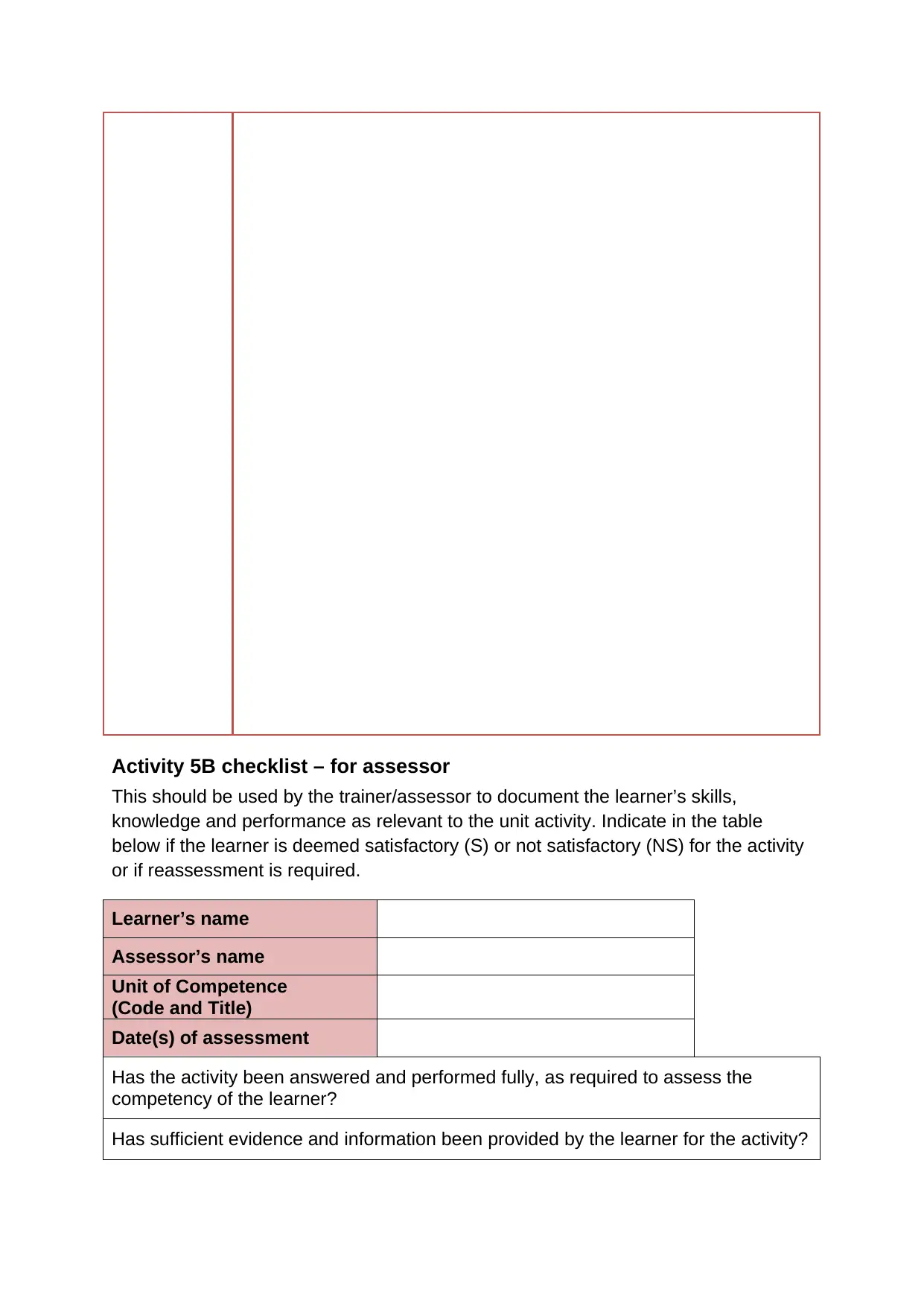
Activity 5B checklist – for assessor
This should be used by the trainer/assessor to document the learner’s skills,
knowledge and performance as relevant to the unit activity. Indicate in the table
below if the learner is deemed satisfactory (S) or not satisfactory (NS) for the activity
or if reassessment is required.
Learner’s name
Assessor’s name
Unit of Competence
(Code and Title)
Date(s) of assessment
Has the activity been answered and performed fully, as required to assess the
competency of the learner?
Has sufficient evidence and information been provided by the learner for the activity?
This should be used by the trainer/assessor to document the learner’s skills,
knowledge and performance as relevant to the unit activity. Indicate in the table
below if the learner is deemed satisfactory (S) or not satisfactory (NS) for the activity
or if reassessment is required.
Learner’s name
Assessor’s name
Unit of Competence
(Code and Title)
Date(s) of assessment
Has the activity been answered and performed fully, as required to assess the
competency of the learner?
Has sufficient evidence and information been provided by the learner for the activity?
Secure Best Marks with AI Grader
Need help grading? Try our AI Grader for instant feedback on your assignments.

Comments
Provide your comments here:
The learner’s
performance was: Not yet satisfactory
Sa
tisf
act
ory
If not yet satisfactory, date for reassessment:
Feedback to learner:
Learner’s signature
Assessor’s signature
Activity 5C
Estimated
Time
30 Minutes
Objective To provide you with an opportunity to pro-actively engage in process of review
and improvement.
Activity Outline the ways in which your organisation reviews and makes
improvements for the assurance of ethical and legal
compliance. Include details of research that is undertaken,
methods of evaluating success, and development of strategies
for continued compliance.
The ways on the basis of which an organisation reviews and makes
improvements for the assurance of ethical and legal compliance are
defined below;
• Review will be done by ascertaining information on standards
Provide your comments here:
The learner’s
performance was: Not yet satisfactory
Sa
tisf
act
ory
If not yet satisfactory, date for reassessment:
Feedback to learner:
Learner’s signature
Assessor’s signature
Activity 5C
Estimated
Time
30 Minutes
Objective To provide you with an opportunity to pro-actively engage in process of review
and improvement.
Activity Outline the ways in which your organisation reviews and makes
improvements for the assurance of ethical and legal
compliance. Include details of research that is undertaken,
methods of evaluating success, and development of strategies
for continued compliance.
The ways on the basis of which an organisation reviews and makes
improvements for the assurance of ethical and legal compliance are
defined below;
• Review will be done by ascertaining information on standards
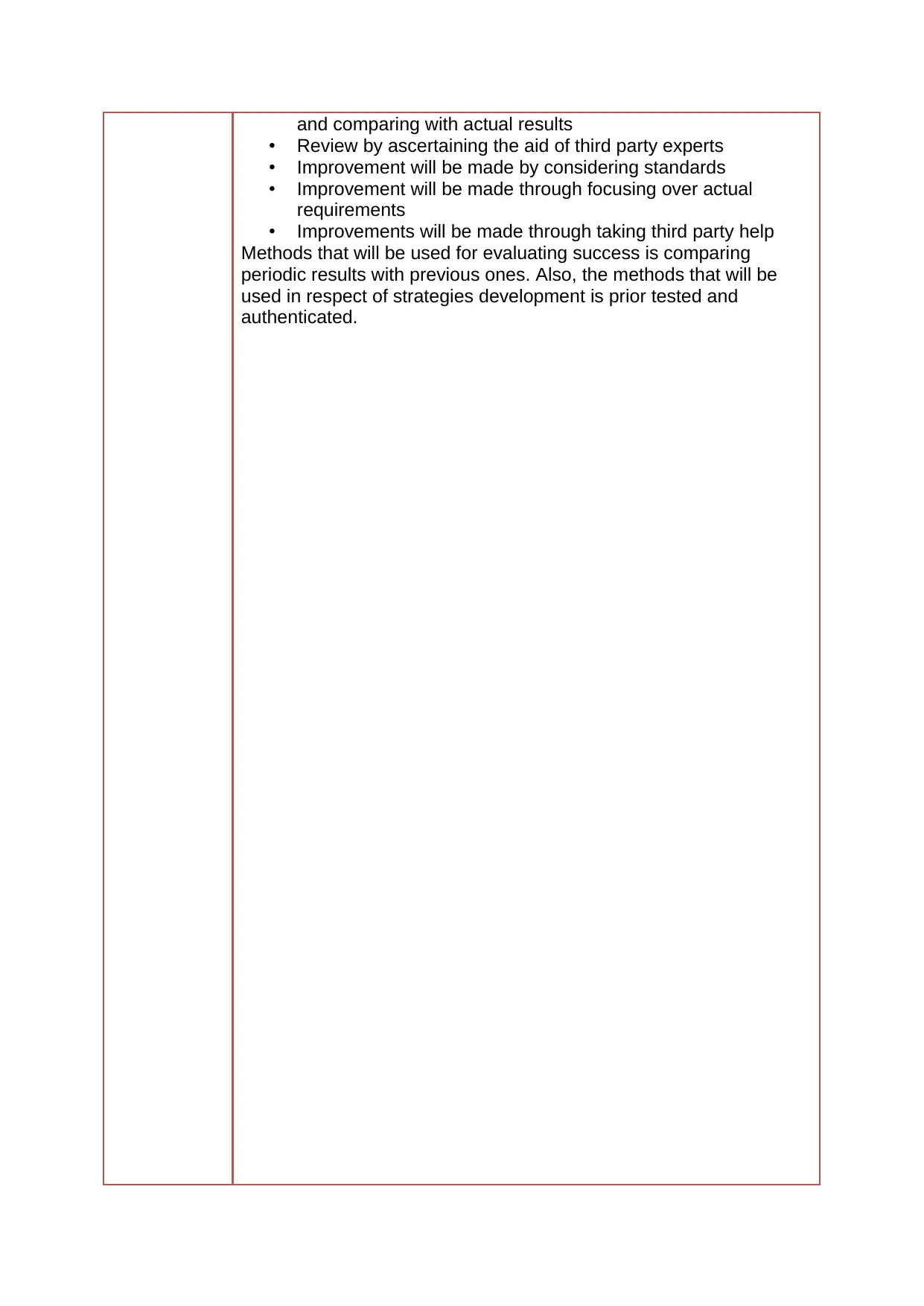
and comparing with actual results
• Review by ascertaining the aid of third party experts
• Improvement will be made by considering standards
• Improvement will be made through focusing over actual
requirements
• Improvements will be made through taking third party help
Methods that will be used for evaluating success is comparing
periodic results with previous ones. Also, the methods that will be
used in respect of strategies development is prior tested and
authenticated.
• Review by ascertaining the aid of third party experts
• Improvement will be made by considering standards
• Improvement will be made through focusing over actual
requirements
• Improvements will be made through taking third party help
Methods that will be used for evaluating success is comparing
periodic results with previous ones. Also, the methods that will be
used in respect of strategies development is prior tested and
authenticated.
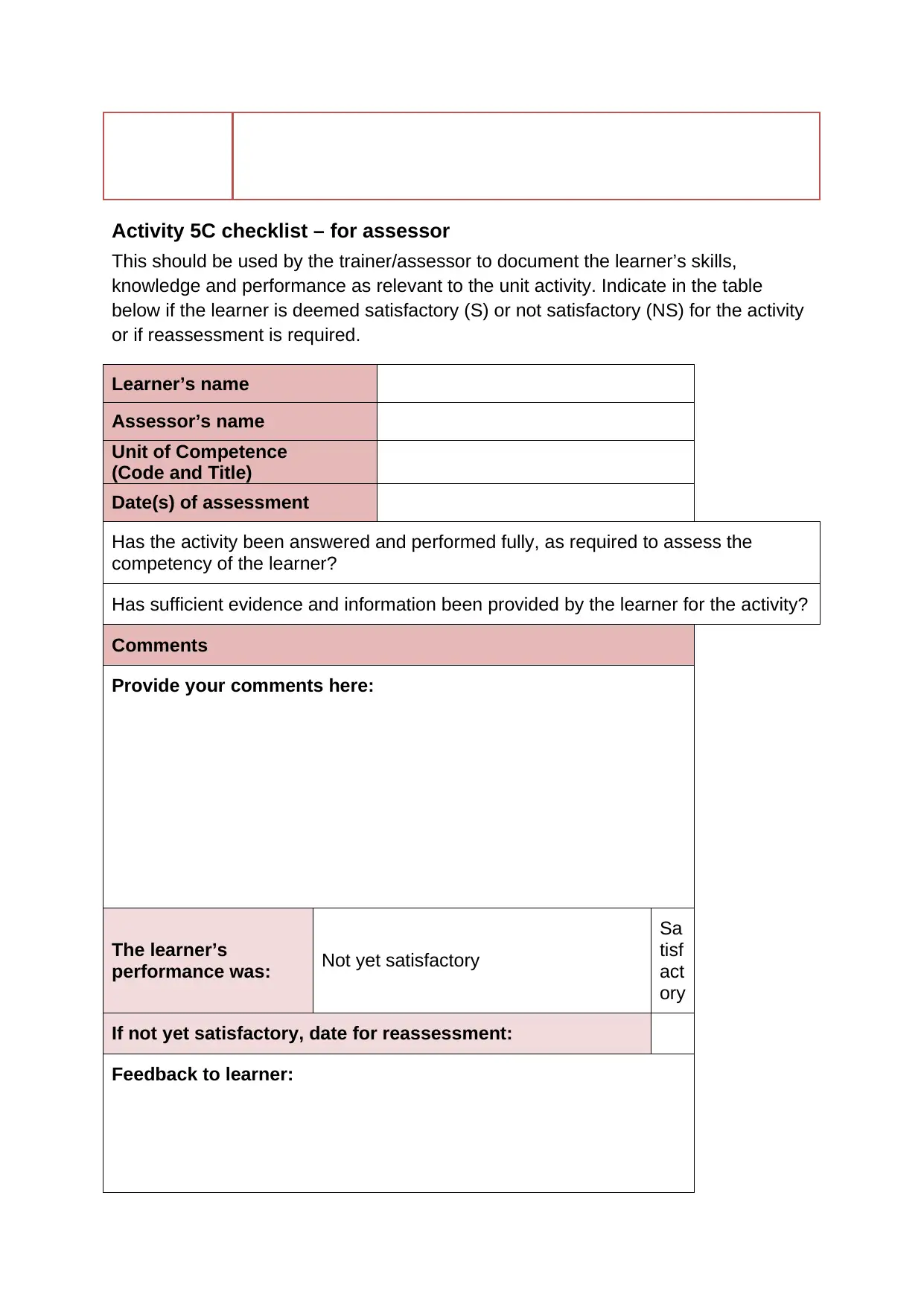
Activity 5C checklist – for assessor
This should be used by the trainer/assessor to document the learner’s skills,
knowledge and performance as relevant to the unit activity. Indicate in the table
below if the learner is deemed satisfactory (S) or not satisfactory (NS) for the activity
or if reassessment is required.
Learner’s name
Assessor’s name
Unit of Competence
(Code and Title)
Date(s) of assessment
Has the activity been answered and performed fully, as required to assess the
competency of the learner?
Has sufficient evidence and information been provided by the learner for the activity?
Comments
Provide your comments here:
The learner’s
performance was: Not yet satisfactory
Sa
tisf
act
ory
If not yet satisfactory, date for reassessment:
Feedback to learner:
This should be used by the trainer/assessor to document the learner’s skills,
knowledge and performance as relevant to the unit activity. Indicate in the table
below if the learner is deemed satisfactory (S) or not satisfactory (NS) for the activity
or if reassessment is required.
Learner’s name
Assessor’s name
Unit of Competence
(Code and Title)
Date(s) of assessment
Has the activity been answered and performed fully, as required to assess the
competency of the learner?
Has sufficient evidence and information been provided by the learner for the activity?
Comments
Provide your comments here:
The learner’s
performance was: Not yet satisfactory
Sa
tisf
act
ory
If not yet satisfactory, date for reassessment:
Feedback to learner:
Paraphrase This Document
Need a fresh take? Get an instant paraphrase of this document with our AI Paraphraser
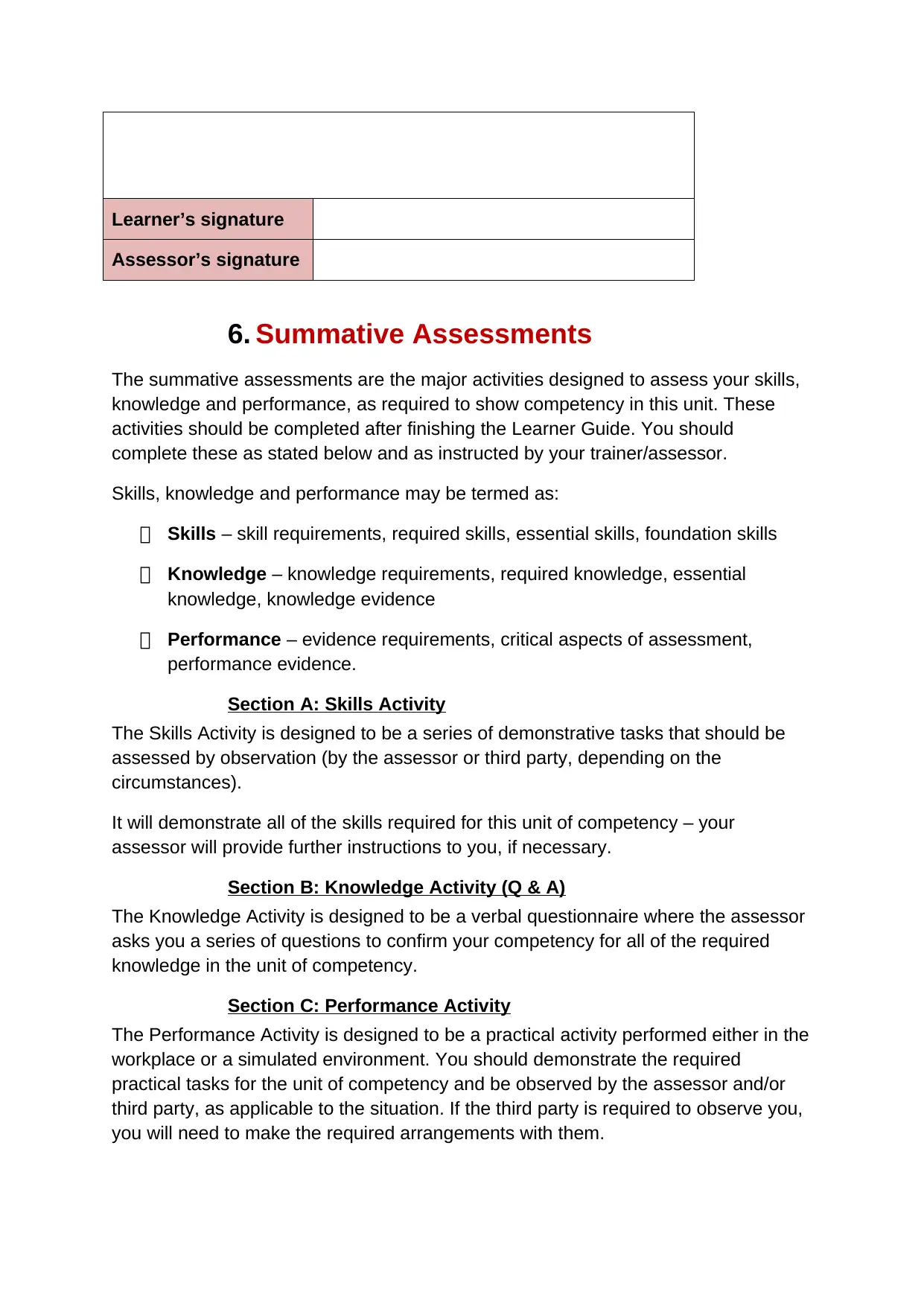
Learner’s signature
Assessor’s signature
6. Summative Assessments
The summative assessments are the major activities designed to assess your skills,
knowledge and performance, as required to show competency in this unit. These
activities should be completed after finishing the Learner Guide. You should
complete these as stated below and as instructed by your trainer/assessor.
Skills, knowledge and performance may be termed as:
Skills – skill requirements, required skills, essential skills, foundation skills
Knowledge – knowledge requirements, required knowledge, essential
knowledge, knowledge evidence
Performance – evidence requirements, critical aspects of assessment,
performance evidence.
Section A: Skills Activity
The Skills Activity is designed to be a series of demonstrative tasks that should be
assessed by observation (by the assessor or third party, depending on the
circumstances).
It will demonstrate all of the skills required for this unit of competency – your
assessor will provide further instructions to you, if necessary.
Section B: Knowledge Activity (Q & A)
The Knowledge Activity is designed to be a verbal questionnaire where the assessor
asks you a series of questions to confirm your competency for all of the required
knowledge in the unit of competency.
Section C: Performance Activity
The Performance Activity is designed to be a practical activity performed either in the
workplace or a simulated environment. You should demonstrate the required
practical tasks for the unit of competency and be observed by the assessor and/or
third party, as applicable to the situation. If the third party is required to observe you,
you will need to make the required arrangements with them.
Assessor’s signature
6. Summative Assessments
The summative assessments are the major activities designed to assess your skills,
knowledge and performance, as required to show competency in this unit. These
activities should be completed after finishing the Learner Guide. You should
complete these as stated below and as instructed by your trainer/assessor.
Skills, knowledge and performance may be termed as:
Skills – skill requirements, required skills, essential skills, foundation skills
Knowledge – knowledge requirements, required knowledge, essential
knowledge, knowledge evidence
Performance – evidence requirements, critical aspects of assessment,
performance evidence.
Section A: Skills Activity
The Skills Activity is designed to be a series of demonstrative tasks that should be
assessed by observation (by the assessor or third party, depending on the
circumstances).
It will demonstrate all of the skills required for this unit of competency – your
assessor will provide further instructions to you, if necessary.
Section B: Knowledge Activity (Q & A)
The Knowledge Activity is designed to be a verbal questionnaire where the assessor
asks you a series of questions to confirm your competency for all of the required
knowledge in the unit of competency.
Section C: Performance Activity
The Performance Activity is designed to be a practical activity performed either in the
workplace or a simulated environment. You should demonstrate the required
practical tasks for the unit of competency and be observed by the assessor and/or
third party, as applicable to the situation. If the third party is required to observe you,
you will need to make the required arrangements with them.

If necessary for the activities, you should attached completed written answers,
portfolios or any evidence of competency to this workbook.
portfolios or any evidence of competency to this workbook.
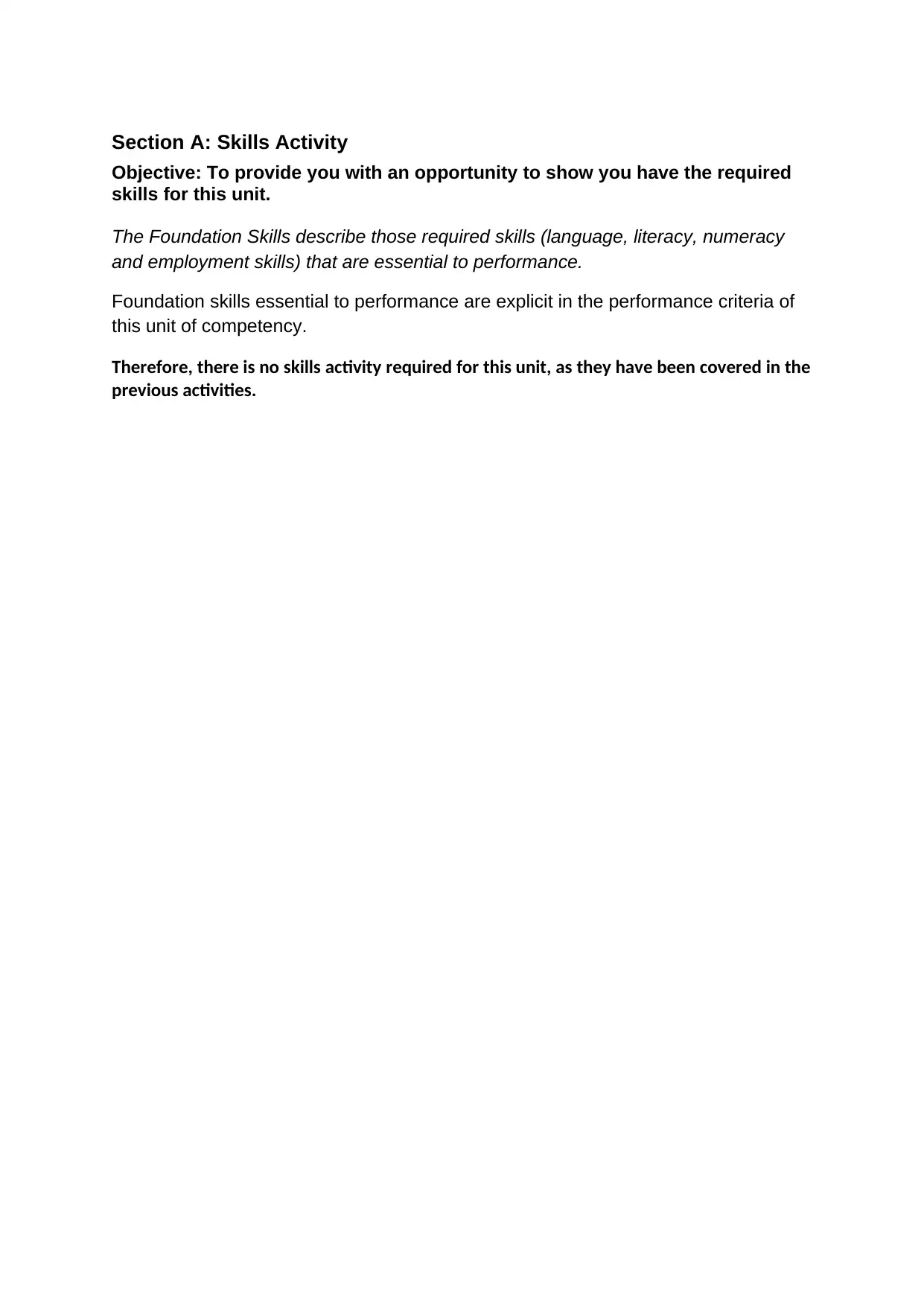
Section A: Skills Activity
Objective: To provide you with an opportunity to show you have the required
skills for this unit.
The Foundation Skills describe those required skills (language, literacy, numeracy
and employment skills) that are essential to performance.
Foundation skills essential to performance are explicit in the performance criteria of
this unit of competency.
Therefore, there is no skills activity required for this unit, as they have been covered in the
previous activities.
Objective: To provide you with an opportunity to show you have the required
skills for this unit.
The Foundation Skills describe those required skills (language, literacy, numeracy
and employment skills) that are essential to performance.
Foundation skills essential to performance are explicit in the performance criteria of
this unit of competency.
Therefore, there is no skills activity required for this unit, as they have been covered in the
previous activities.
Secure Best Marks with AI Grader
Need help grading? Try our AI Grader for instant feedback on your assignments.
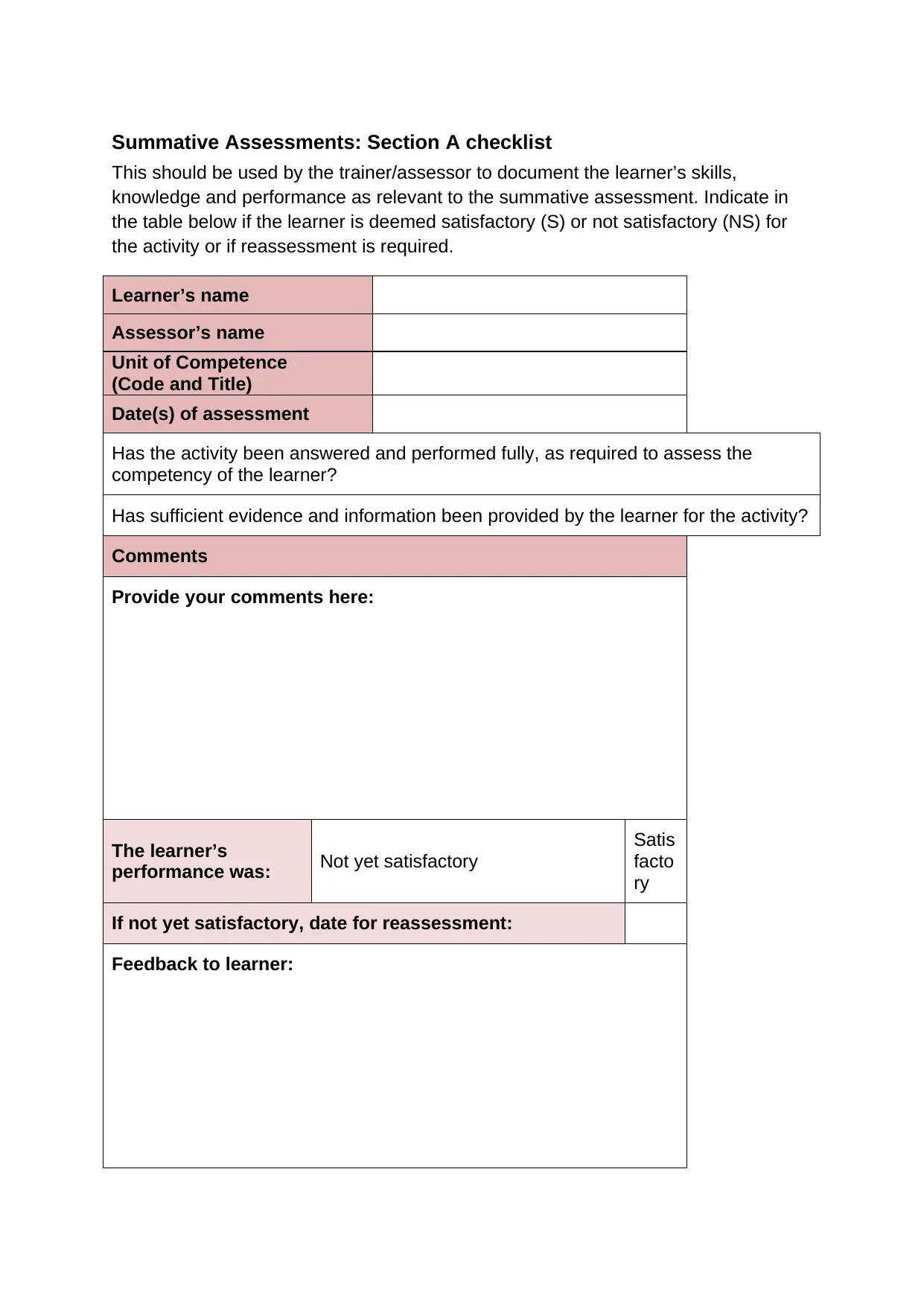
Summative Assessments: Section A checklist
This should be used by the trainer/assessor to document the learner’s skills,
knowledge and performance as relevant to the summative assessment. Indicate in
the table below if the learner is deemed satisfactory (S) or not satisfactory (NS) for
the activity or if reassessment is required.
Learner’s name
Assessor’s name
Unit of Competence
(Code and Title)
Date(s) of assessment
Has the activity been answered and performed fully, as required to assess the
competency of the learner?
Has sufficient evidence and information been provided by the learner for the activity?
Comments
Provide your comments here:
The learner’s
performance was: Not yet satisfactory
Satis
facto
ry
If not yet satisfactory, date for reassessment:
Feedback to learner:
This should be used by the trainer/assessor to document the learner’s skills,
knowledge and performance as relevant to the summative assessment. Indicate in
the table below if the learner is deemed satisfactory (S) or not satisfactory (NS) for
the activity or if reassessment is required.
Learner’s name
Assessor’s name
Unit of Competence
(Code and Title)
Date(s) of assessment
Has the activity been answered and performed fully, as required to assess the
competency of the learner?
Has sufficient evidence and information been provided by the learner for the activity?
Comments
Provide your comments here:
The learner’s
performance was: Not yet satisfactory
Satis
facto
ry
If not yet satisfactory, date for reassessment:
Feedback to learner:
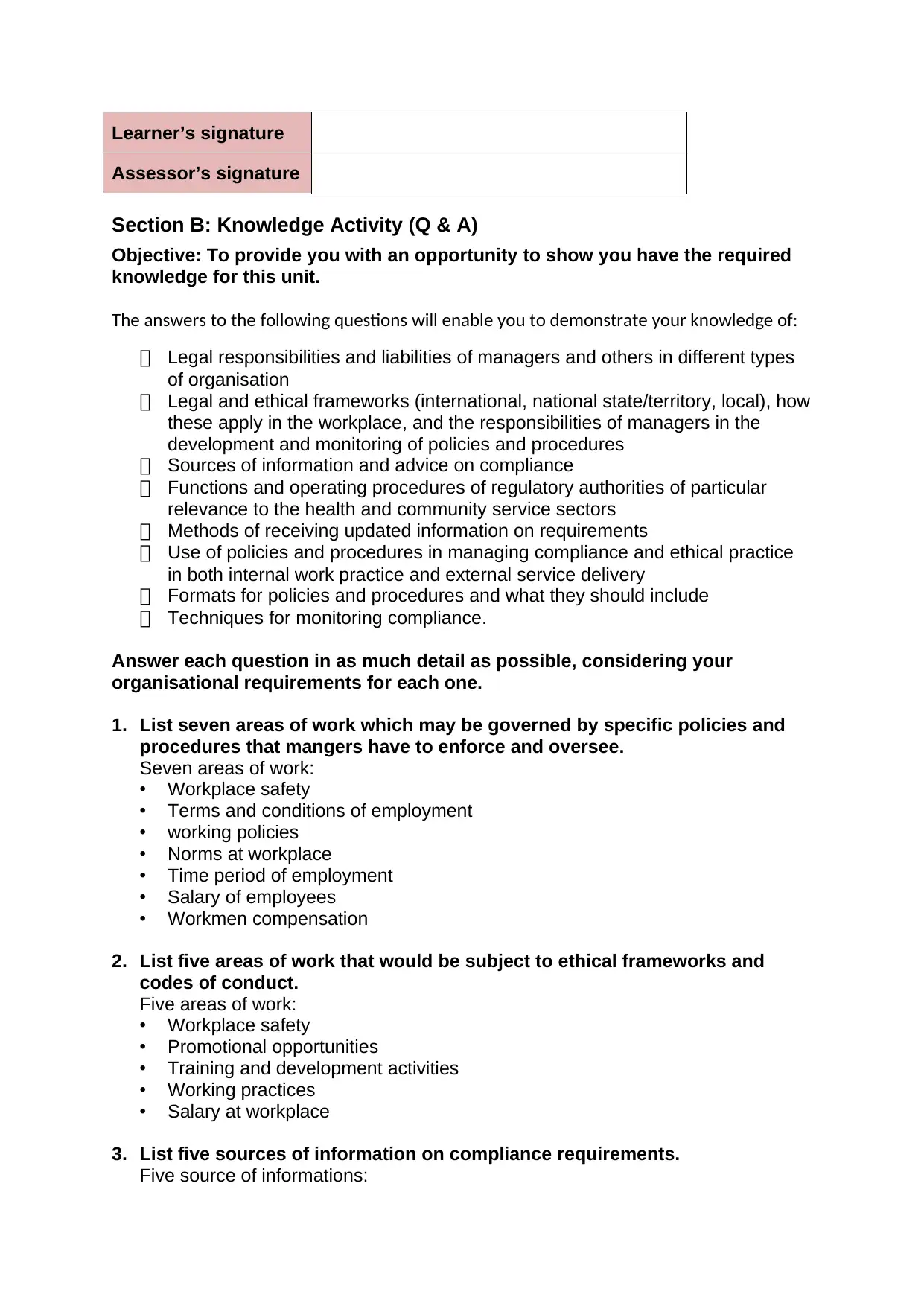
Learner’s signature
Assessor’s signature
Section B: Knowledge Activity (Q & A)
Objective: To provide you with an opportunity to show you have the required
knowledge for this unit.
The answers to the following questions will enable you to demonstrate your knowledge of:
Legal responsibilities and liabilities of managers and others in different types
of organisation
Legal and ethical frameworks (international, national state/territory, local), how
these apply in the workplace, and the responsibilities of managers in the
development and monitoring of policies and procedures
Sources of information and advice on compliance
Functions and operating procedures of regulatory authorities of particular
relevance to the health and community service sectors
Methods of receiving updated information on requirements
Use of policies and procedures in managing compliance and ethical practice
in both internal work practice and external service delivery
Formats for policies and procedures and what they should include
Techniques for monitoring compliance.
Answer each question in as much detail as possible, considering your
organisational requirements for each one.
1. List seven areas of work which may be governed by specific policies and
procedures that mangers have to enforce and oversee.
Seven areas of work:
• Workplace safety
• Terms and conditions of employment
• working policies
• Norms at workplace
• Time period of employment
• Salary of employees
• Workmen compensation
2. List five areas of work that would be subject to ethical frameworks and
codes of conduct.
Five areas of work:
• Workplace safety
• Promotional opportunities
• Training and development activities
• Working practices
• Salary at workplace
3. List five sources of information on compliance requirements.
Five source of informations:
Assessor’s signature
Section B: Knowledge Activity (Q & A)
Objective: To provide you with an opportunity to show you have the required
knowledge for this unit.
The answers to the following questions will enable you to demonstrate your knowledge of:
Legal responsibilities and liabilities of managers and others in different types
of organisation
Legal and ethical frameworks (international, national state/territory, local), how
these apply in the workplace, and the responsibilities of managers in the
development and monitoring of policies and procedures
Sources of information and advice on compliance
Functions and operating procedures of regulatory authorities of particular
relevance to the health and community service sectors
Methods of receiving updated information on requirements
Use of policies and procedures in managing compliance and ethical practice
in both internal work practice and external service delivery
Formats for policies and procedures and what they should include
Techniques for monitoring compliance.
Answer each question in as much detail as possible, considering your
organisational requirements for each one.
1. List seven areas of work which may be governed by specific policies and
procedures that mangers have to enforce and oversee.
Seven areas of work:
• Workplace safety
• Terms and conditions of employment
• working policies
• Norms at workplace
• Time period of employment
• Salary of employees
• Workmen compensation
2. List five areas of work that would be subject to ethical frameworks and
codes of conduct.
Five areas of work:
• Workplace safety
• Promotional opportunities
• Training and development activities
• Working practices
• Salary at workplace
3. List five sources of information on compliance requirements.
Five source of informations:
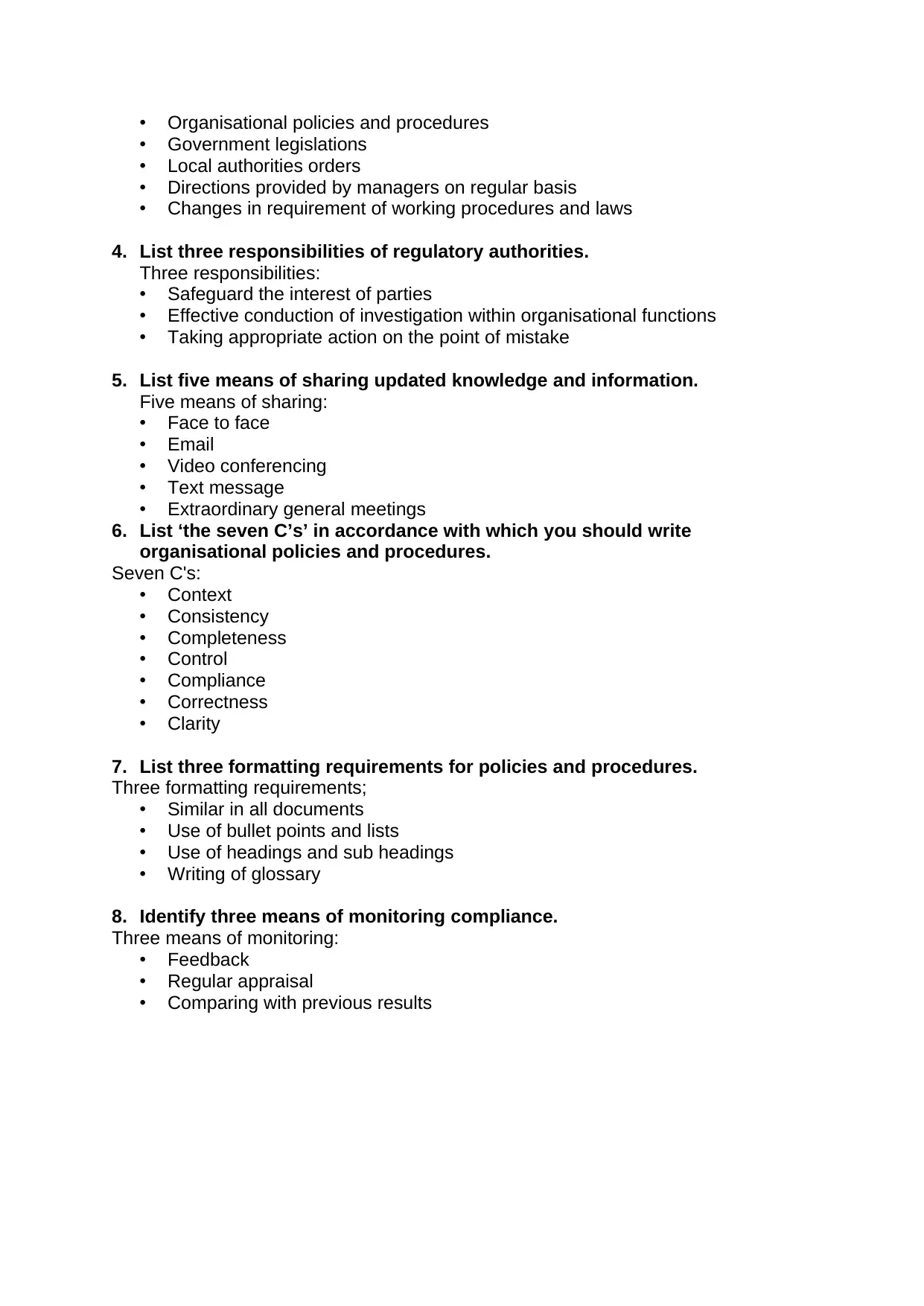
• Organisational policies and procedures
• Government legislations
• Local authorities orders
• Directions provided by managers on regular basis
• Changes in requirement of working procedures and laws
4. List three responsibilities of regulatory authorities.
Three responsibilities:
• Safeguard the interest of parties
• Effective conduction of investigation within organisational functions
• Taking appropriate action on the point of mistake
5. List five means of sharing updated knowledge and information.
Five means of sharing:
• Face to face
• Email
• Video conferencing
• Text message
• Extraordinary general meetings
6. List ‘the seven C’s’ in accordance with which you should write
organisational policies and procedures.
Seven C's:
• Context
• Consistency
• Completeness
• Control
• Compliance
• Correctness
• Clarity
7. List three formatting requirements for policies and procedures.
Three formatting requirements;
• Similar in all documents
• Use of bullet points and lists
• Use of headings and sub headings
• Writing of glossary
8. Identify three means of monitoring compliance.
Three means of monitoring:
• Feedback
• Regular appraisal
• Comparing with previous results
• Government legislations
• Local authorities orders
• Directions provided by managers on regular basis
• Changes in requirement of working procedures and laws
4. List three responsibilities of regulatory authorities.
Three responsibilities:
• Safeguard the interest of parties
• Effective conduction of investigation within organisational functions
• Taking appropriate action on the point of mistake
5. List five means of sharing updated knowledge and information.
Five means of sharing:
• Face to face
• Video conferencing
• Text message
• Extraordinary general meetings
6. List ‘the seven C’s’ in accordance with which you should write
organisational policies and procedures.
Seven C's:
• Context
• Consistency
• Completeness
• Control
• Compliance
• Correctness
• Clarity
7. List three formatting requirements for policies and procedures.
Three formatting requirements;
• Similar in all documents
• Use of bullet points and lists
• Use of headings and sub headings
• Writing of glossary
8. Identify three means of monitoring compliance.
Three means of monitoring:
• Feedback
• Regular appraisal
• Comparing with previous results
Paraphrase This Document
Need a fresh take? Get an instant paraphrase of this document with our AI Paraphraser
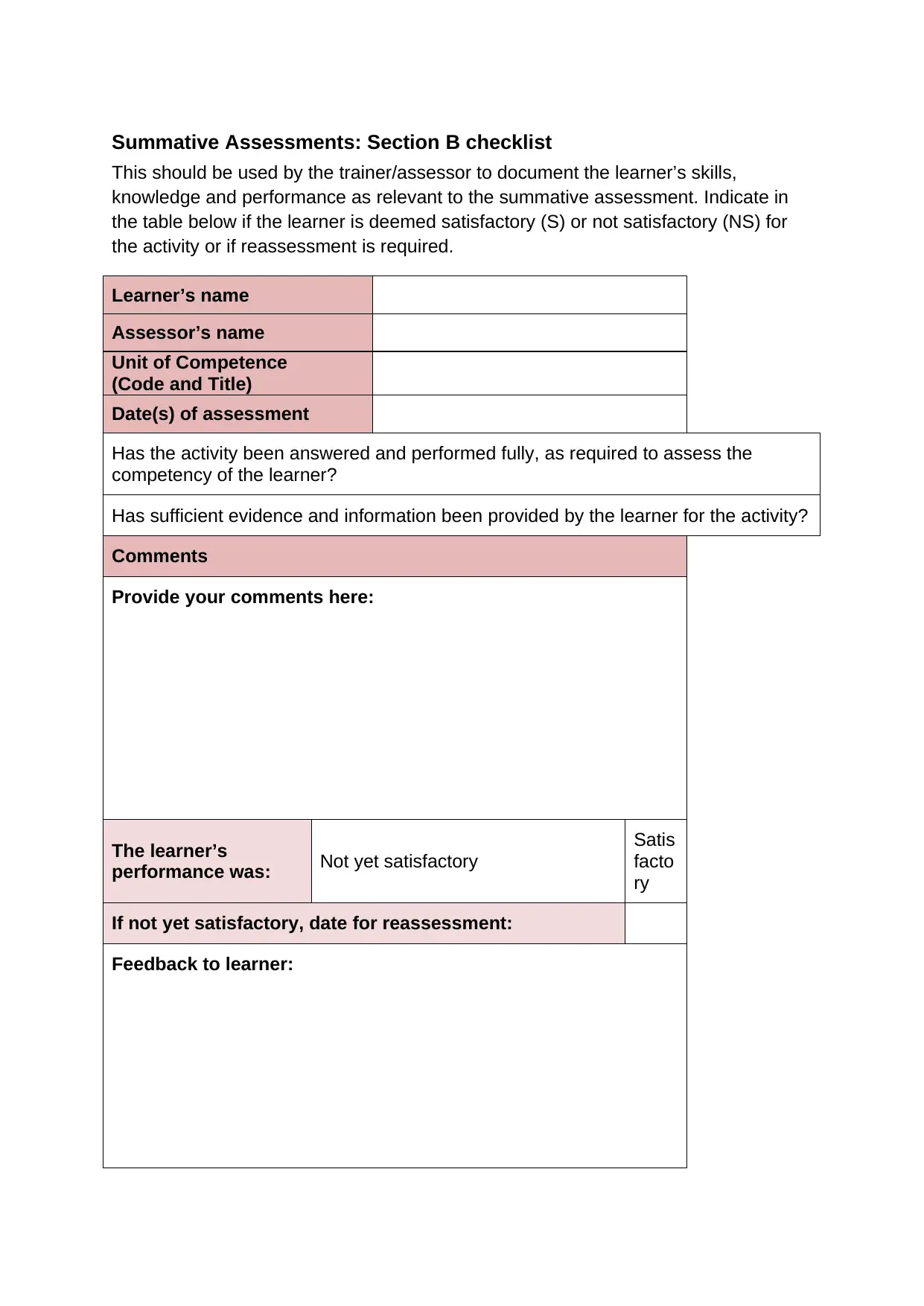
Summative Assessments: Section B checklist
This should be used by the trainer/assessor to document the learner’s skills,
knowledge and performance as relevant to the summative assessment. Indicate in
the table below if the learner is deemed satisfactory (S) or not satisfactory (NS) for
the activity or if reassessment is required.
Learner’s name
Assessor’s name
Unit of Competence
(Code and Title)
Date(s) of assessment
Has the activity been answered and performed fully, as required to assess the
competency of the learner?
Has sufficient evidence and information been provided by the learner for the activity?
Comments
Provide your comments here:
The learner’s
performance was: Not yet satisfactory
Satis
facto
ry
If not yet satisfactory, date for reassessment:
Feedback to learner:
This should be used by the trainer/assessor to document the learner’s skills,
knowledge and performance as relevant to the summative assessment. Indicate in
the table below if the learner is deemed satisfactory (S) or not satisfactory (NS) for
the activity or if reassessment is required.
Learner’s name
Assessor’s name
Unit of Competence
(Code and Title)
Date(s) of assessment
Has the activity been answered and performed fully, as required to assess the
competency of the learner?
Has sufficient evidence and information been provided by the learner for the activity?
Comments
Provide your comments here:
The learner’s
performance was: Not yet satisfactory
Satis
facto
ry
If not yet satisfactory, date for reassessment:
Feedback to learner:
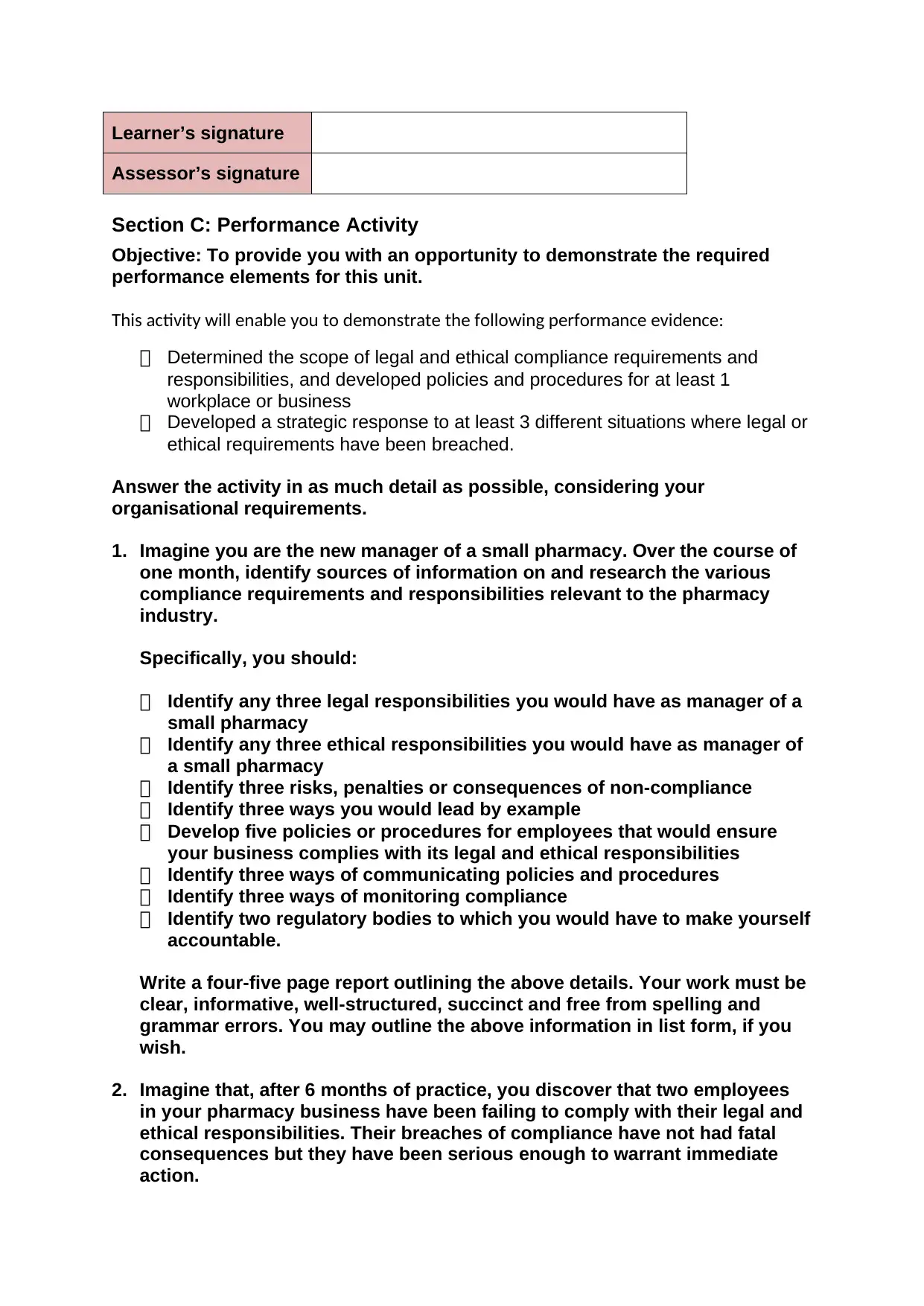
Learner’s signature
Assessor’s signature
Section C: Performance Activity
Objective: To provide you with an opportunity to demonstrate the required
performance elements for this unit.
This activity will enable you to demonstrate the following performance evidence:
Determined the scope of legal and ethical compliance requirements and
responsibilities, and developed policies and procedures for at least 1
workplace or business
Developed a strategic response to at least 3 different situations where legal or
ethical requirements have been breached.
Answer the activity in as much detail as possible, considering your
organisational requirements.
1. Imagine you are the new manager of a small pharmacy. Over the course of
one month, identify sources of information on and research the various
compliance requirements and responsibilities relevant to the pharmacy
industry.
Specifically, you should:
Identify any three legal responsibilities you would have as manager of a
small pharmacy
Identify any three ethical responsibilities you would have as manager of
a small pharmacy
Identify three risks, penalties or consequences of non-compliance
Identify three ways you would lead by example
Develop five policies or procedures for employees that would ensure
your business complies with its legal and ethical responsibilities
Identify three ways of communicating policies and procedures
Identify three ways of monitoring compliance
Identify two regulatory bodies to which you would have to make yourself
accountable.
Write a four-five page report outlining the above details. Your work must be
clear, informative, well-structured, succinct and free from spelling and
grammar errors. You may outline the above information in list form, if you
wish.
2. Imagine that, after 6 months of practice, you discover that two employees
in your pharmacy business have been failing to comply with their legal and
ethical responsibilities. Their breaches of compliance have not had fatal
consequences but they have been serious enough to warrant immediate
action.
Assessor’s signature
Section C: Performance Activity
Objective: To provide you with an opportunity to demonstrate the required
performance elements for this unit.
This activity will enable you to demonstrate the following performance evidence:
Determined the scope of legal and ethical compliance requirements and
responsibilities, and developed policies and procedures for at least 1
workplace or business
Developed a strategic response to at least 3 different situations where legal or
ethical requirements have been breached.
Answer the activity in as much detail as possible, considering your
organisational requirements.
1. Imagine you are the new manager of a small pharmacy. Over the course of
one month, identify sources of information on and research the various
compliance requirements and responsibilities relevant to the pharmacy
industry.
Specifically, you should:
Identify any three legal responsibilities you would have as manager of a
small pharmacy
Identify any three ethical responsibilities you would have as manager of
a small pharmacy
Identify three risks, penalties or consequences of non-compliance
Identify three ways you would lead by example
Develop five policies or procedures for employees that would ensure
your business complies with its legal and ethical responsibilities
Identify three ways of communicating policies and procedures
Identify three ways of monitoring compliance
Identify two regulatory bodies to which you would have to make yourself
accountable.
Write a four-five page report outlining the above details. Your work must be
clear, informative, well-structured, succinct and free from spelling and
grammar errors. You may outline the above information in list form, if you
wish.
2. Imagine that, after 6 months of practice, you discover that two employees
in your pharmacy business have been failing to comply with their legal and
ethical responsibilities. Their breaches of compliance have not had fatal
consequences but they have been serious enough to warrant immediate
action.
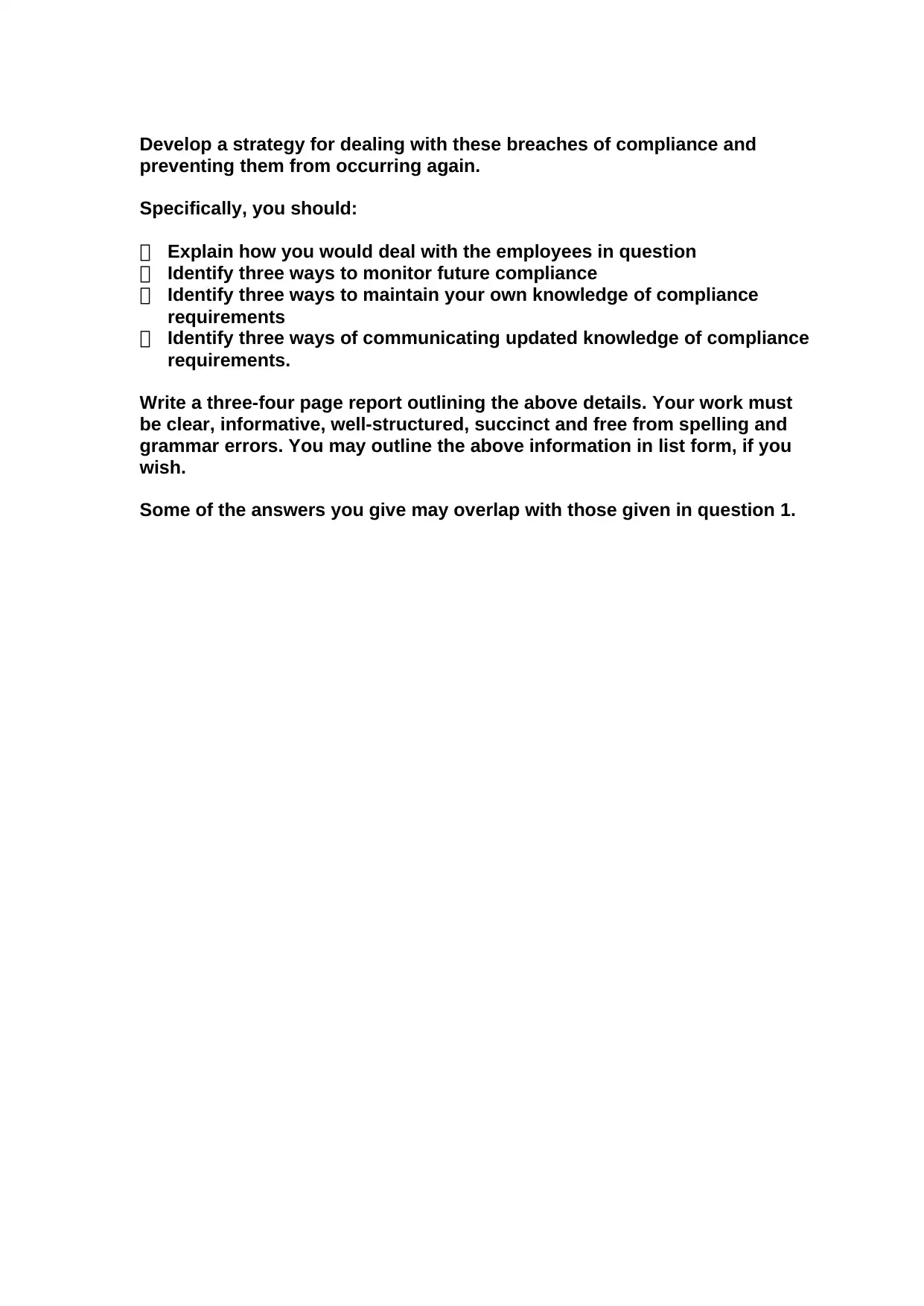
Develop a strategy for dealing with these breaches of compliance and
preventing them from occurring again.
Specifically, you should:
Explain how you would deal with the employees in question
Identify three ways to monitor future compliance
Identify three ways to maintain your own knowledge of compliance
requirements
Identify three ways of communicating updated knowledge of compliance
requirements.
Write a three-four page report outlining the above details. Your work must
be clear, informative, well-structured, succinct and free from spelling and
grammar errors. You may outline the above information in list form, if you
wish.
Some of the answers you give may overlap with those given in question 1.
preventing them from occurring again.
Specifically, you should:
Explain how you would deal with the employees in question
Identify three ways to monitor future compliance
Identify three ways to maintain your own knowledge of compliance
requirements
Identify three ways of communicating updated knowledge of compliance
requirements.
Write a three-four page report outlining the above details. Your work must
be clear, informative, well-structured, succinct and free from spelling and
grammar errors. You may outline the above information in list form, if you
wish.
Some of the answers you give may overlap with those given in question 1.
Secure Best Marks with AI Grader
Need help grading? Try our AI Grader for instant feedback on your assignments.

Summative Assessments: Section C checklist
This should be used by the trainer/assessor to document the learner’s skills,
knowledge and performance as relevant to the summative assessment. Indicate in
the table below if the learner is deemed satisfactory (S) or not satisfactory (NS) for
the activity or if reassessment is required.
Learner’s name
Assessor’s name
Unit of Competence
(Code and Title)
Date(s) of assessment
Has the activity been answered and performed fully, as required to assess the
competency of the learner?
Has sufficient evidence and information been provided by the learner for the activity?
Comments
Provide your comments here:
The learner’s
performance was: Not yet satisfactory
Satis
facto
ry
If not yet satisfactory, date for reassessment:
Feedback to learner:
This should be used by the trainer/assessor to document the learner’s skills,
knowledge and performance as relevant to the summative assessment. Indicate in
the table below if the learner is deemed satisfactory (S) or not satisfactory (NS) for
the activity or if reassessment is required.
Learner’s name
Assessor’s name
Unit of Competence
(Code and Title)
Date(s) of assessment
Has the activity been answered and performed fully, as required to assess the
competency of the learner?
Has sufficient evidence and information been provided by the learner for the activity?
Comments
Provide your comments here:
The learner’s
performance was: Not yet satisfactory
Satis
facto
ry
If not yet satisfactory, date for reassessment:
Feedback to learner:
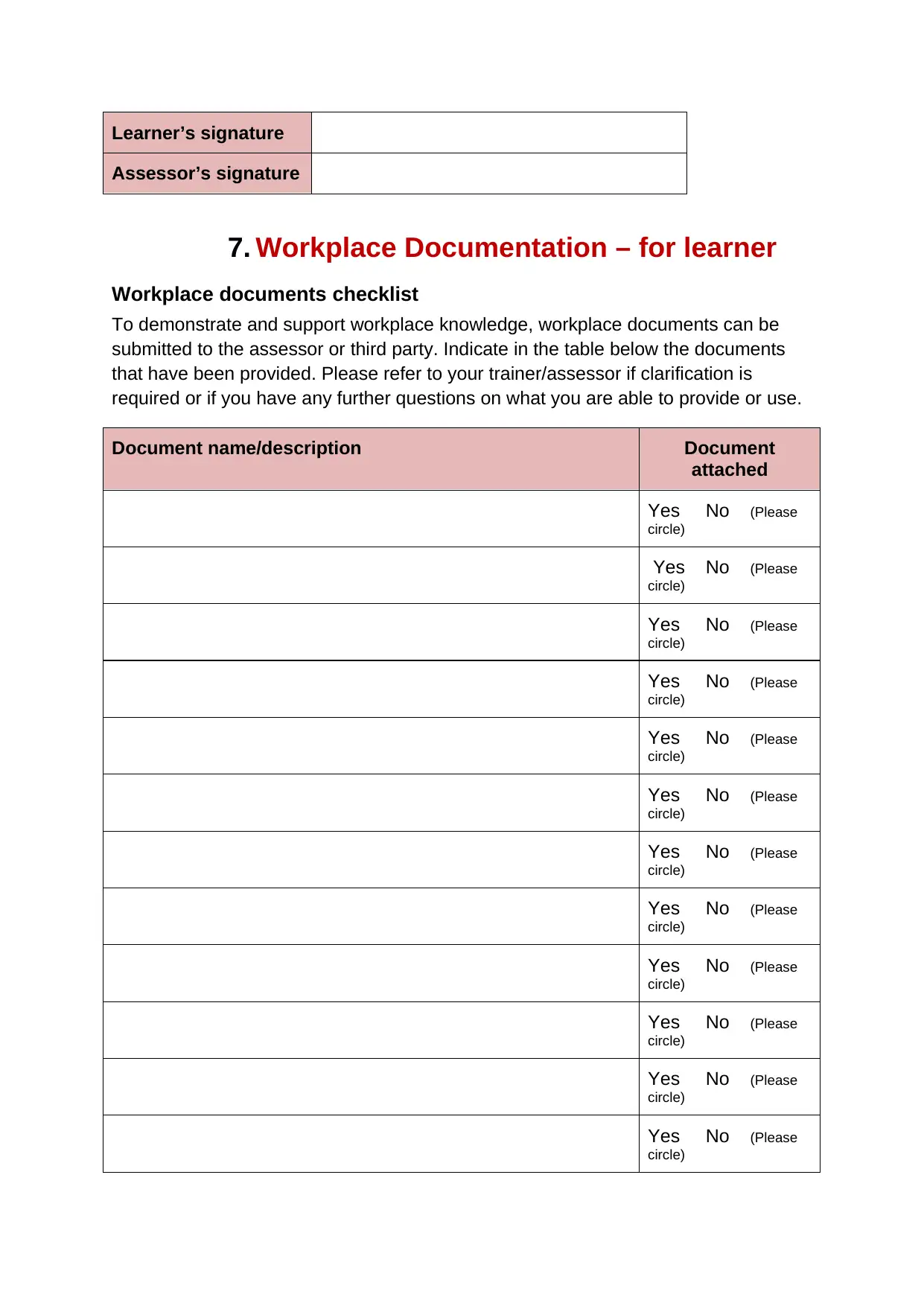
Learner’s signature
Assessor’s signature
7. Workplace Documentation – for learner
Workplace documents checklist
To demonstrate and support workplace knowledge, workplace documents can be
submitted to the assessor or third party. Indicate in the table below the documents
that have been provided. Please refer to your trainer/assessor if clarification is
required or if you have any further questions on what you are able to provide or use.
Document name/description Document
attached
Yes No (Please
circle)
Yes No (Please
circle)
Yes No (Please
circle)
Yes No (Please
circle)
Yes No (Please
circle)
Yes No (Please
circle)
Yes No (Please
circle)
Yes No (Please
circle)
Yes No (Please
circle)
Yes No (Please
circle)
Yes No (Please
circle)
Yes No (Please
circle)
Assessor’s signature
7. Workplace Documentation – for learner
Workplace documents checklist
To demonstrate and support workplace knowledge, workplace documents can be
submitted to the assessor or third party. Indicate in the table below the documents
that have been provided. Please refer to your trainer/assessor if clarification is
required or if you have any further questions on what you are able to provide or use.
Document name/description Document
attached
Yes No (Please
circle)
Yes No (Please
circle)
Yes No (Please
circle)
Yes No (Please
circle)
Yes No (Please
circle)
Yes No (Please
circle)
Yes No (Please
circle)
Yes No (Please
circle)
Yes No (Please
circle)
Yes No (Please
circle)
Yes No (Please
circle)
Yes No (Please
circle)
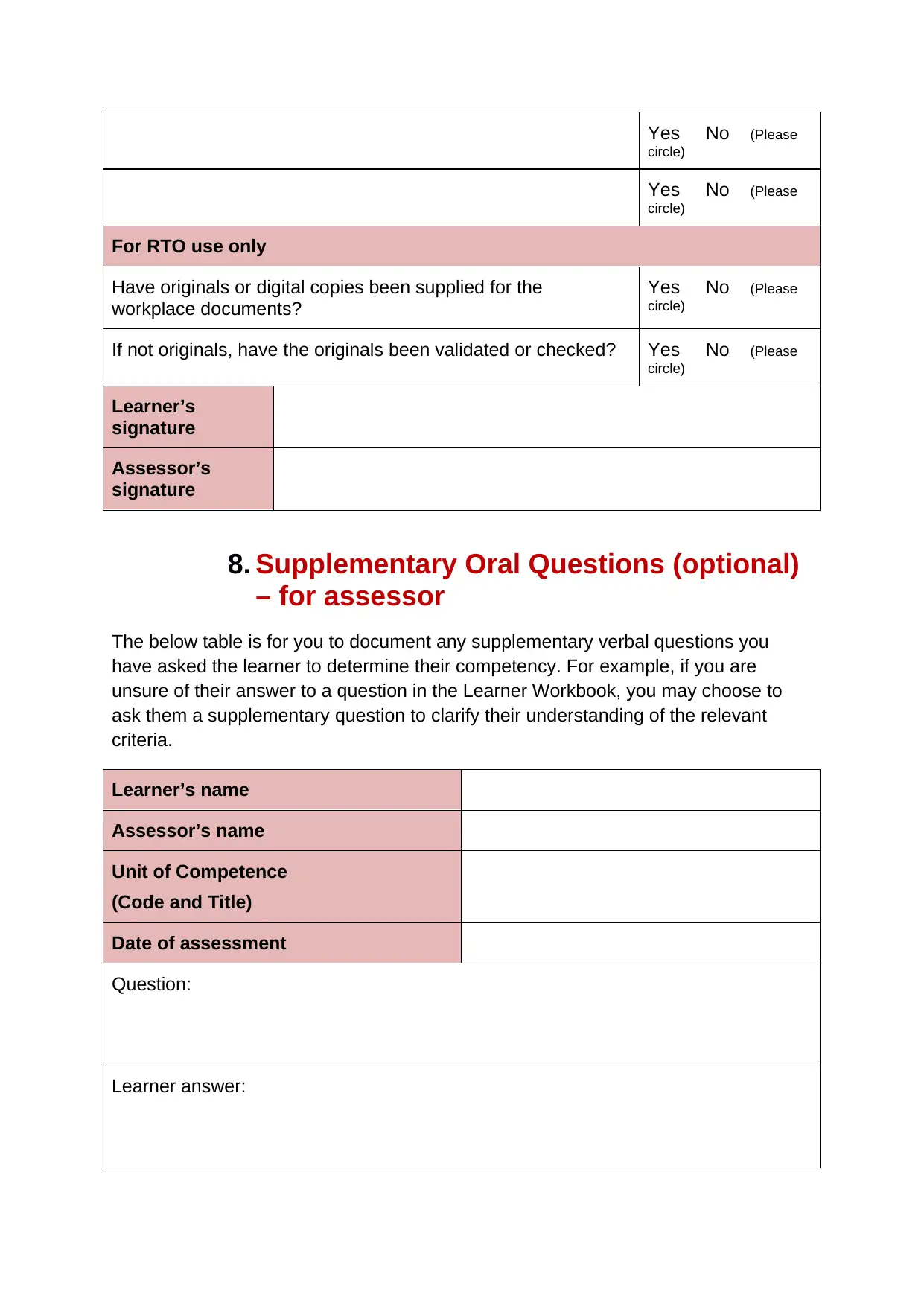
Yes No (Please
circle)
Yes No (Please
circle)
For RTO use only
Have originals or digital copies been supplied for the
workplace documents?
Yes No (Please
circle)
If not originals, have the originals been validated or checked? Yes No (Please
circle)
Learner’s
signature
Assessor’s
signature
8. Supplementary Oral Questions (optional)
– for assessor
The below table is for you to document any supplementary verbal questions you
have asked the learner to determine their competency. For example, if you are
unsure of their answer to a question in the Learner Workbook, you may choose to
ask them a supplementary question to clarify their understanding of the relevant
criteria.
Learner’s name
Assessor’s name
Unit of Competence
(Code and Title)
Date of assessment
Question:
Learner answer:
circle)
Yes No (Please
circle)
For RTO use only
Have originals or digital copies been supplied for the
workplace documents?
Yes No (Please
circle)
If not originals, have the originals been validated or checked? Yes No (Please
circle)
Learner’s
signature
Assessor’s
signature
8. Supplementary Oral Questions (optional)
– for assessor
The below table is for you to document any supplementary verbal questions you
have asked the learner to determine their competency. For example, if you are
unsure of their answer to a question in the Learner Workbook, you may choose to
ask them a supplementary question to clarify their understanding of the relevant
criteria.
Learner’s name
Assessor’s name
Unit of Competence
(Code and Title)
Date of assessment
Question:
Learner answer:
Paraphrase This Document
Need a fresh take? Get an instant paraphrase of this document with our AI Paraphraser
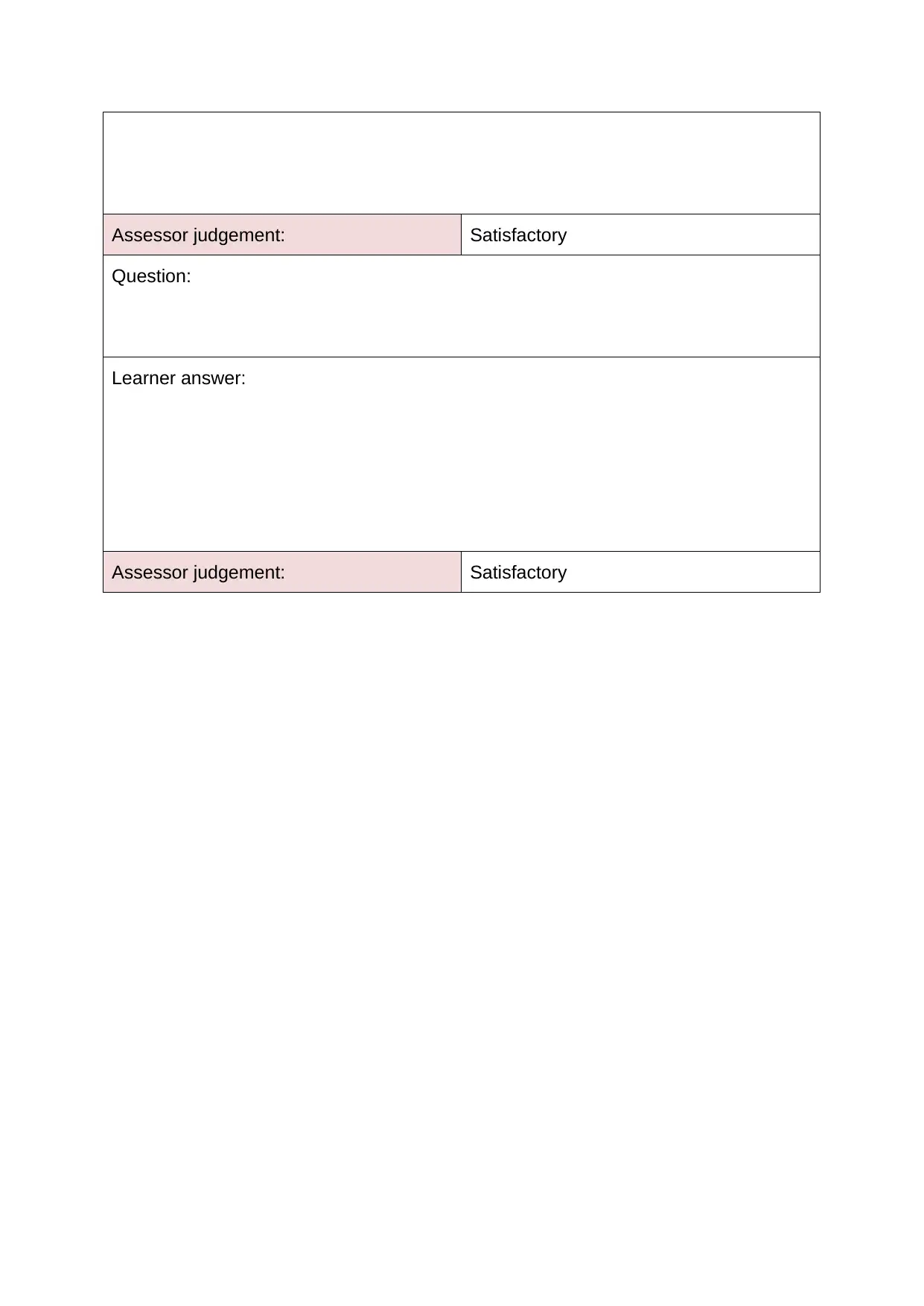
Assessor judgement: Satisfactory
Question:
Learner answer:
Assessor judgement: Satisfactory
Question:
Learner answer:
Assessor judgement: Satisfactory
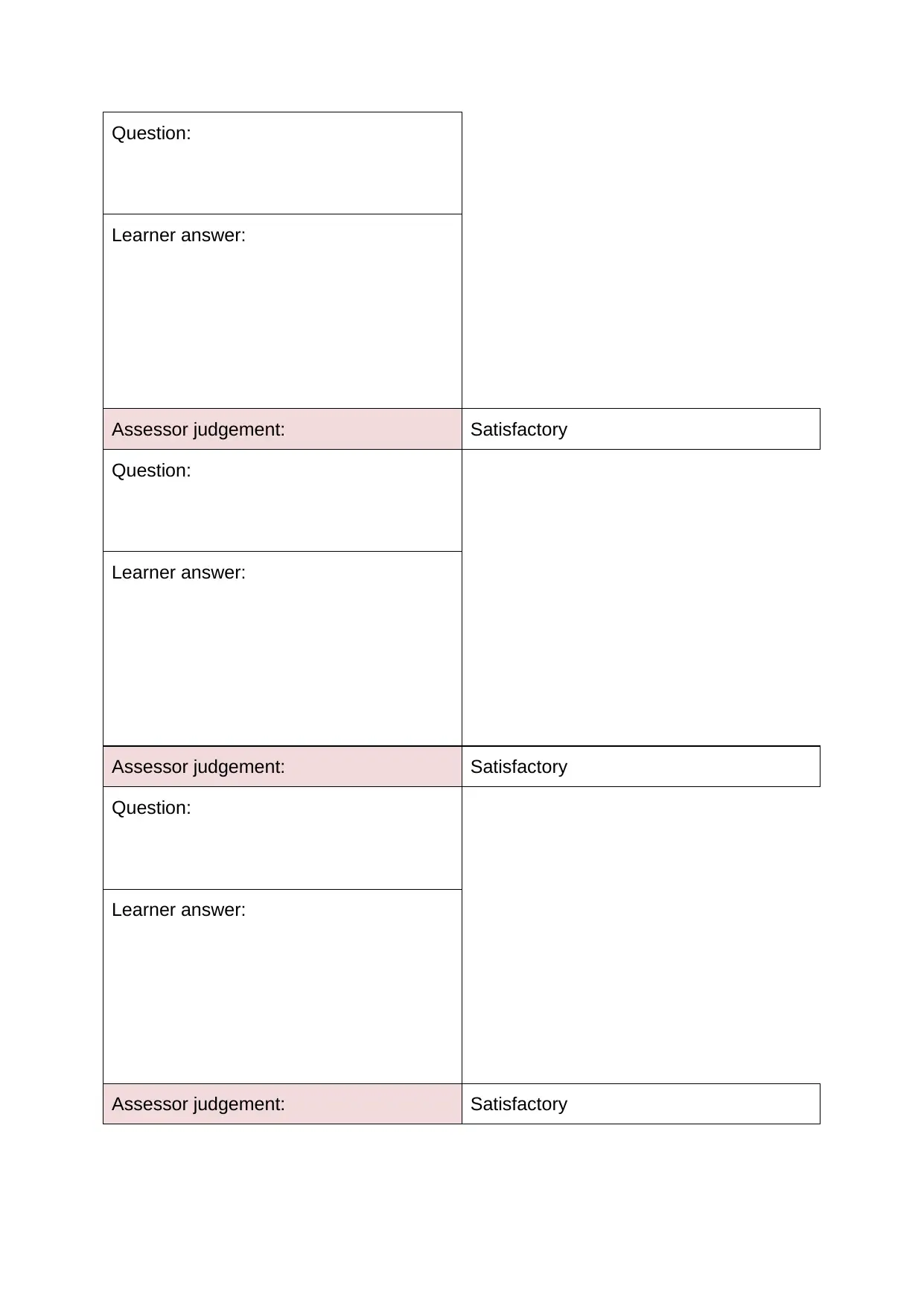
Question:
Learner answer:
Assessor judgement: Satisfactory
Question:
Learner answer:
Assessor judgement: Satisfactory
Question:
Learner answer:
Assessor judgement: Satisfactory
Learner answer:
Assessor judgement: Satisfactory
Question:
Learner answer:
Assessor judgement: Satisfactory
Question:
Learner answer:
Assessor judgement: Satisfactory
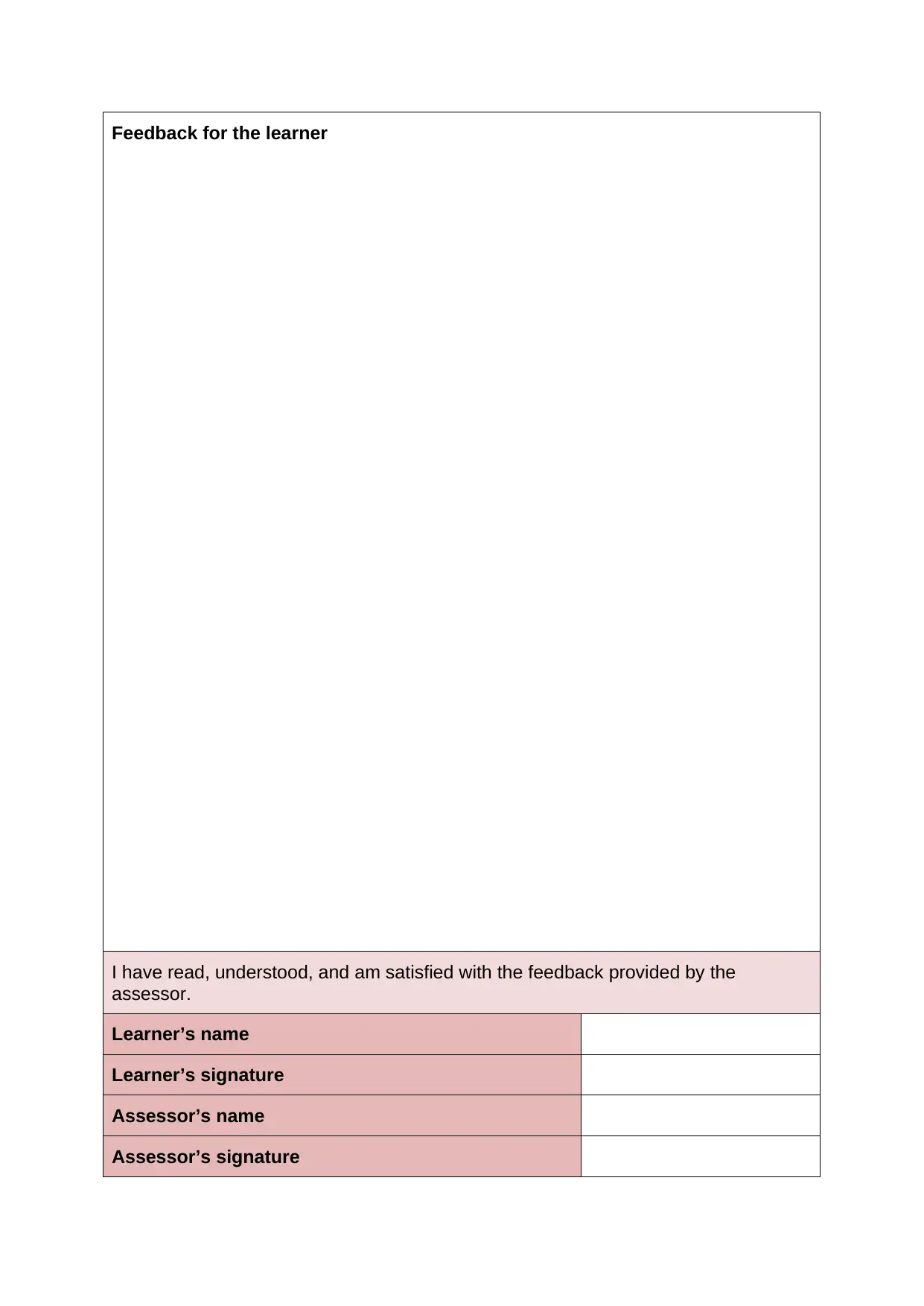
Feedback for the learner
I have read, understood, and am satisfied with the feedback provided by the
assessor.
Learner’s name
Learner’s signature
Assessor’s name
Assessor’s signature
I have read, understood, and am satisfied with the feedback provided by the
assessor.
Learner’s name
Learner’s signature
Assessor’s name
Assessor’s signature
Secure Best Marks with AI Grader
Need help grading? Try our AI Grader for instant feedback on your assignments.

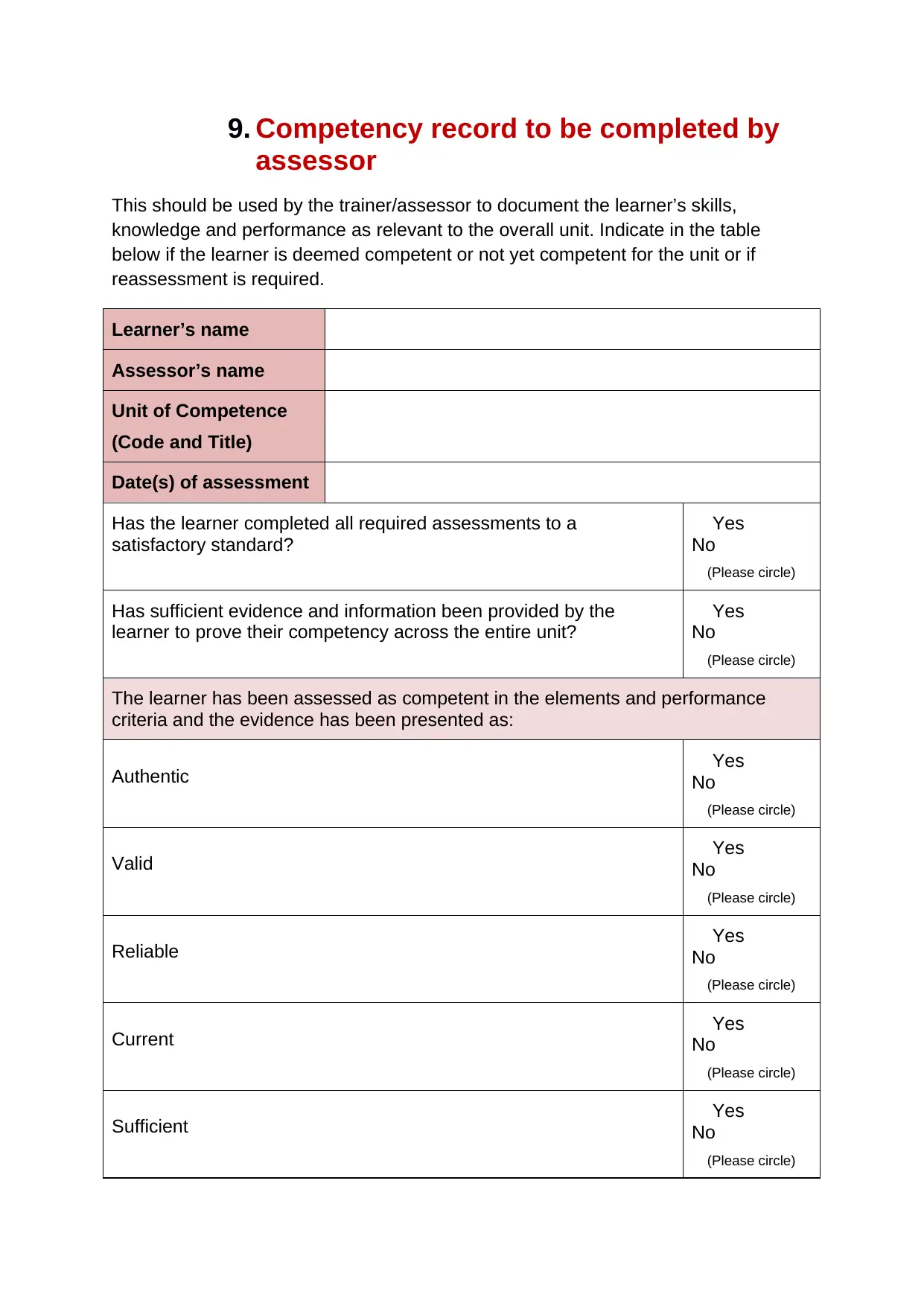
9. Competency record to be completed by
assessor
This should be used by the trainer/assessor to document the learner’s skills,
knowledge and performance as relevant to the overall unit. Indicate in the table
below if the learner is deemed competent or not yet competent for the unit or if
reassessment is required.
Learner’s name
Assessor’s name
Unit of Competence
(Code and Title)
Date(s) of assessment
Has the learner completed all required assessments to a
satisfactory standard?
Yes
No
(Please circle)
Has sufficient evidence and information been provided by the
learner to prove their competency across the entire unit?
Yes
No
(Please circle)
The learner has been assessed as competent in the elements and performance
criteria and the evidence has been presented as:
Authentic Yes
No
(Please circle)
Valid Yes
No
(Please circle)
Reliable Yes
No
(Please circle)
Current Yes
No
(Please circle)
Sufficient Yes
No
(Please circle)
assessor
This should be used by the trainer/assessor to document the learner’s skills,
knowledge and performance as relevant to the overall unit. Indicate in the table
below if the learner is deemed competent or not yet competent for the unit or if
reassessment is required.
Learner’s name
Assessor’s name
Unit of Competence
(Code and Title)
Date(s) of assessment
Has the learner completed all required assessments to a
satisfactory standard?
Yes
No
(Please circle)
Has sufficient evidence and information been provided by the
learner to prove their competency across the entire unit?
Yes
No
(Please circle)
The learner has been assessed as competent in the elements and performance
criteria and the evidence has been presented as:
Authentic Yes
No
(Please circle)
Valid Yes
No
(Please circle)
Reliable Yes
No
(Please circle)
Current Yes
No
(Please circle)
Sufficient Yes
No
(Please circle)

Paraphrase This Document
Need a fresh take? Get an instant paraphrase of this document with our AI Paraphraser
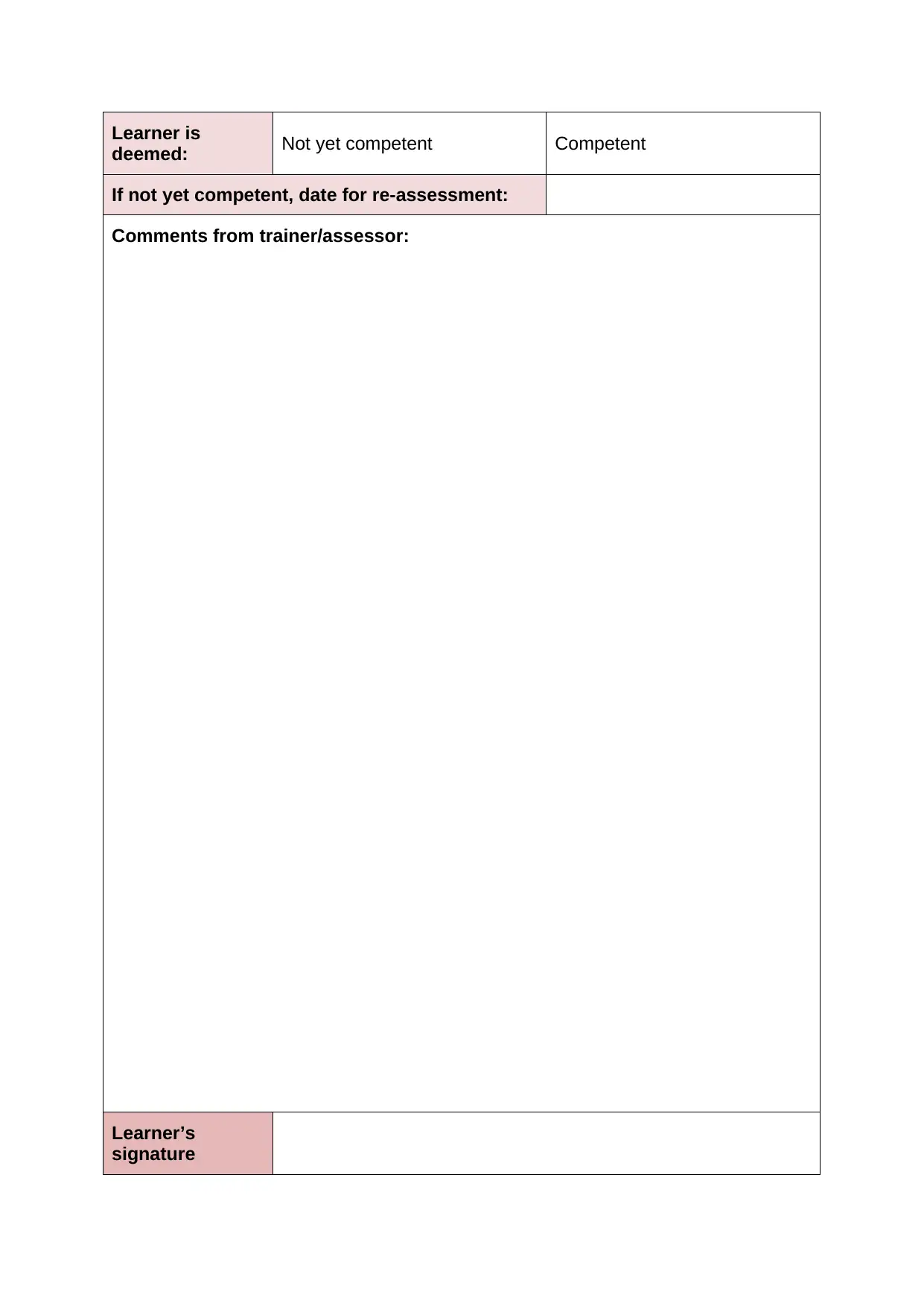
Learner is
deemed: Not yet competent Competent
If not yet competent, date for re-assessment:
Comments from trainer/assessor:
Learner’s
signature
deemed: Not yet competent Competent
If not yet competent, date for re-assessment:
Comments from trainer/assessor:
Learner’s
signature

Assessor’s
signature
signature
1 out of 75
Related Documents
Your All-in-One AI-Powered Toolkit for Academic Success.
+13062052269
info@desklib.com
Available 24*7 on WhatsApp / Email
![[object Object]](/_next/static/media/star-bottom.7253800d.svg)
Unlock your academic potential
© 2024 | Zucol Services PVT LTD | All rights reserved.





